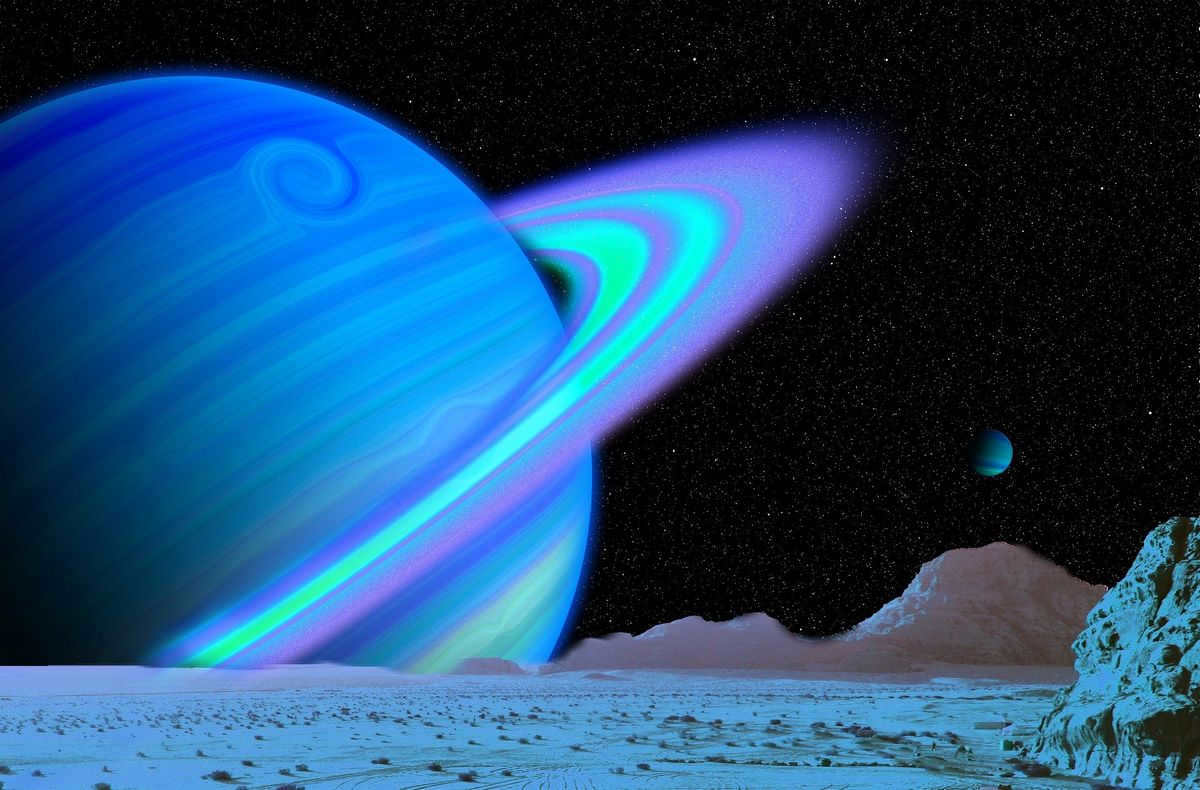
Every individual residing on our planet, regardless of the monotonous nature of their daily existence, will, unexpectedly and even to their own surprise, find themselves gazing upwards. This phenomenon can be attributed to an insatiable curiosity towards the unknown and inexplicable. It is as if the vast expanse of the deep, dark cosmos, adorned with twinkling celestial bodies, holds the promise of unveiling something novel and unique to each observer.
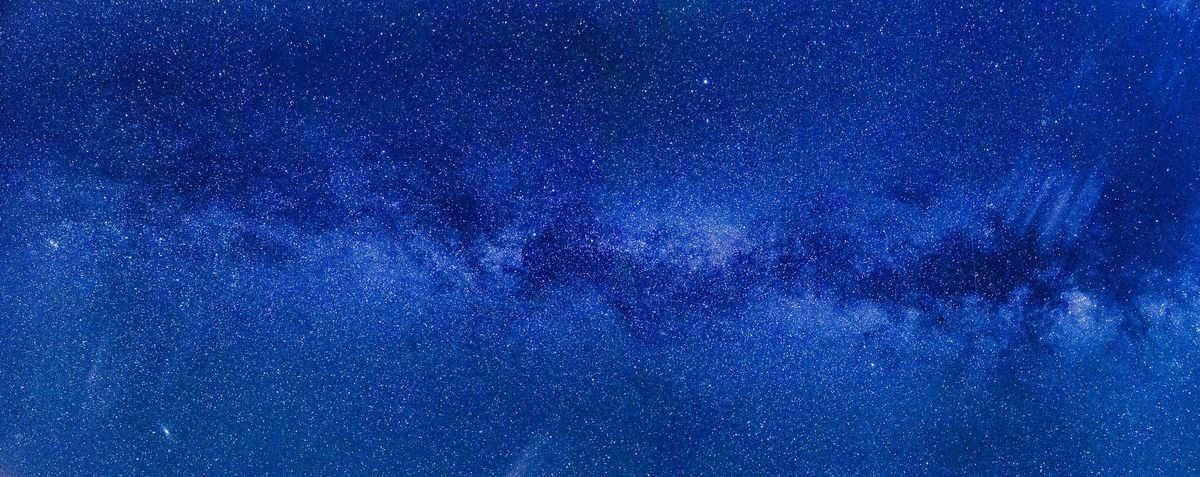
The exploration of satellites
The mysteries of the cosmos have captivated humanity since the beginning of time. Driven by curiosity and a desire to understand the origins of the universe, we have formulated one of the most widely accepted hypotheses – the Big Bang theory. However, for those who truly grasp its implications, the question remains: what existed prior to this monumental event? The late Stephen Hawking, in his renowned works, posited that there was a state of nothingness preceding the cosmic explosion.
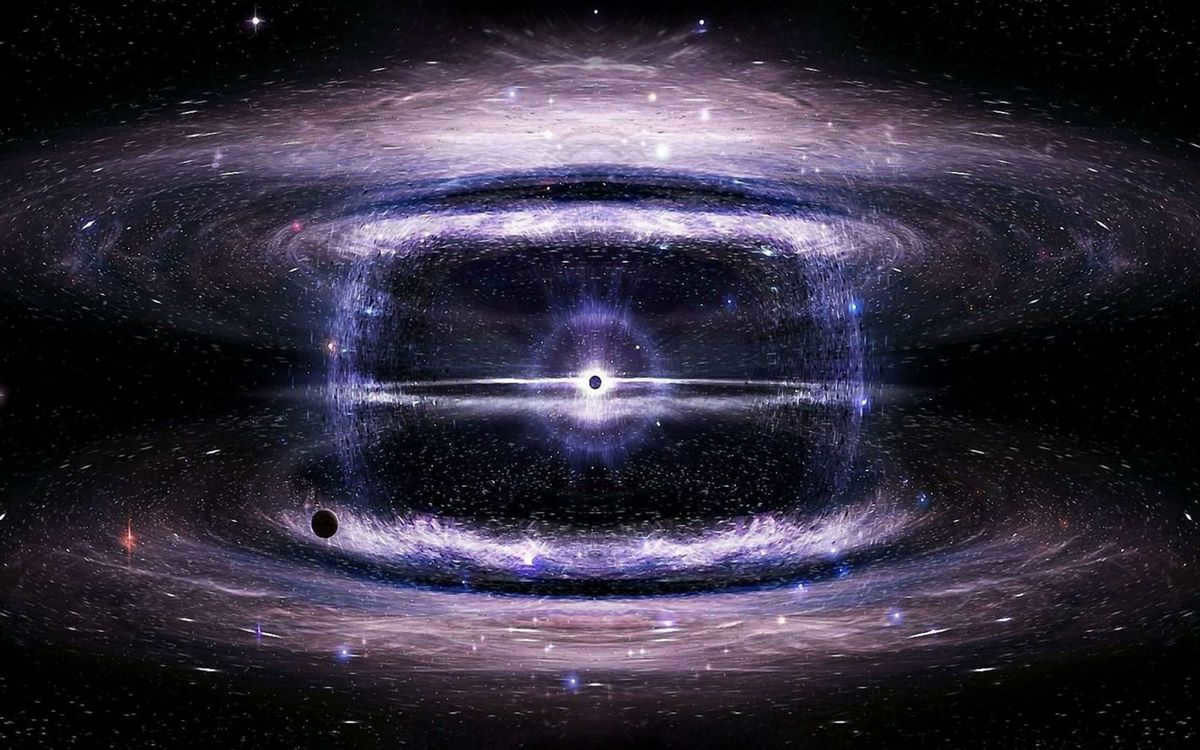
Throughout history, humans have observed the intricate movements of bright objects in the sky. Over time, they learned to distinguish between planets and stars. Thanks to the advancements in ancient Greek astronomy, we now understand that the Earth is a sphere with the Sun at its center. Additionally, we know that there are five known planets, including Saturn, Jupiter, Mars, Venus, and Mercury, which orbit around the Sun.
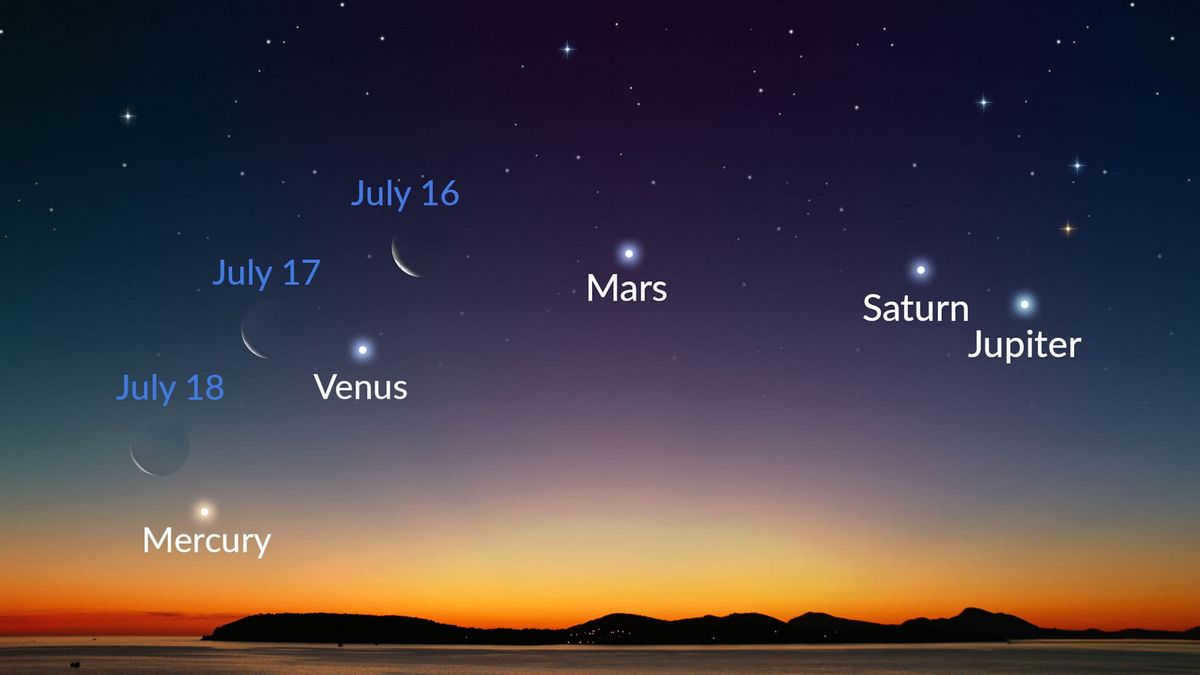
The era of cosmic exploration commenced following the invention of the telescope by Galileo Galilei. This groundbreaking invention allowed for the discovery of various celestial phenomena, such as the mountains on the Moon and the Sun’s spots. Additionally, Galileo Galilei was able to identify the first four satellites of Jupiter in 1610. During this time, Galileo Galilei also observed distinctive features surrounding Saturn, which were later termed as its rings by Christian Huygens in 1655. Subsequently, Christian Huygens discovered Saturn’s first satellite. In 1671, Giovanni Cassini made significant contributions to our understanding of Saturn’s satellites by discovering Dione, Rhea, Japetus, and Tephia. William Herschel observed Enceladus and Mimas in 1789, while Hyperion and Theba were respectively identified in 1848 and 1899.
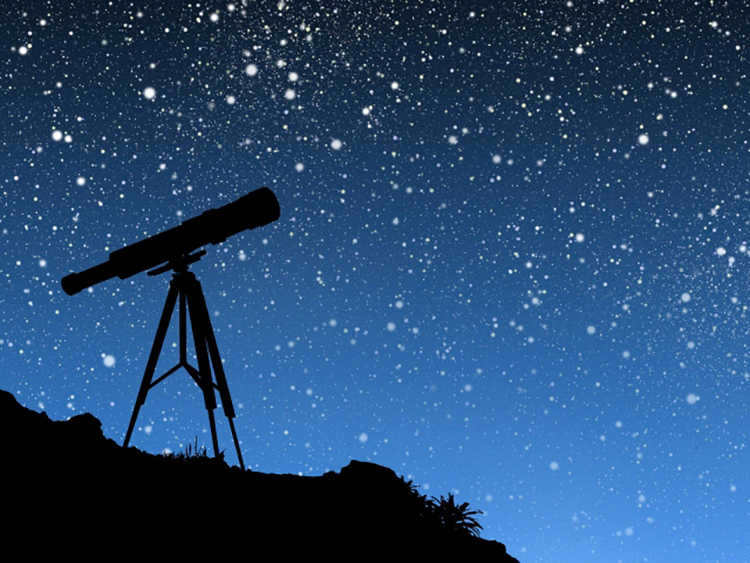

Saturn’s Moons: Count and Nomenclature
The Cassini-Huygens mission, launched in 1997 as part of the Cassini-Huygens program, aimed to investigate Saturn’s rings and moons. On September 15, 2017, the Cassini spacecraft met its fiery demise in Saturn’s atmosphere, a fitting end to its remarkable journey. When the mission began, Saturn was known to have 18 moons. By the time Cassini arrived in Saturn’s orbit, that number had increased to 62, although only 53 of them have been officially named.
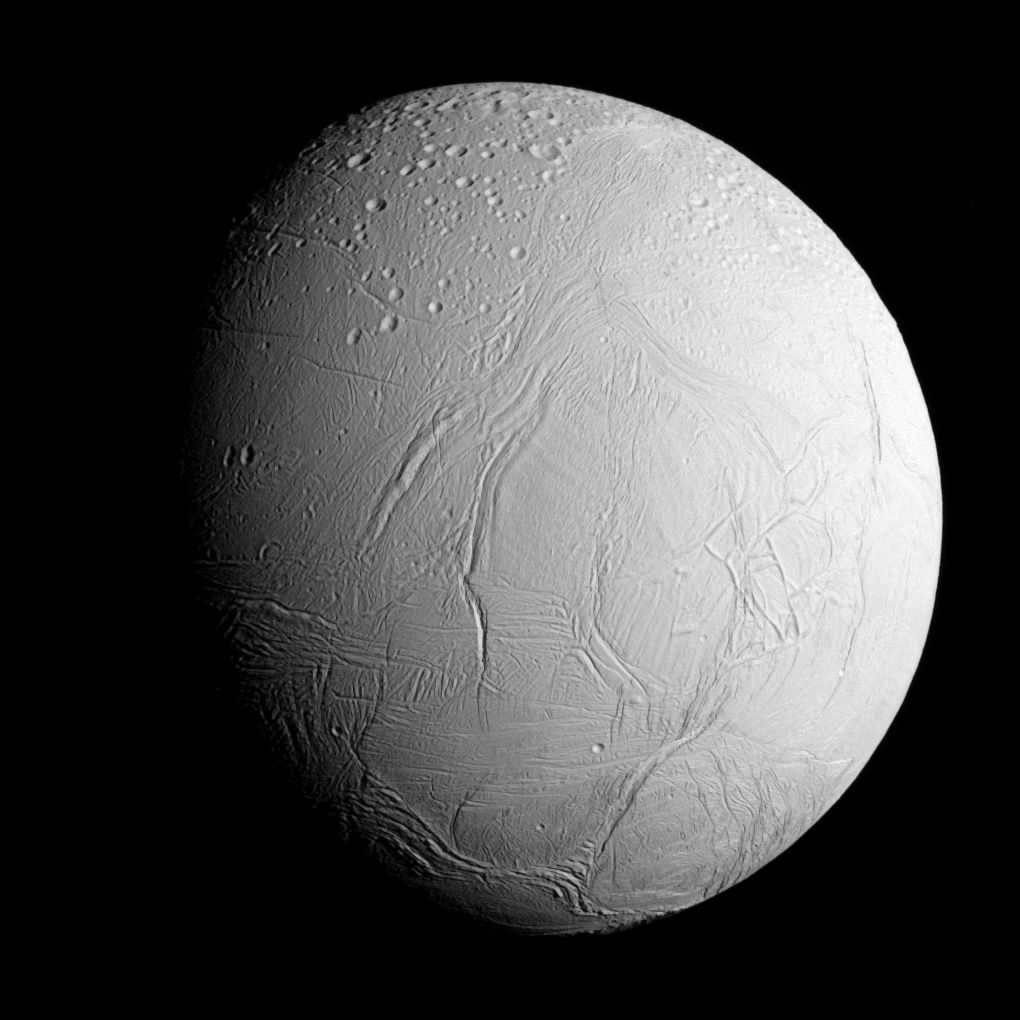
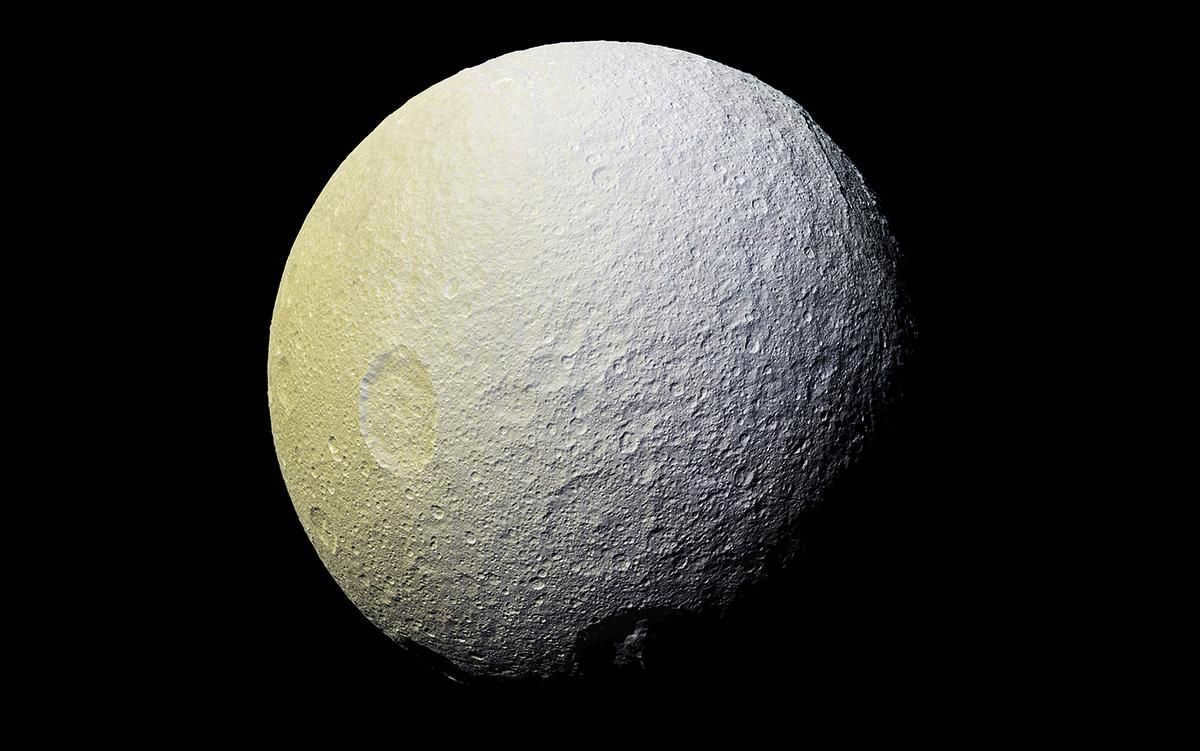
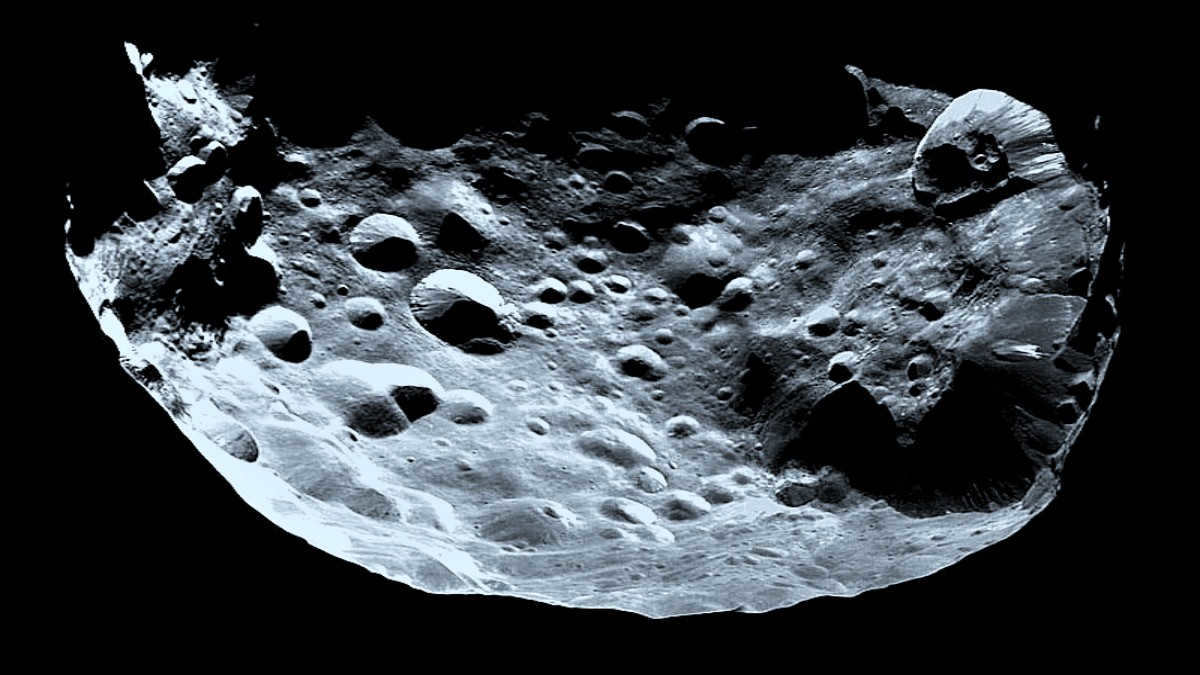
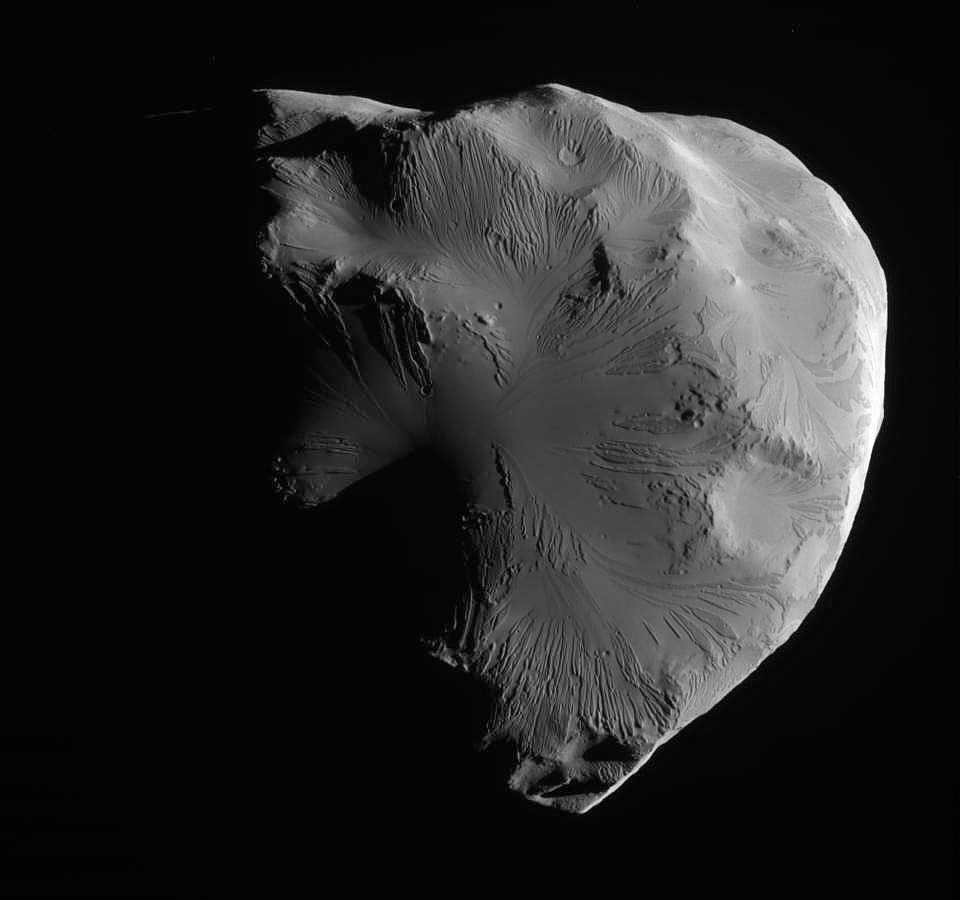
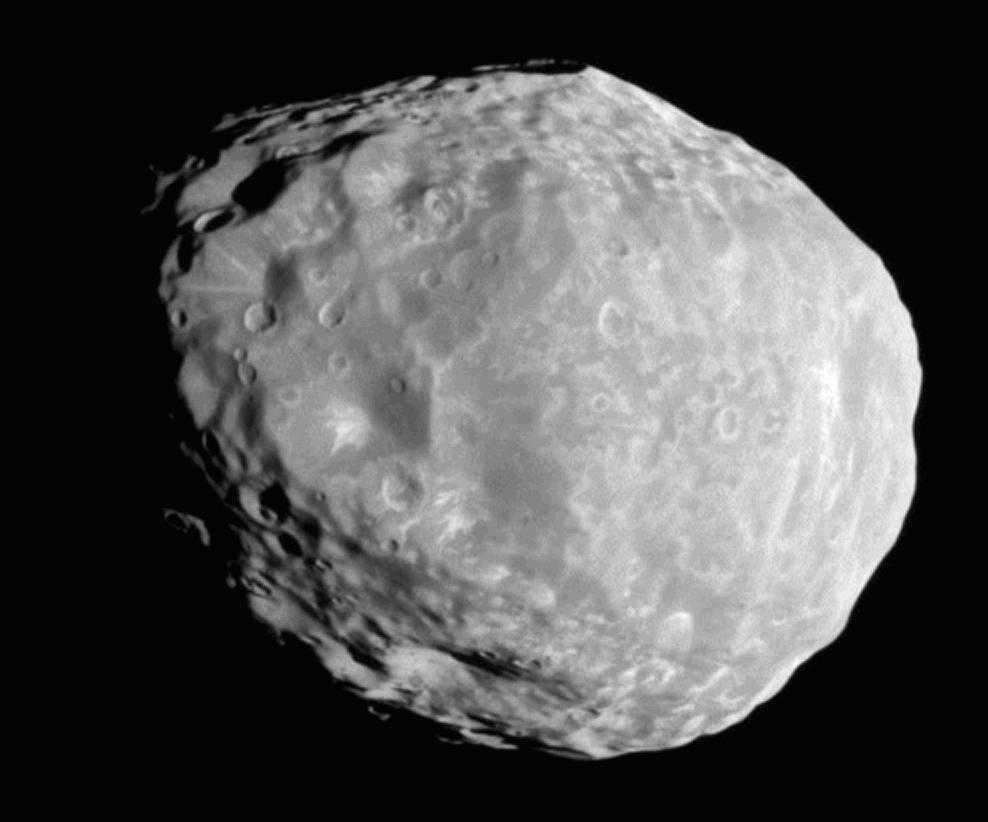
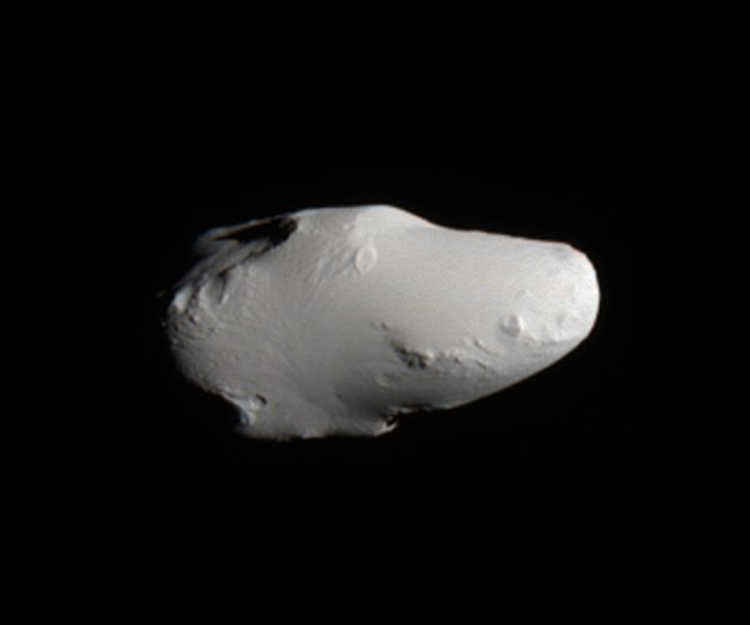
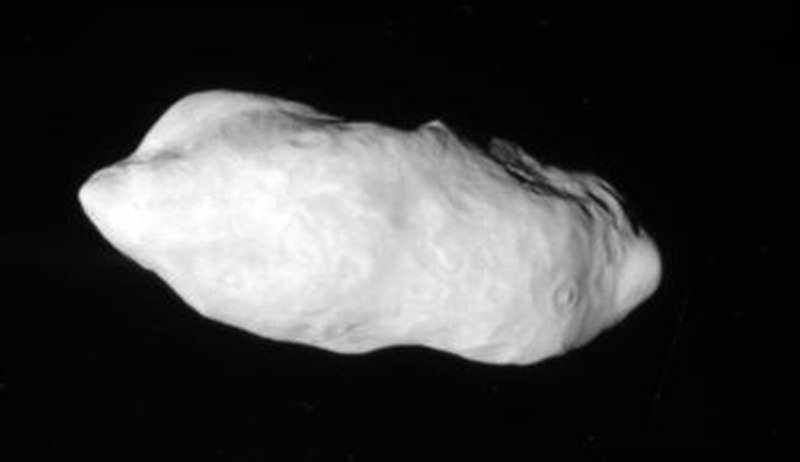
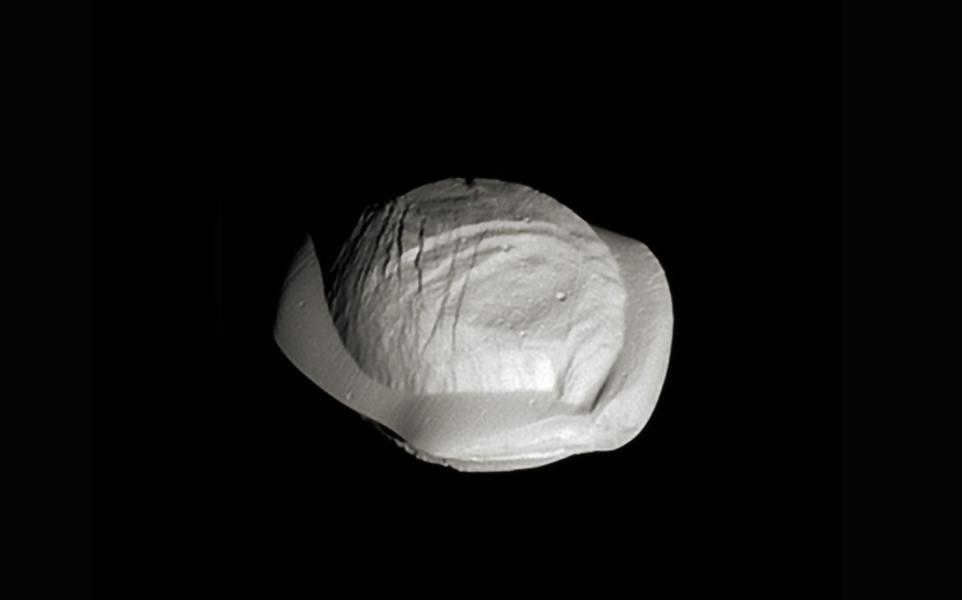
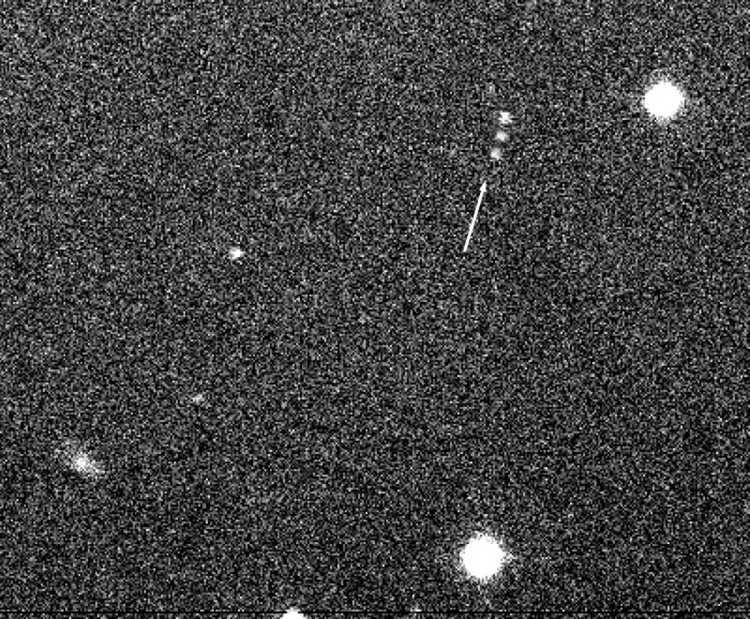
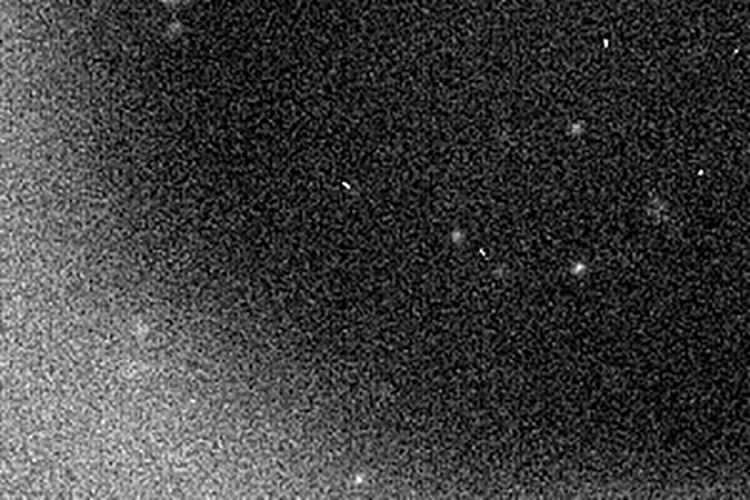
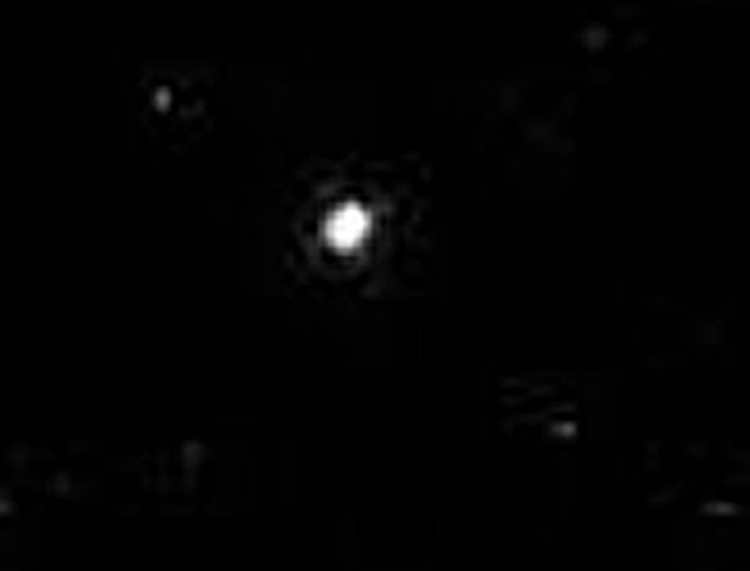
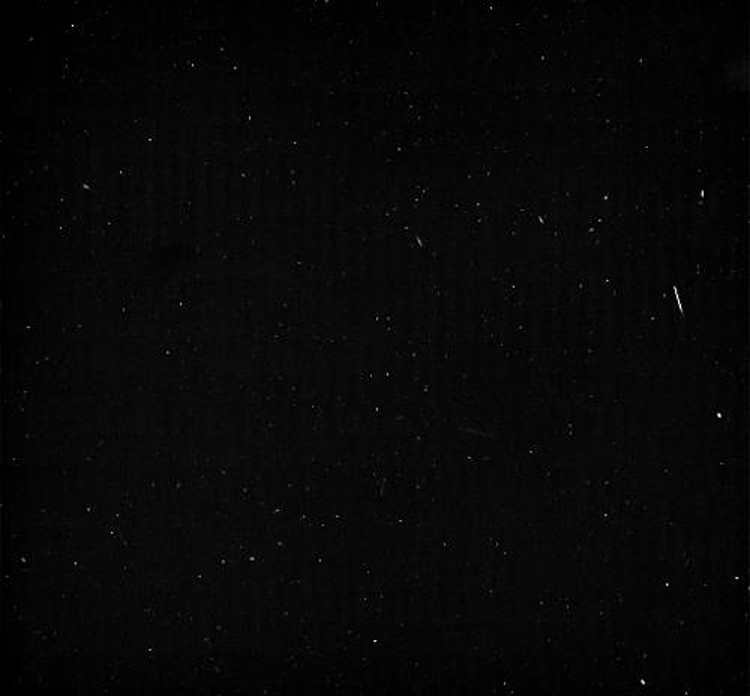
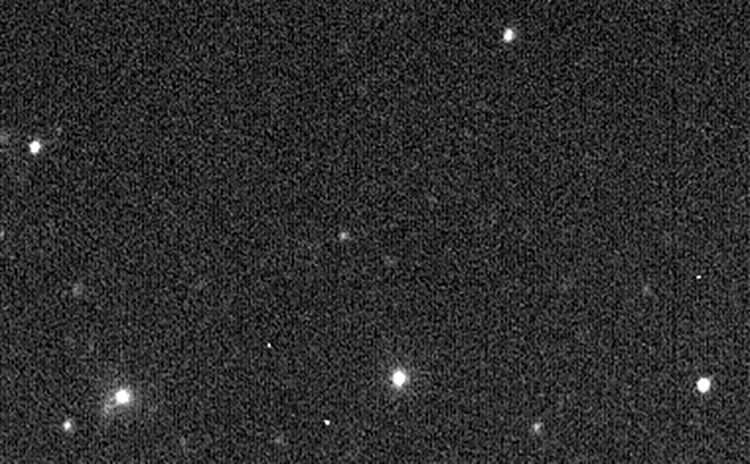
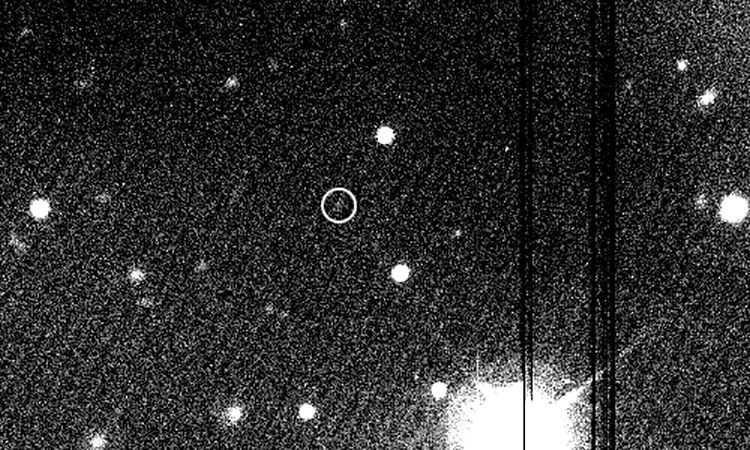
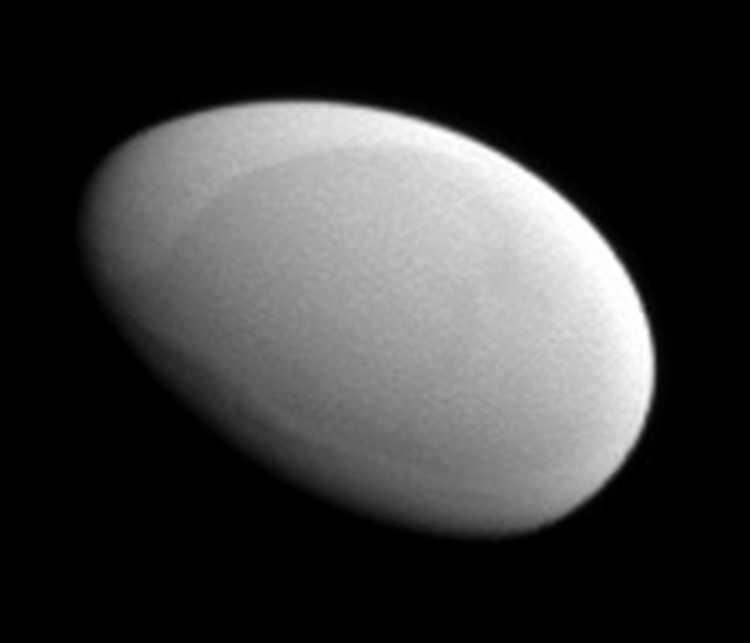
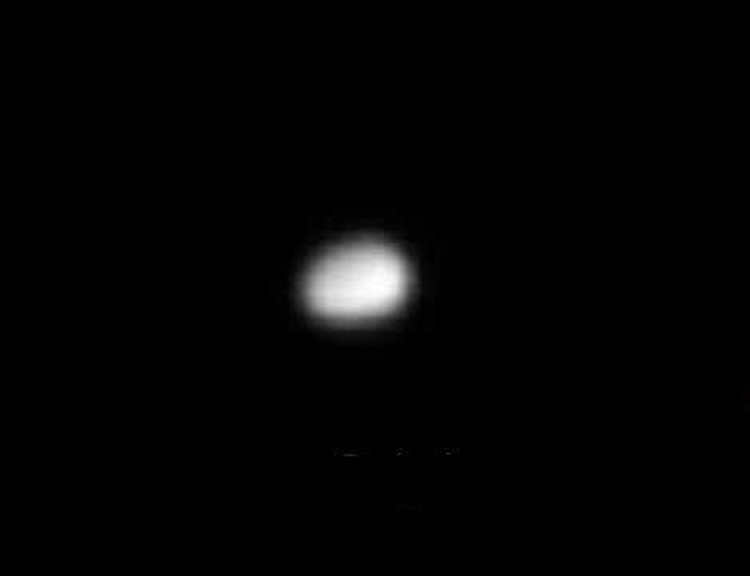
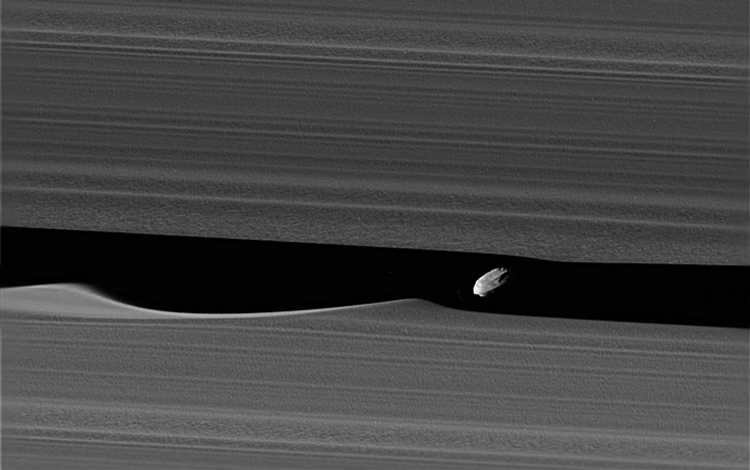
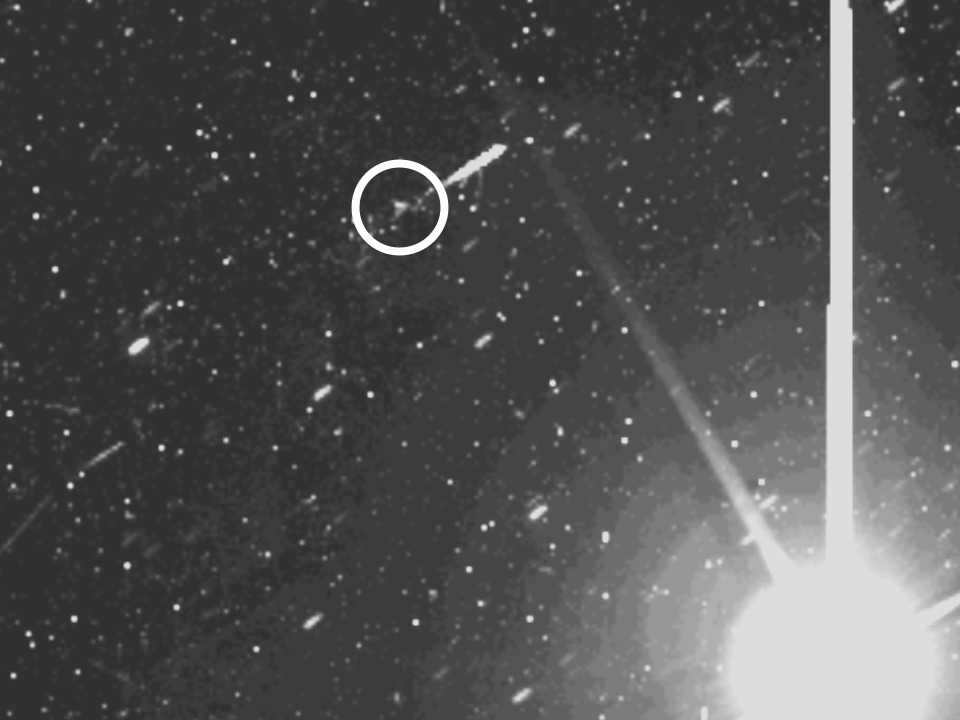
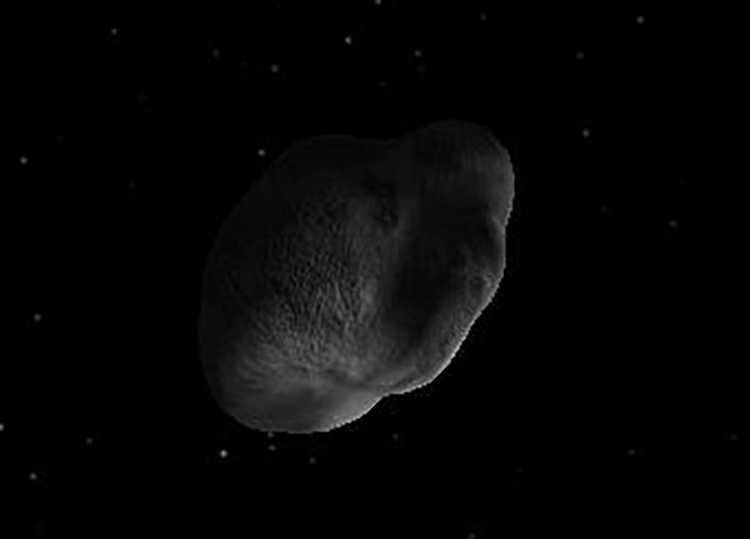
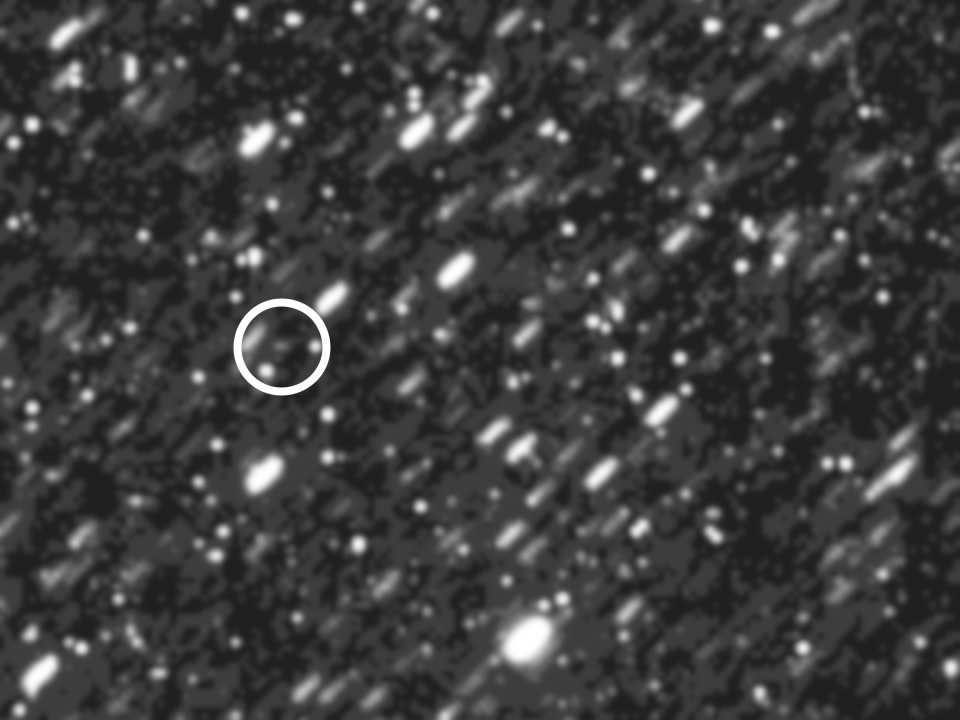
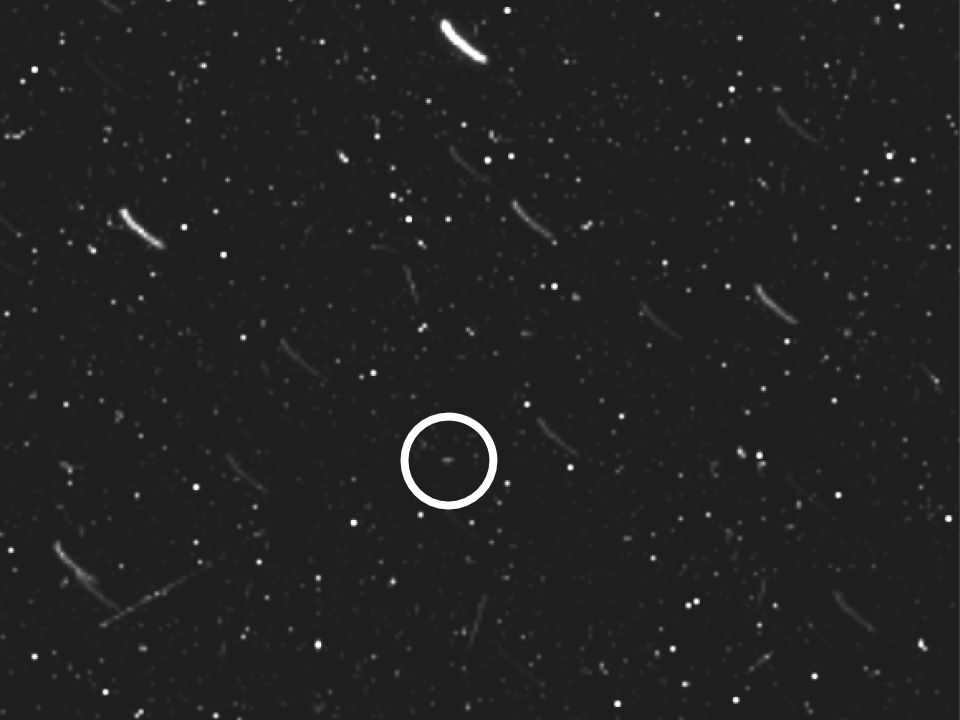
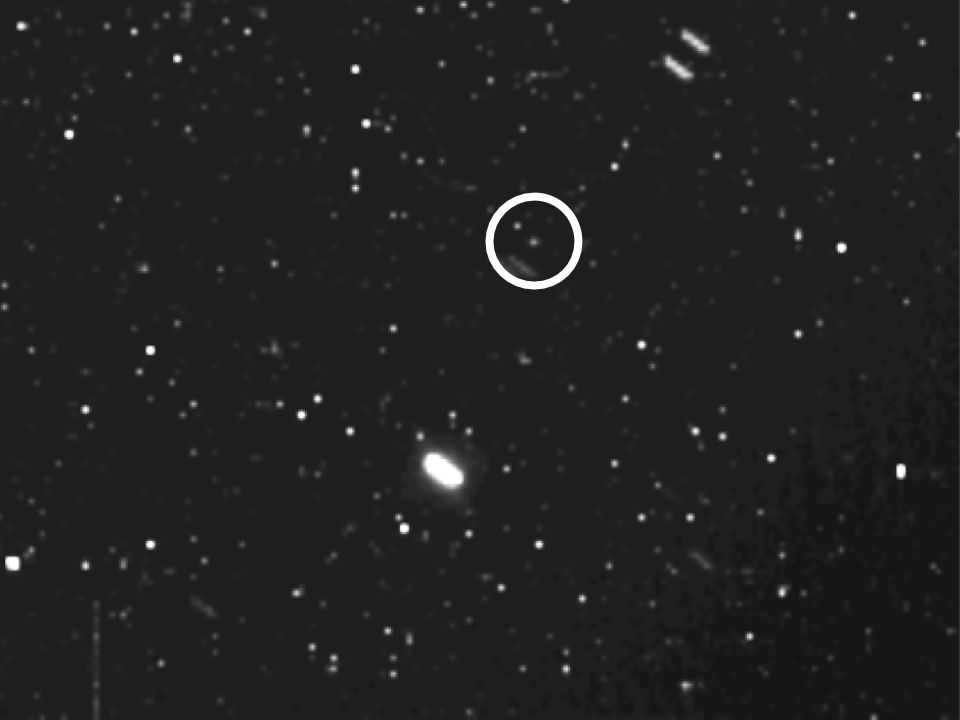
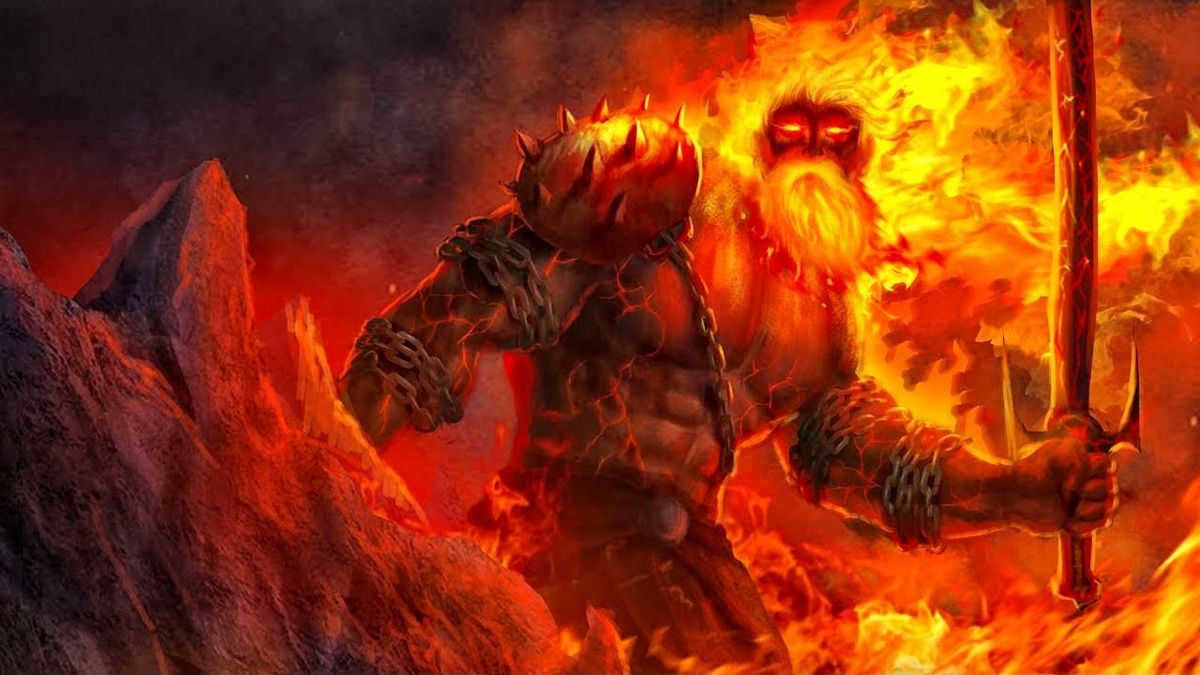
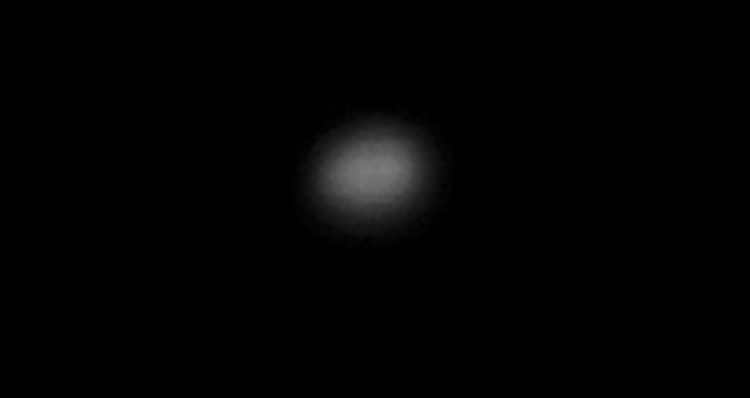
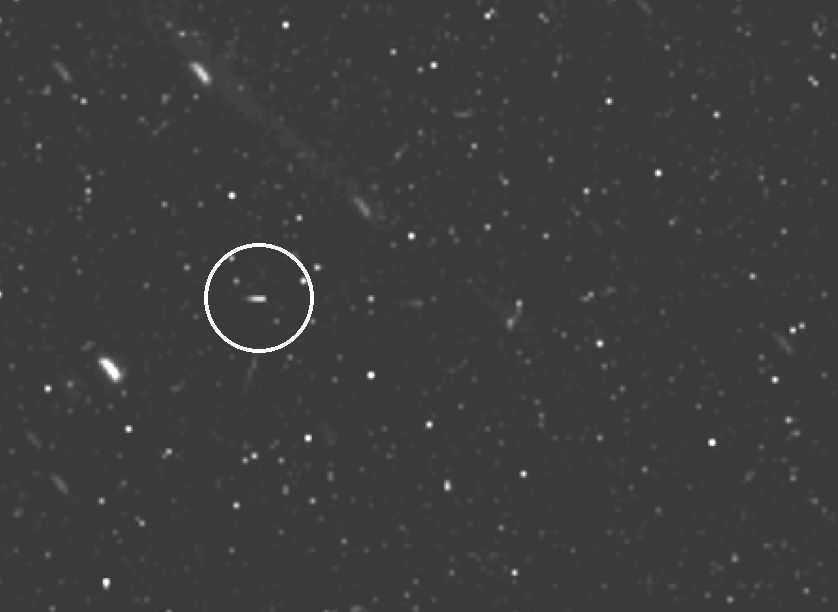
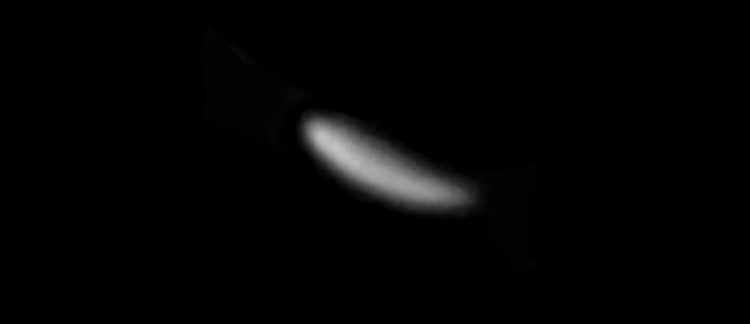
When ancient civilizations searched for the origins of space objects, they gave them names inspired by beautiful animals and mythical heroes. The planet Saturn, known for its slow orbit that takes just over 29 years to complete, was named after the ancient Greek god Cronus. In Roman mythology, Cronus was associated with Saturn, the god of agriculture, due to the close connection between the two cultures.
The biggest moons
Saturn’s collection of moons is vast and plentiful, boasting 12 moons that surpass 100 km in diameter. Similar to our own Moon, all of Saturn’s numerous companions orbit in a way that keeps one side facing their planet, except for Phebe and Hyperion. Among these moons, which one holds the most enigmatic secrets?
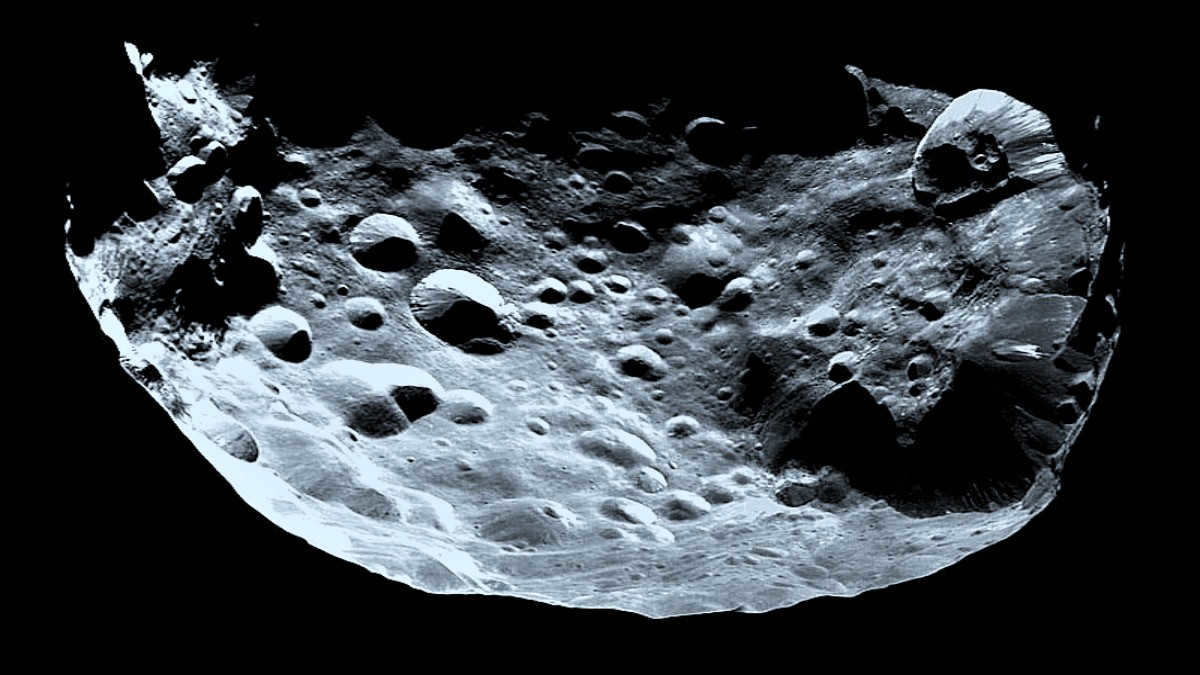
Titan
Not much information was available about this moon until Cassini approached it. An enigmatic orange mist completely obscured its surface from our view. It was first observed by Christian Huygens on March 25, 1655.
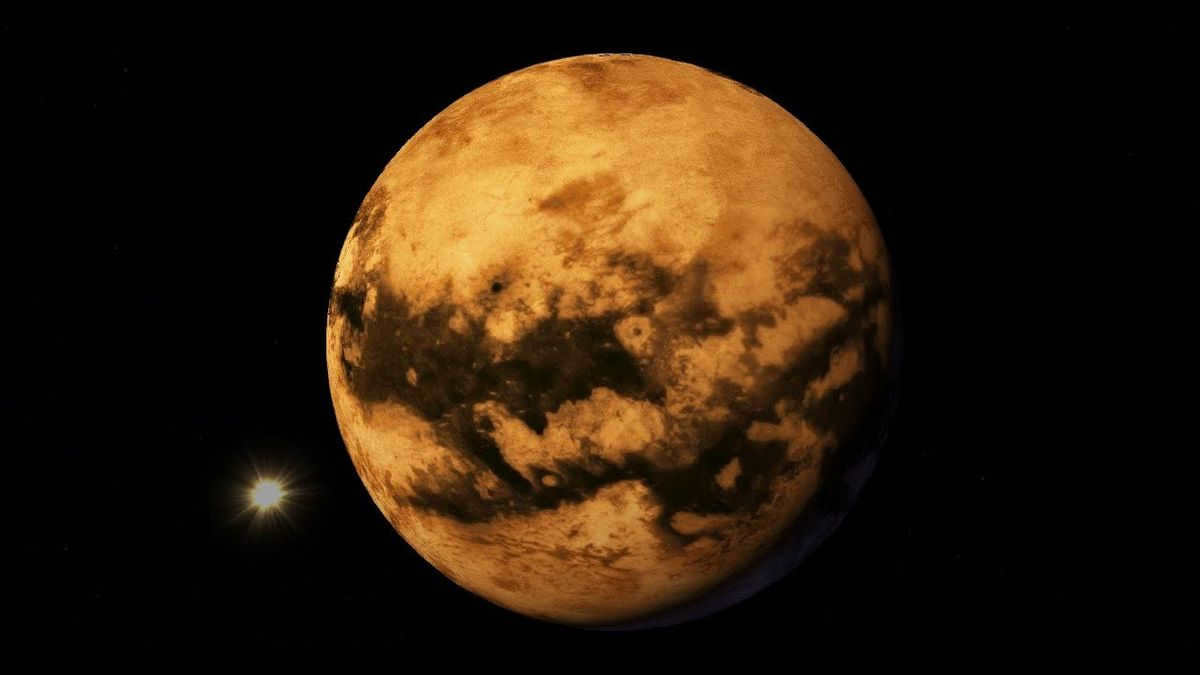
A translated anagram reveals that Saturn’s moon completes a full orbit in 388 hours. Titan, one of the seven main satellites of the planet, was named by scientist John Herschel in 1847, after the Titans who were the brothers of the god Cronus.
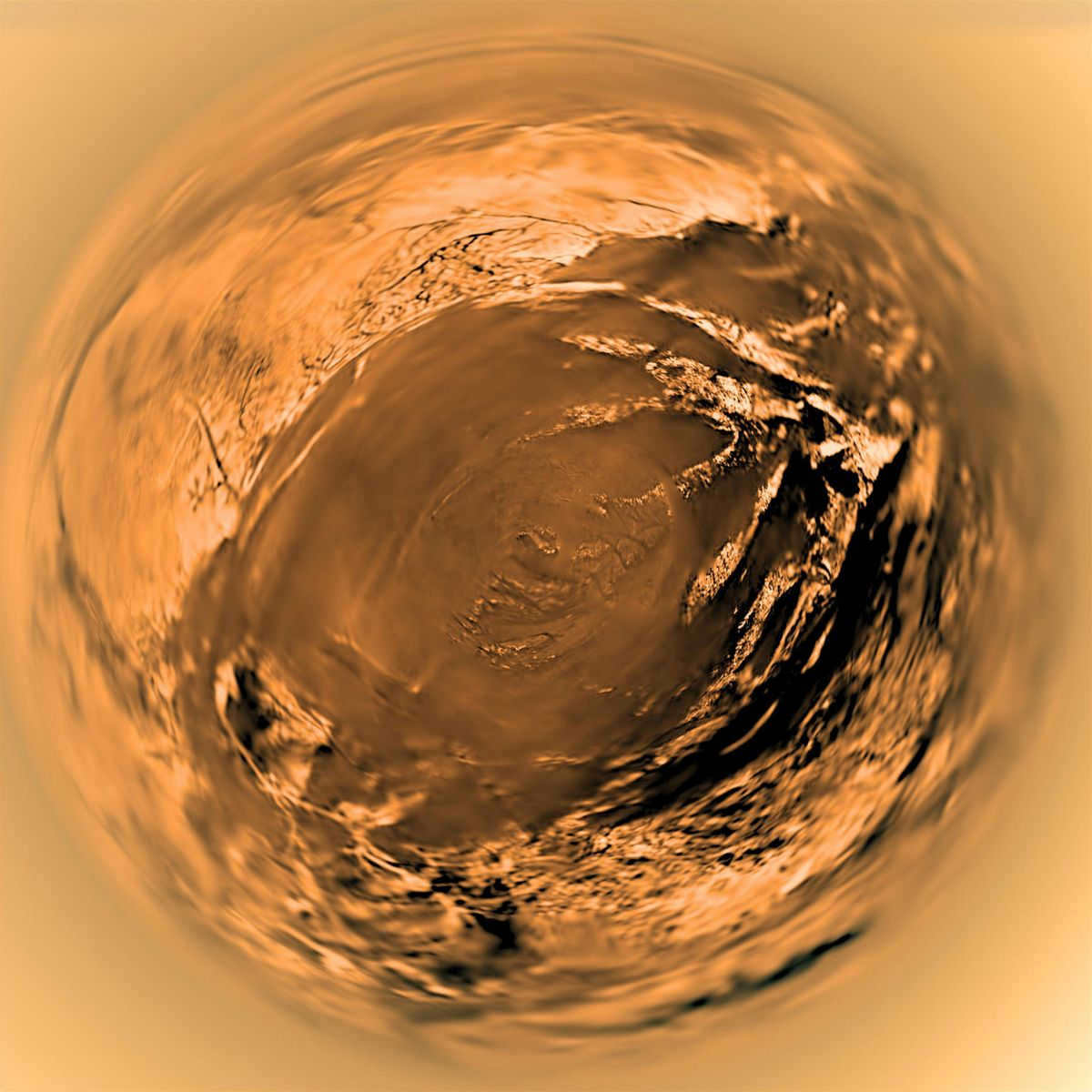
Saturn’s largest moon is the second largest moon in the entire solar system. With a diameter of 5,152 kilometers, it surpasses the diameter of Mercury, which measures 4,879 kilometers. The moon’s atmosphere consists mainly of nitrogen, making up 98% of its composition, while the remaining gases, such as methane, are present in smaller quantities.

According to the famous explorer Jacques-Yves Cousteau, humans feel comfortable at an atmospheric pressure of 2 atm. However, on Titan, the pressure is approximately 1.5 atm. As a result, when it comes to colonizing other planets, Titan emerges as the most viable option for such a mission.
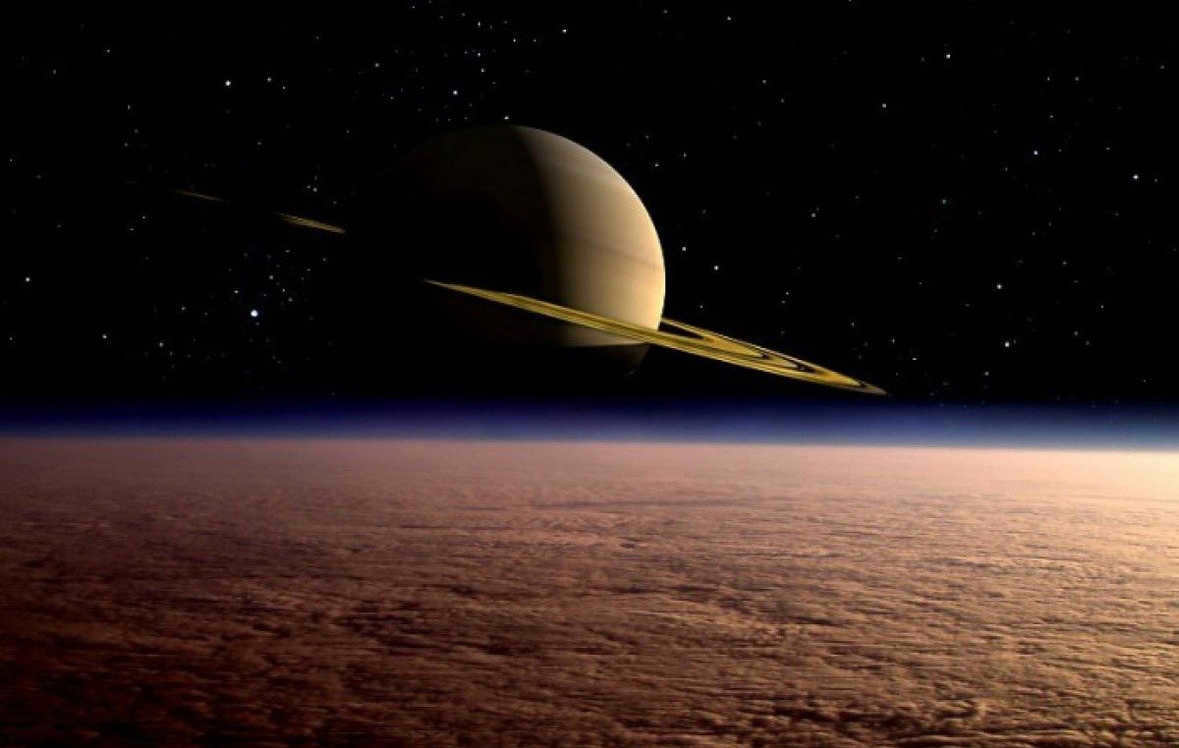
While it is indeed a fact that Titan experiences temperatures as low as -180°C, it is worth noting that there is a lack of winds on this moon. However, with the continuous advancements in technology, it is highly likely that humanity will find a solution to this problem. The data collected from the Cassini spacecraft has provided scientists with valuable insights, revealing the existence of an ocean with liquid water at a depth of 100 kilometers. This discovery opens up a vast realm of possibilities for imaginative writers and storytellers.
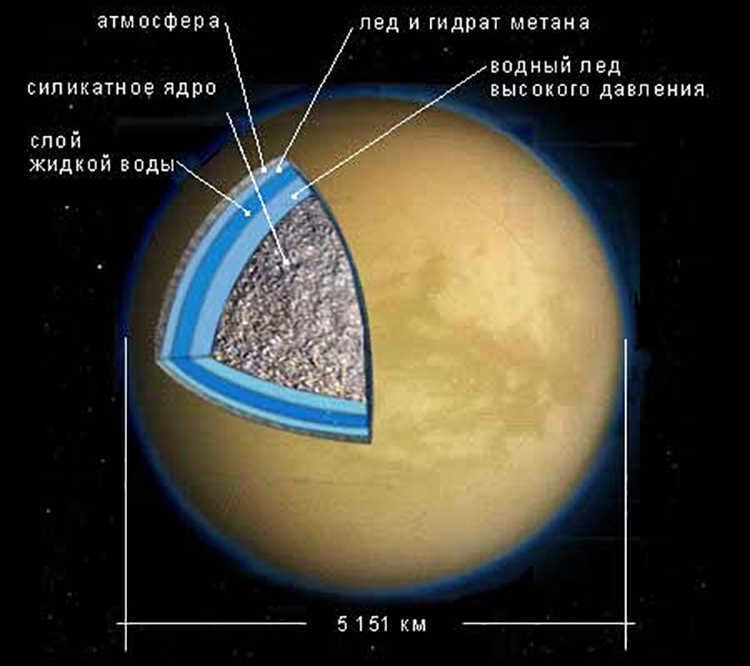
Rhea
Discovered on December 23, 1672, Rhea was originally named Louis, after King Louis XIV of France. However, in 1847, it was given the name Rhea, after the titanid who was both the sister and wife of the god Cronus. With a diameter of 1,528 kilometers, Rhea is the second largest satellite of Saturn. To put it in perspective, the Moon has a diameter of approximately 3,474 kilometers. Rhea completes one revolution around Saturn in just 4.5 days. Recent research has revealed that Rhea’s composition consists of a mixture of ice and rocks. Scientists also believe that there may be a hidden ocean of liquid within this celestial body. Isn’t that fascinating?
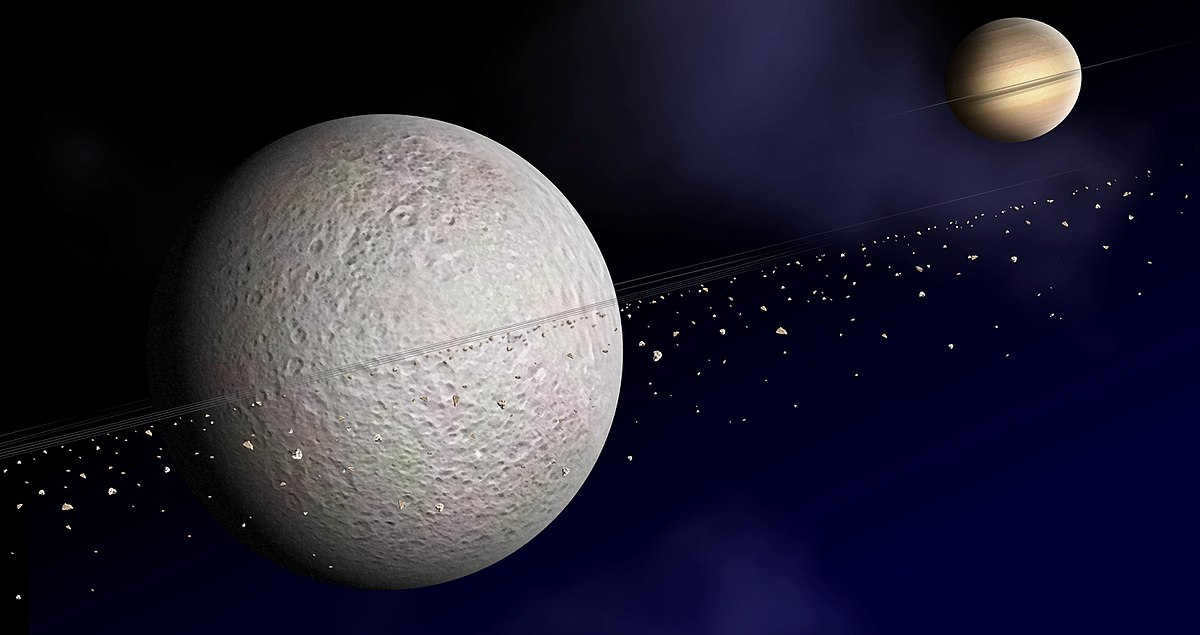
Rhea exhibits a dual personality, with each hemisphere showcasing unique characteristics. The side facing Saturn boasts a dark hue adorned with a mesmerizing network of light stripes, which are actually icy ridges and cliffs. On the other hand, the outer hemisphere appears light and uniform, serving as a protective shield for the planet and bearing witness to a multitude of craters.
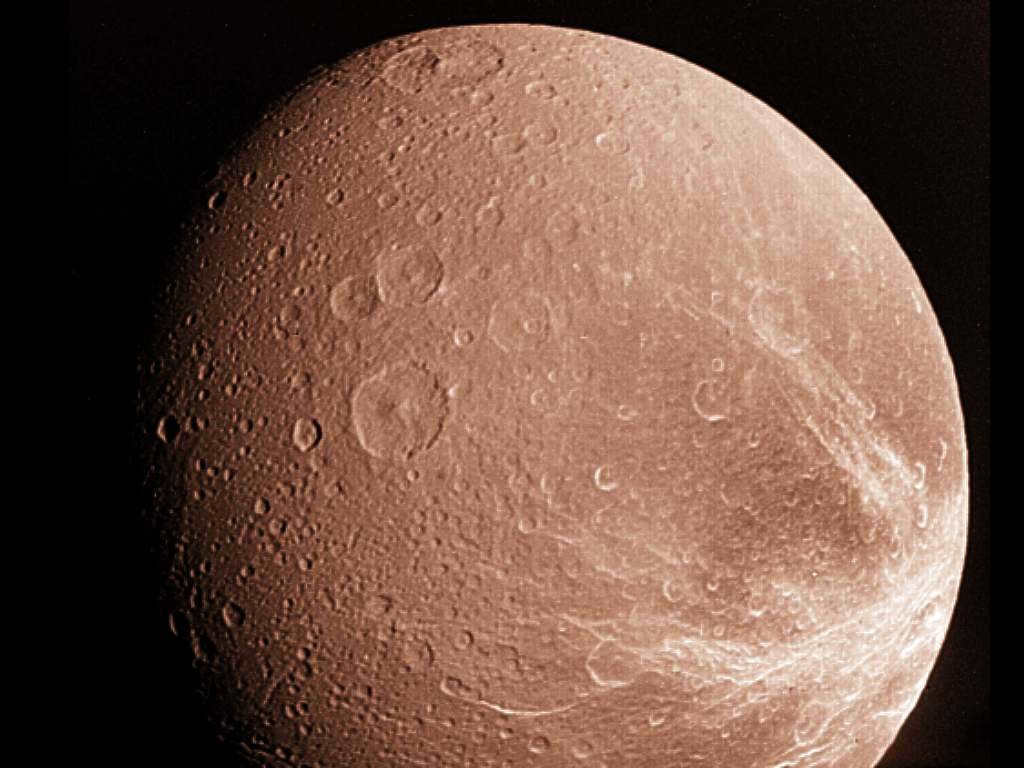
Rhea’s atmosphere is characterized by its rarity, but what sets it apart is the presence of oxygen and carbon dioxide, which are sourced from water ice. The extraordinary chemical reactions taking place within this icy realm provide compelling evidence for the existence of basic forms of organic life.
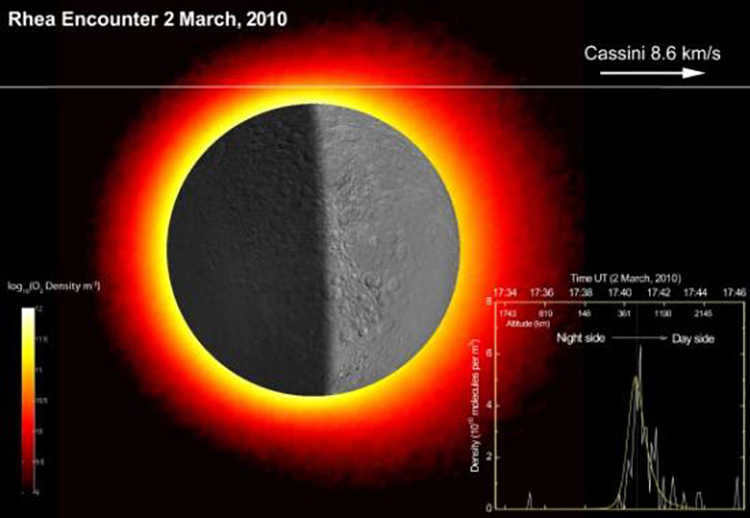
Japet
The third largest moon is equally fascinating. On October 25, 1671, Cassini discovered it and named it Louis. It was also identified by Herschel and named after his brother Cronus. With a diameter of approximately 1,500 kilometers, it orbits Saturn in 80 days. The abundance of allusions is quite symbolic, don’t you think?
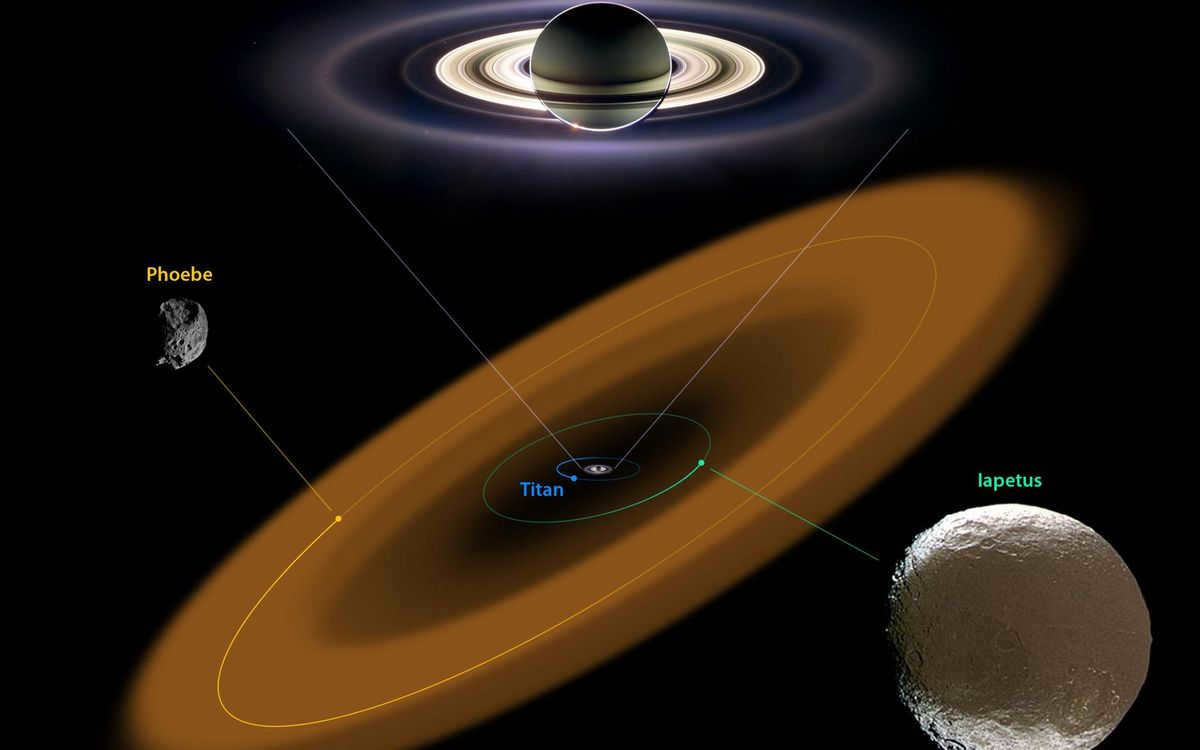
Japeth’s ability to walk on two legs is extraordinary. One hemisphere is pitch black, while the other is pure white. The distinction is defined by distinct borders. The temperature on the illuminated side is as low as -175°C, whereas on the shaded side it reaches -135°C.
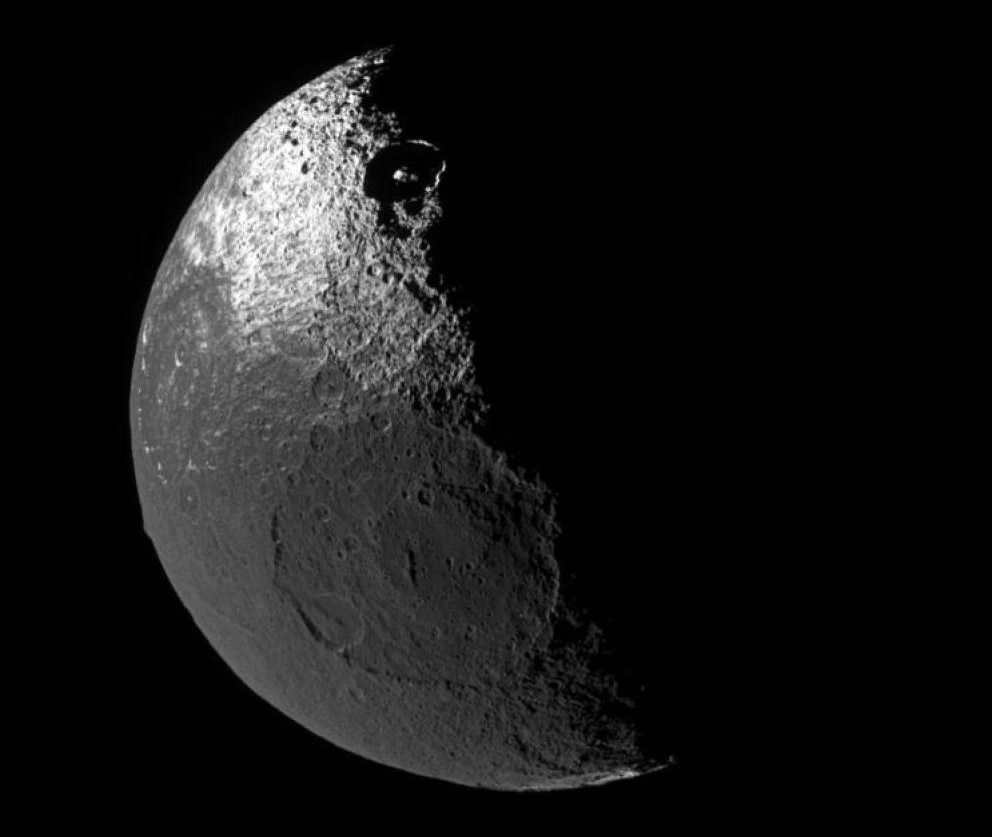
There is another intriguing aspect about this moon that deserves attention – the Japet Wall. This ridge encircling the celestial object measures up to 13 km in height and 20 km in width, leading to intense debates and giving rise to fascinating theories. In Arthur C. Clarke’s science fiction novel “Space Odyssey,” Japet served as the location for the Stargate, a portal to other universes.
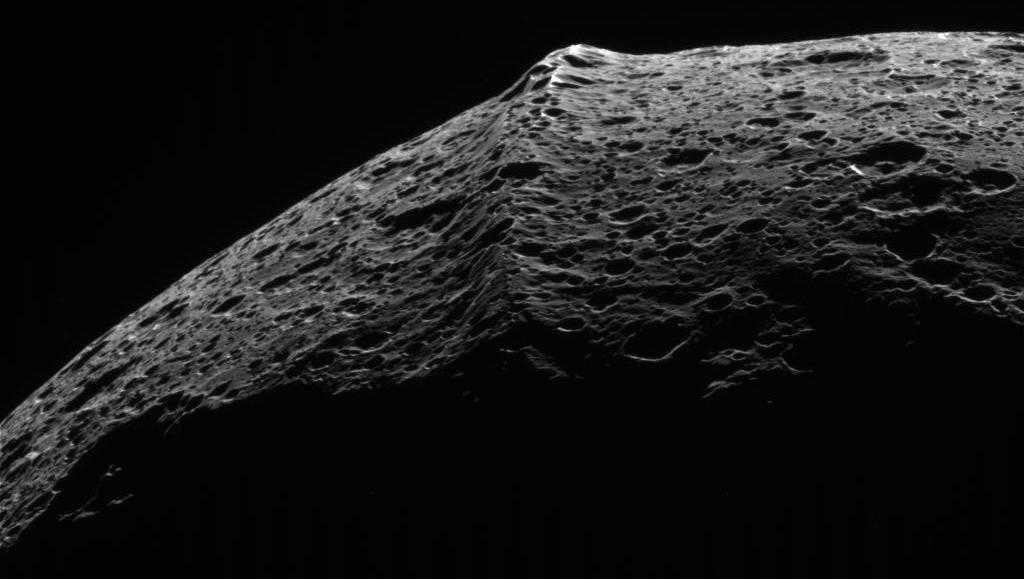
Diona
Diona, the moon that ranks as the fourth largest, was initially discovered by Giovanni Cassini on March 21, 1684. According to mythology, Dione is an oceanid who is known as the mother of Aphrodite. Diona boasts a diameter of 1,123 kilometers and completes its orbit around Saturn in approximately 65 hours. Its distance from Saturn is nearly 378,000 kilometers, which is almost the same as the distance between the Moon and Earth. Interestingly, Diona bears a striking resemblance to another Saturnian moon called Rhea.
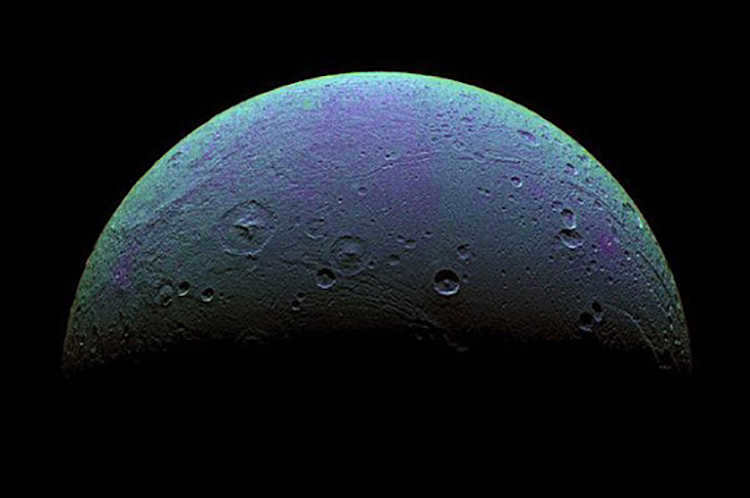
However, there is a remarkable anomaly – the patterns of white stripes observed on Ray exhibit a disordered nature, whereas the stripes on Dione align with the equator. This presents numerous possibilities for speculation. Furthermore, similar to Rhea, Dione serves as a shield against meteorite impacts on its celestial body.
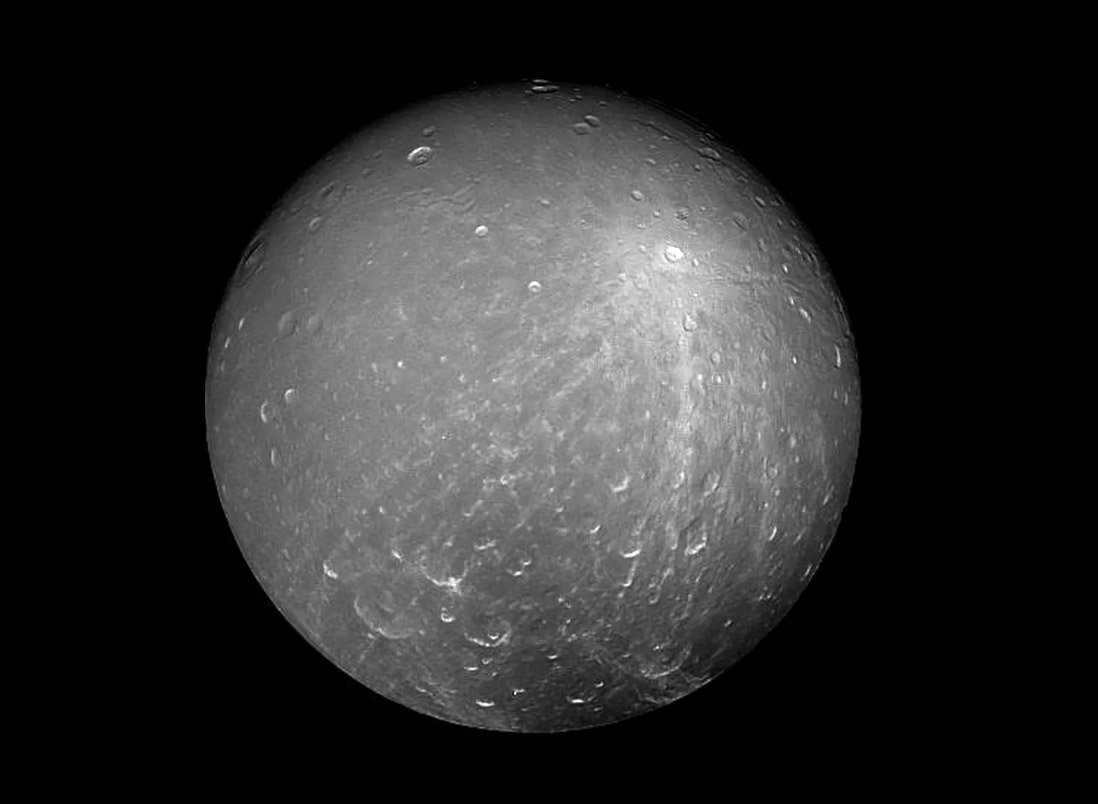
Tefia
Discovered by the Cassini spacecraft on March 21, 1684, Tefia is the fifth largest moon of Saturn. It was named after the Titanid deity Tefia, who was the daughter of Uranus and Gaea and the wife of Oceanus. With a diameter of 1,055 kilometers, Tefia has a orbital period of approximately 2 days. The average temperature on the moon is -185°C, and it lacks an atmosphere.
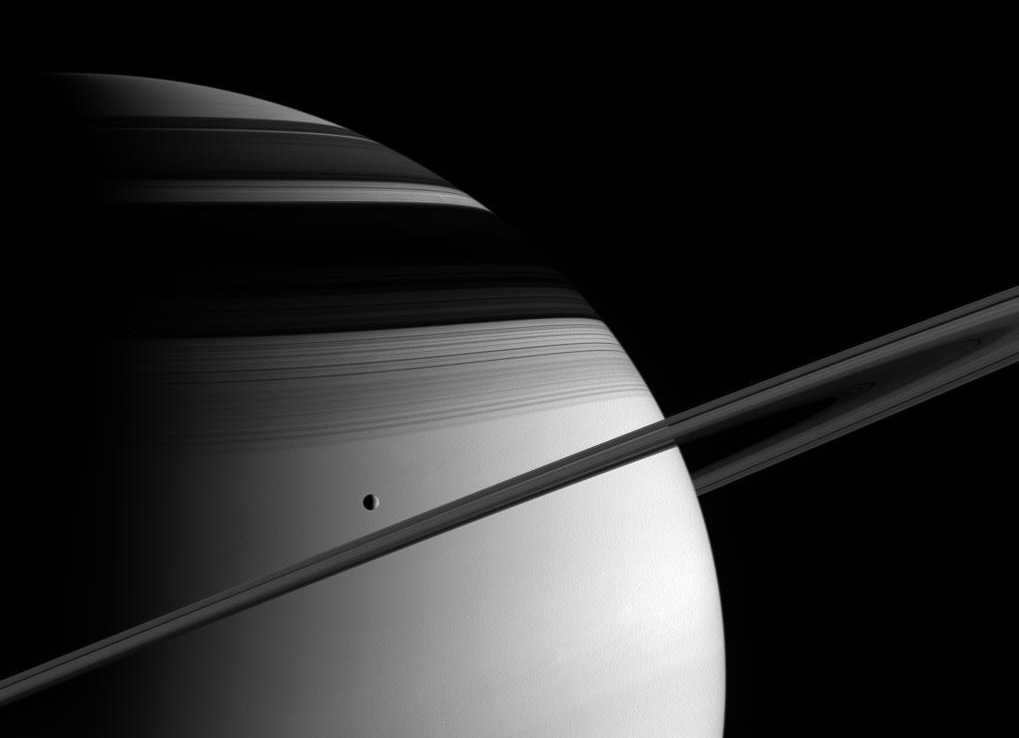
Because of its consistent topography, the moon reflects light extremely well. Saturn’s moons consist primarily of water ice, resulting in diverse colors across the moons’ surfaces.
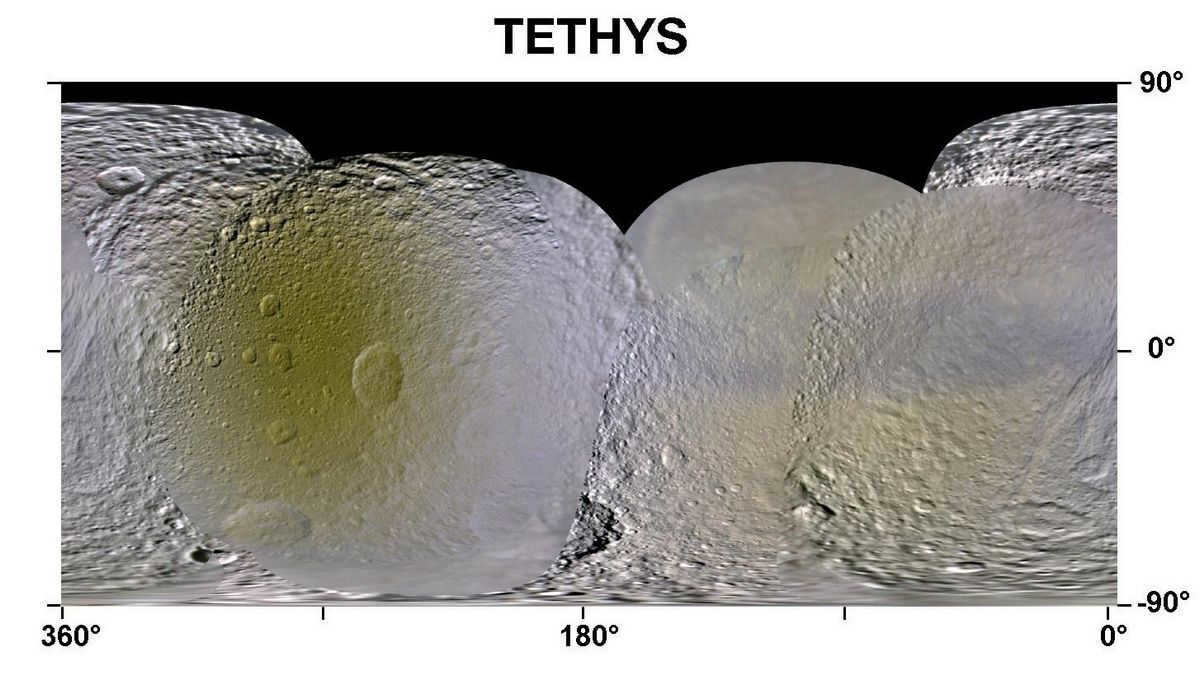
Tefia exhibits a range of hues, starting from a vibrant crimson shade and fading into a delicate pastel pink along the division line across its hemisphere. Furthermore, an azure strip can be observed encircling the planet’s equator on its outer surface.
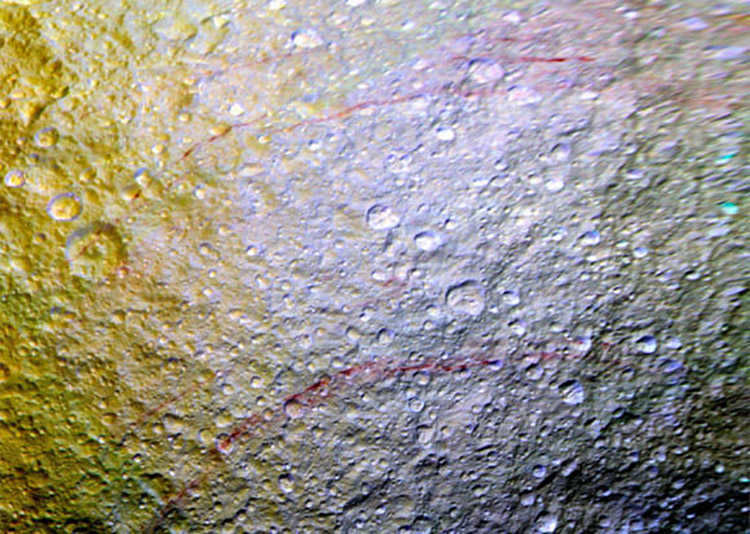
According to scientists, this moon is believed to have originated from a nebula composed of gas and stardust, which explains the presence of the streaks caused by the collision of electrons moving in a direction opposite to the planet’s orbital motion.
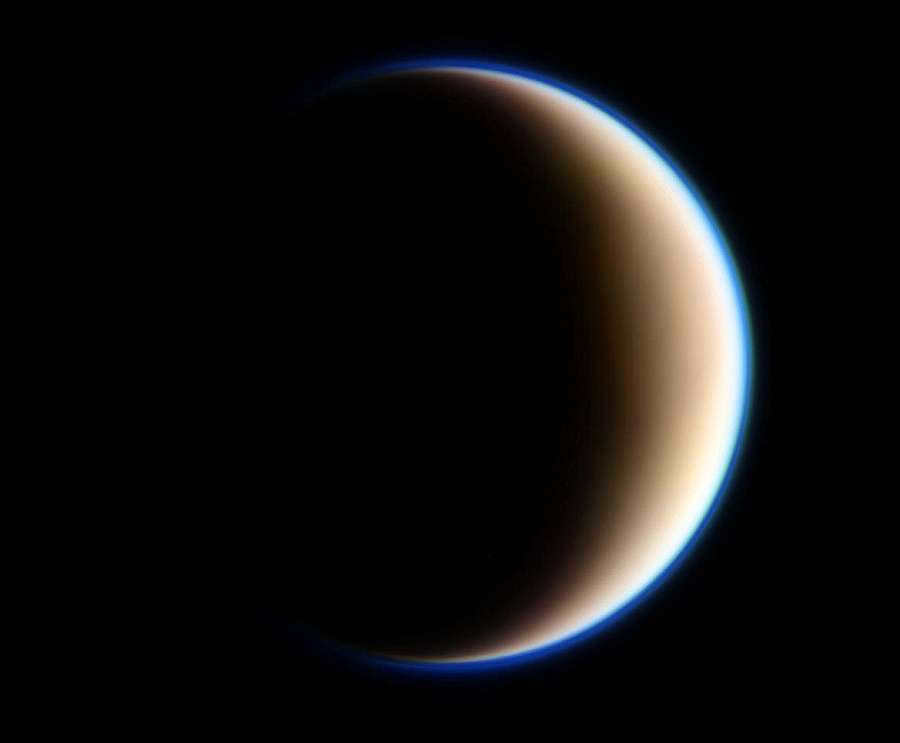
Tephia has been protected from meteorites by the strong gravitational pull of Saturn. However, there are two notable exceptions that have left their mark on the moon. The first is the Odyssey crater, which covers a third of the satellite and has a depth of 5 km. The second is the Ithaca Canyon, which spans over 100 km in width. These features are also significant landmarks on the moon.
It is worth noting that all of the major landforms on these moons are named after Homer’s epic poem, “The Odyssey”.
Enceladus
The discovery of Saturn’s sixth moon was made by William Herschel on August 28, 1789. This celestial body was named after the powerful mythical giant Enceladus, who was the son of Tartarus and Gaea. Enceladus has a diameter of 504 kilometers and boasts an average temperature of approximately 200°C. Its orbital period spans about 33 hours. The composition of this moon is predominantly made up of 90% water vapor, with the remaining constituents being nitrogen, carbon dioxide, and methane.
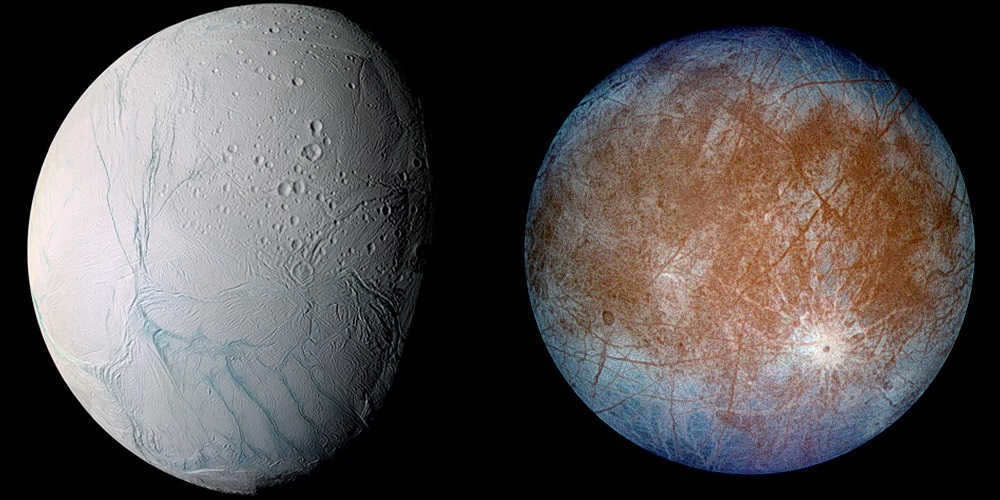
In contrast to its icy counterparts Dione and Rhea, Enceladus stands out due to the presence of water vapor geysers, with the height of the erupting jets reaching up to 500 km depending on the satellite’s orbit distance from Saturn.
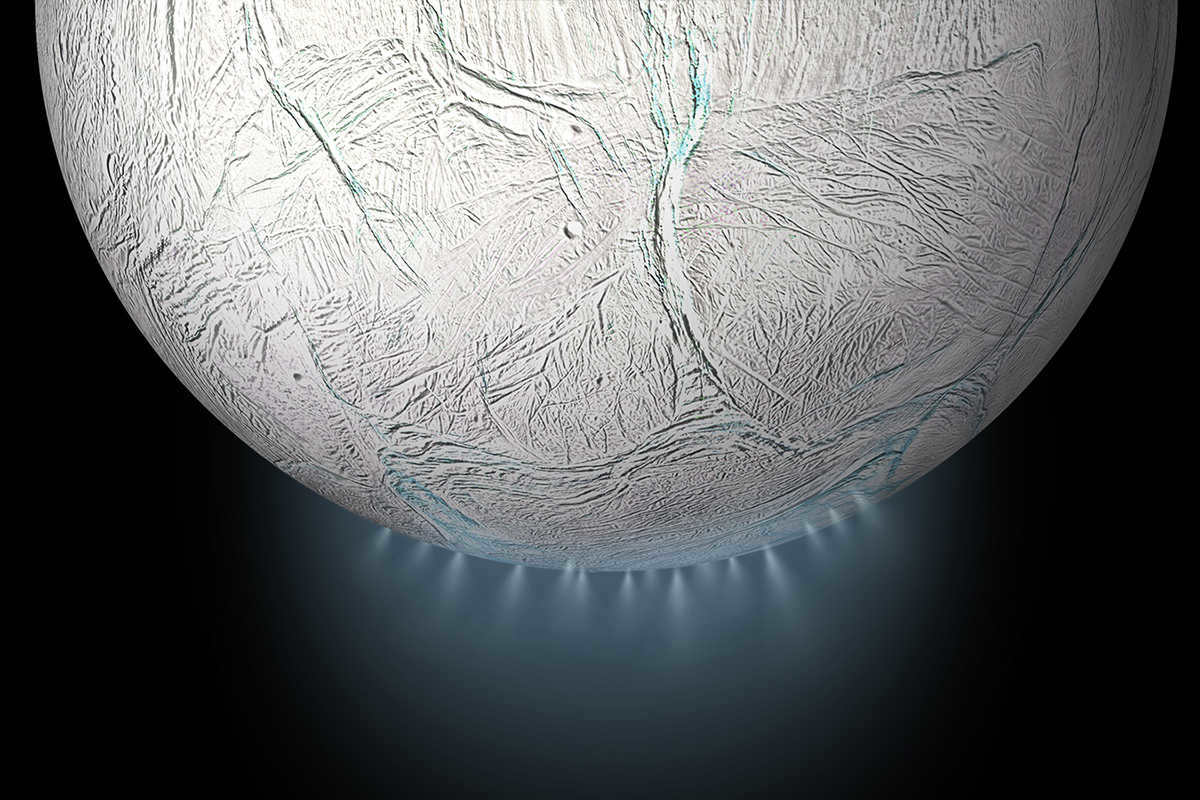
These variations are caused by geological activity in certain regions and the absence of activity in others. Thanks to the data gathered by Cassini, we now know that there is a thin atmosphere present, which was previously unknown.
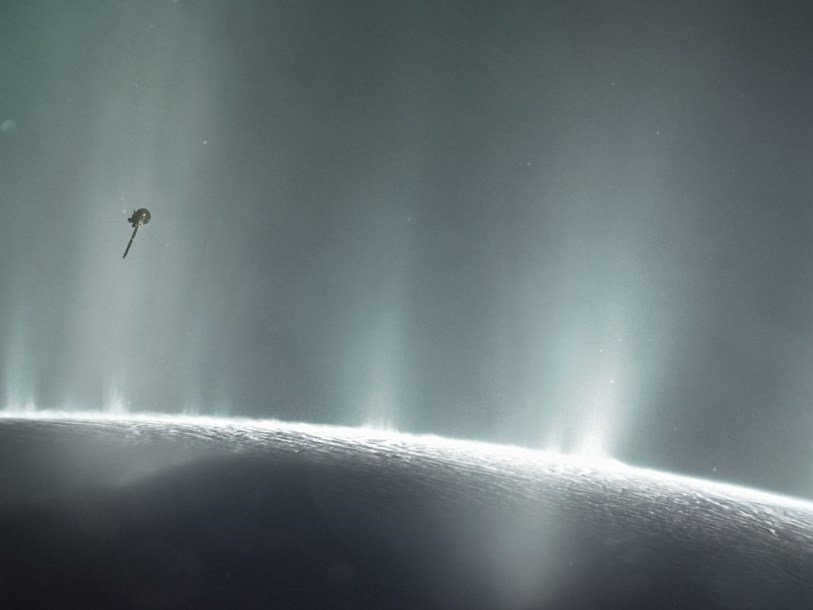
Furthermore, all indications suggest the presence of a briny ocean inside where the conditions for basic lifeforms to exist are possible.
Mimas
Discovered by William Herschel on September 17, 1879, Mimas is the seventh largest moon. It is named after the serpent-like offspring of Uranus and Gaia. With a diameter of 396 kilometers, Mimas has an orbital period of approximately 22 hours. The average temperature on Mimas is a chilling minus 195 degrees Celsius, and it lacks an atmosphere. It is truly remarkable that such a small celestial body has managed to maintain gravitational stability.
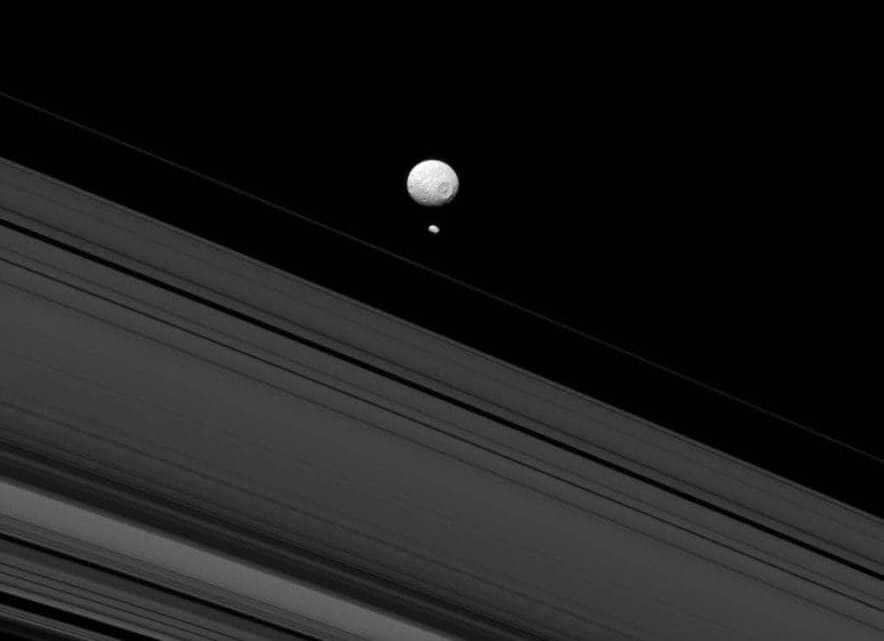
Mimas is covered in craters, with the largest one being over 130 km in diameter, with walls that are 5 km high and a depth of 10 km. This crater is named after Herschel and was formed by a meteorite impact, which should have completely destroyed the moon.
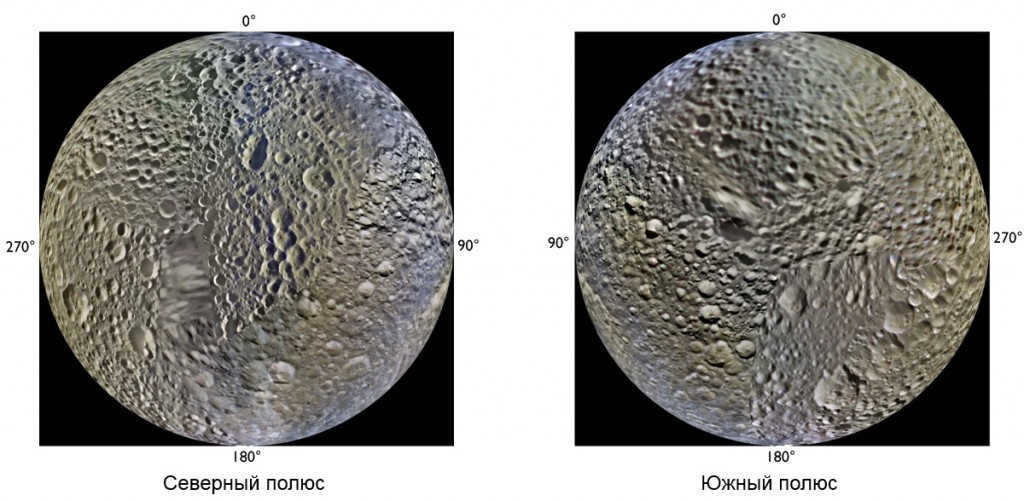
Nevertheless, Mimas managed to survive. And the striking resemblance of its appearance to the Death Star from the fourth episode of the movie “Star Wars” serves as a chilling reminder that nothing can be imagined that has not existed before.
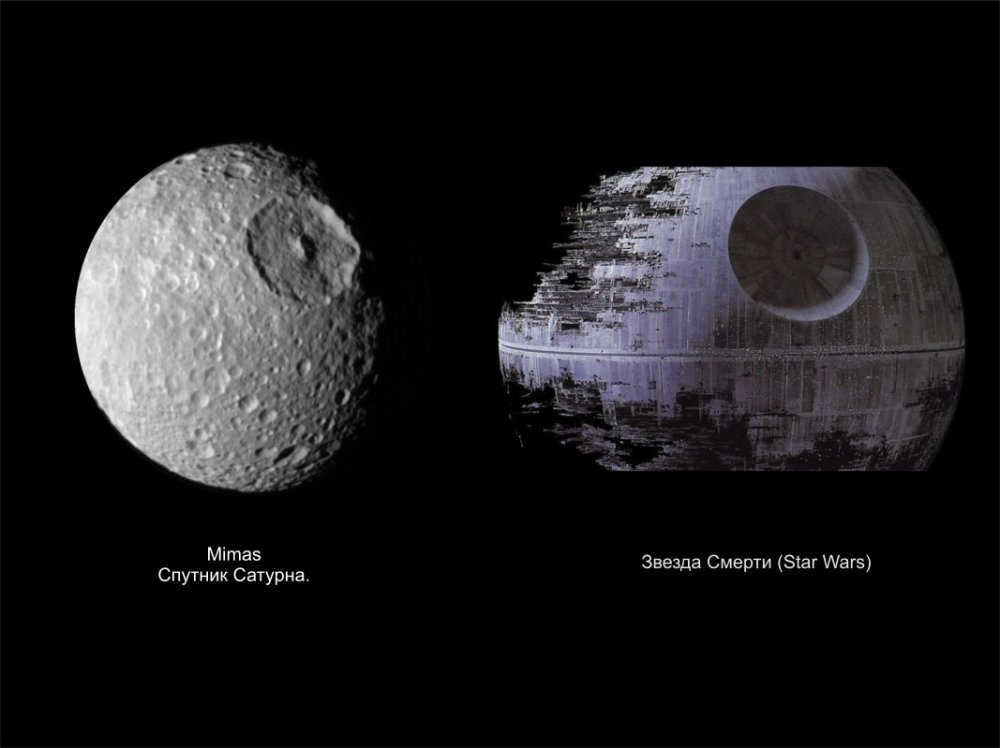
The names of the landmarks on Mimas are derived from the legendary figures of King Arthur and the Knights of the Round Table.
How Saturn’s moons were formed and what they are made of
Even a young child would easily recognize the sixth planet in our solar system.
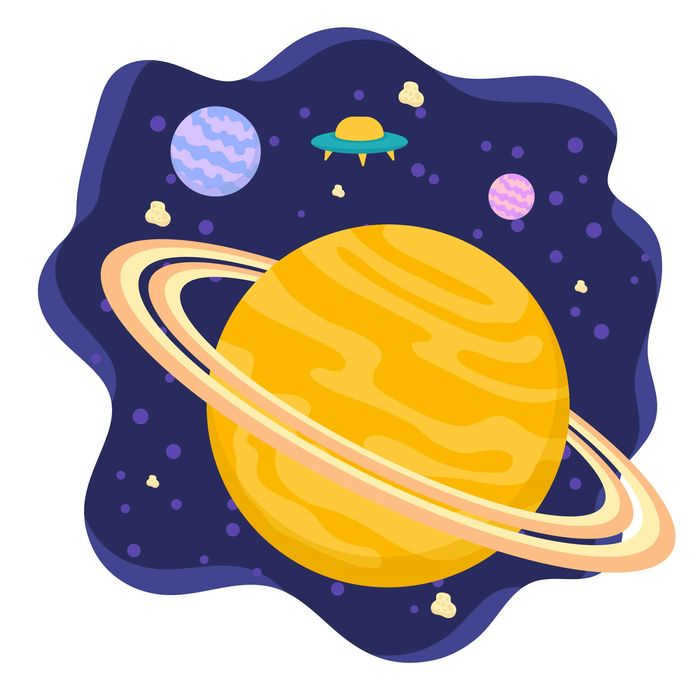
One of Saturn’s most remarkable features is its magnificent rings composed of stardust and enormous ice crystals. Back in 1921, these iconic rings seemed to vanish, causing a great deal of panic among the media. However, it was later discovered that the rings had simply shifted position and taken on a sideways orientation.
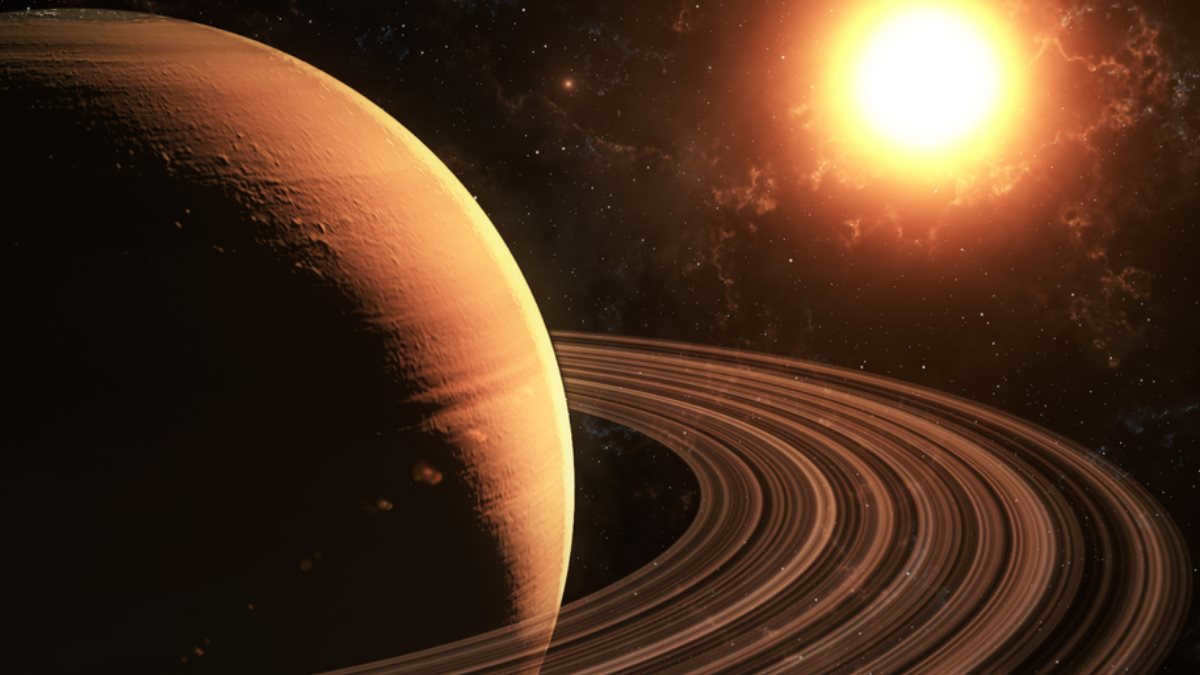
The abundance of satellites orbiting around Saturn is attributed to the unique characteristics of its formation. These moons were believed to have originated during the early stages of the Solar System’s development, although recent modeling suggests that some of them may be relatively young, with an estimated age of less than 100 million years.
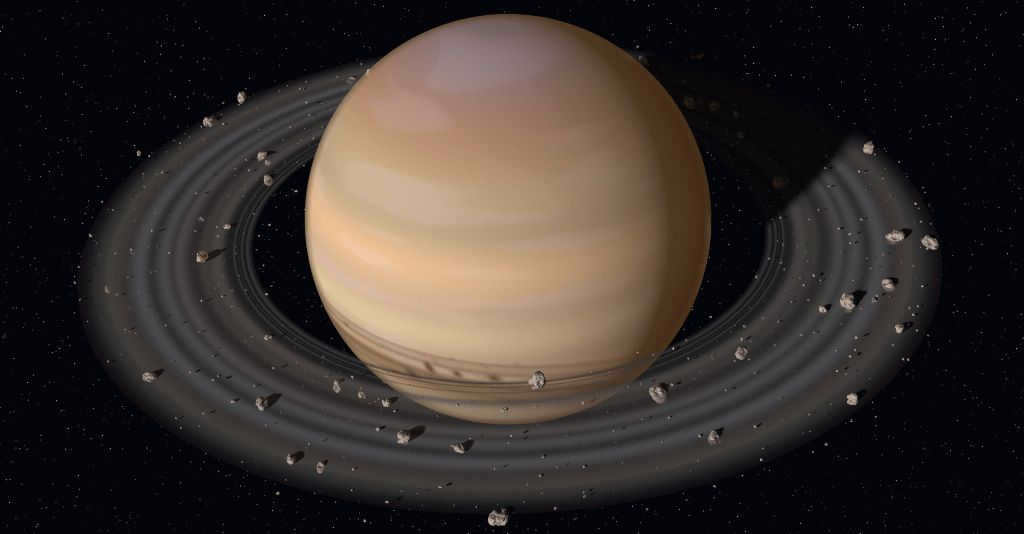

The synchronized motion of the particles composing the rings and satellites of Saturn provides reassurance that both entities were created concurrently, forming a unified and interconnected mechanism – the ring system.
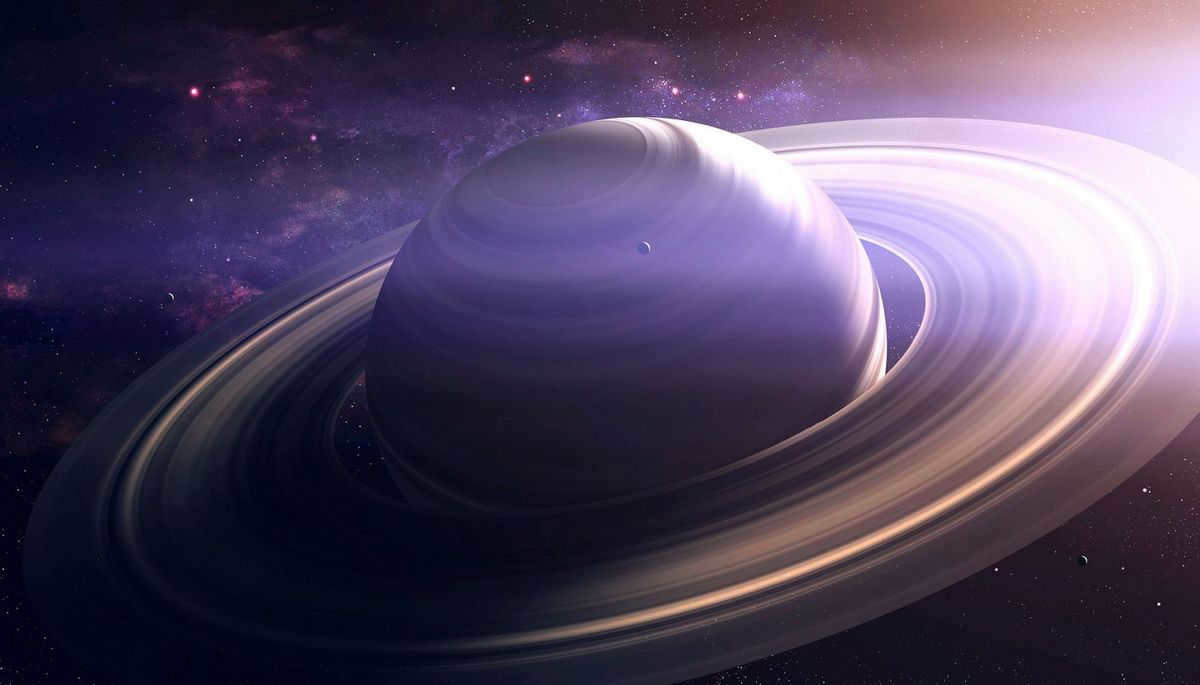
In order to achieve a sculptural appearance and ensure the stability of the rings, there exist satellites known as shepherds. These satellites revolve both outside the planet and within the rings. There are co-orbiting satellites, such as Epimetheus and Janus, which are nearly identical in size. Every 4 years, these satellites alter their orbits as a result of gravitational influences.
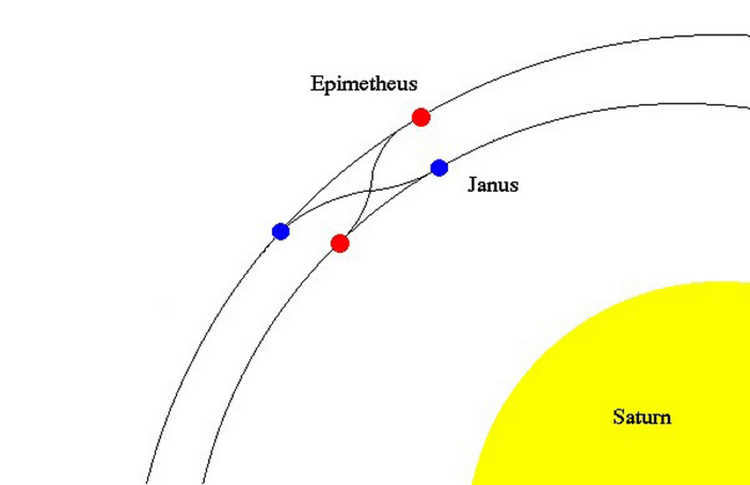
Moons such as Tefia, Diona, Mimas, and Enceladus have a stable orbit that is closer to Saturn, while moons such as Titan, Rhea, and Japetus orbit further away in the E ring.
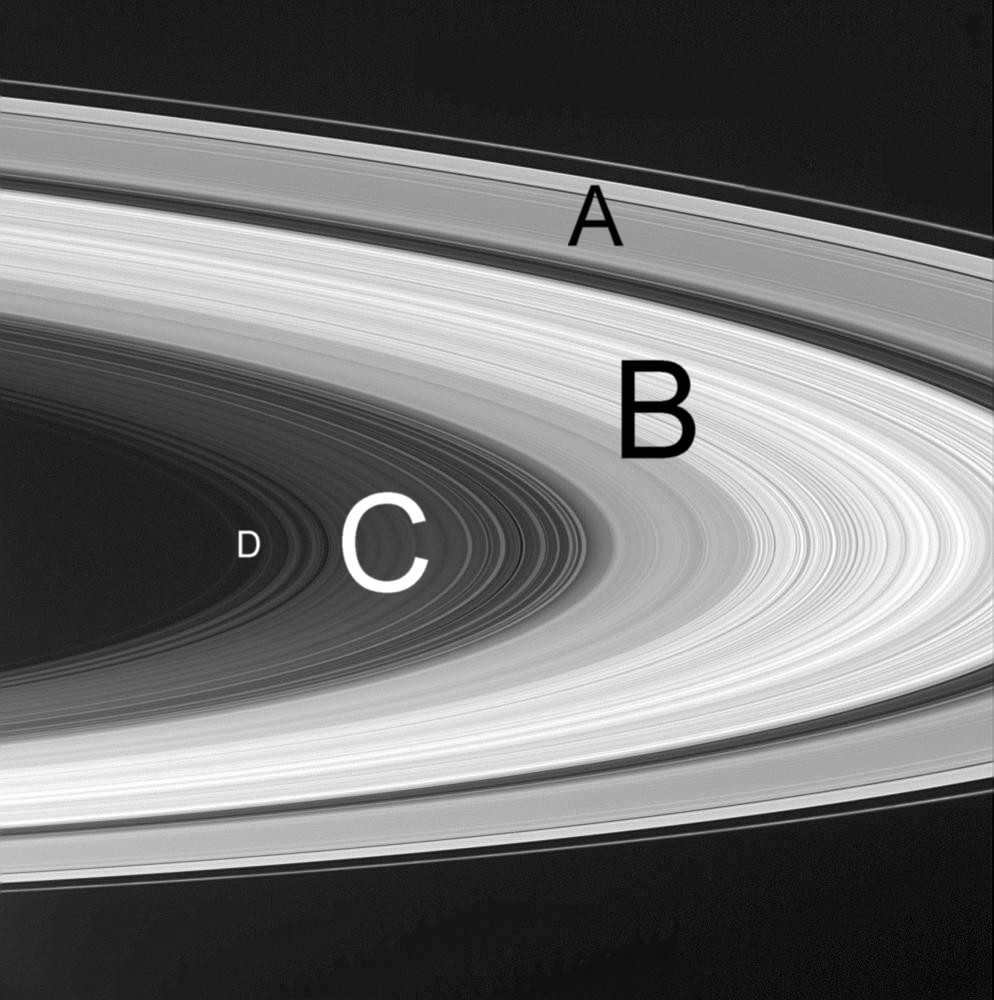
Theba is one of the satellites that have an irregular orbit and it moves in a clockwise direction, which is opposite to the direction of the planet’s motion.
The planet’s gravitational forces may have “captured” these satellites.
What is the current number of Saturn’s satellites in 2021? It is likely to be over 100. In 2019, a group of American scientists discovered an additional 20 previously unknown satellites orbiting Saturn.
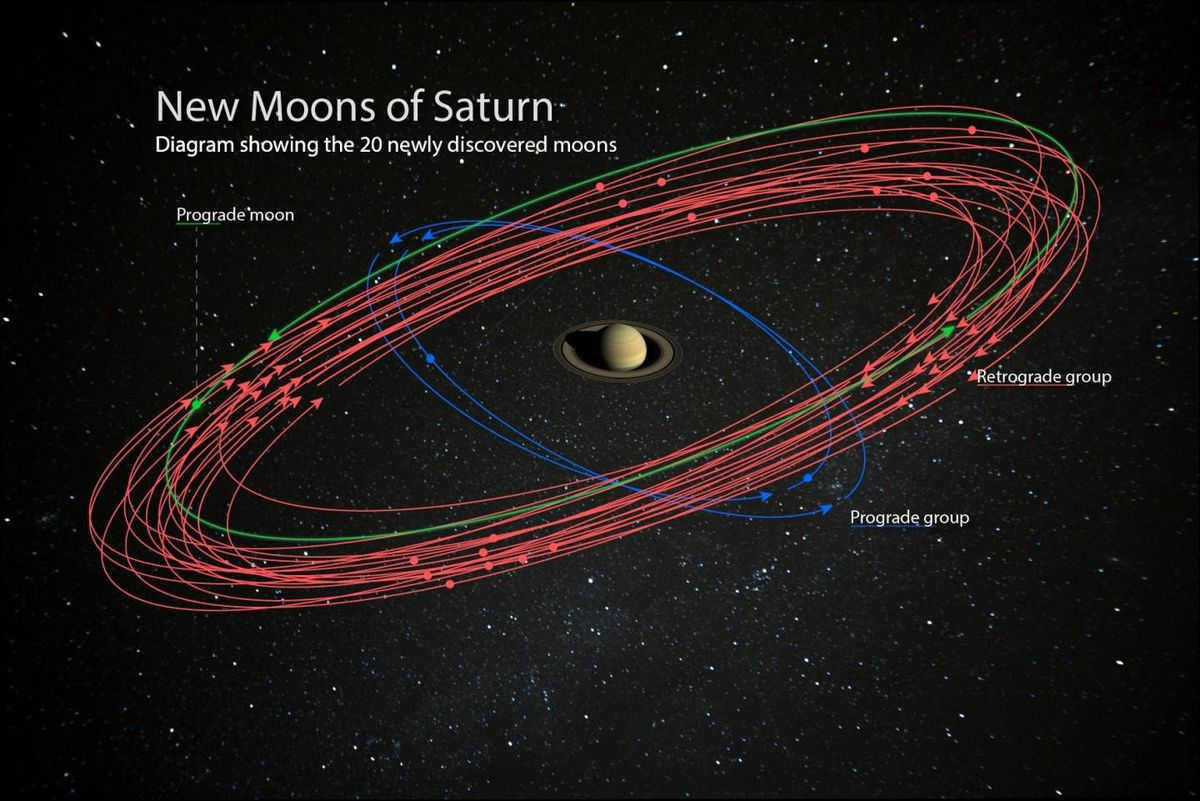
In order to maintain the integrity of its magnificent rings, Saturn must capture celestial objects that come into its orbit, causing them to collide and transform into cosmic particles that then become part of the ring system. This planetary system, with its collection of moons, can be seen as a microcosm of the entire solar system.
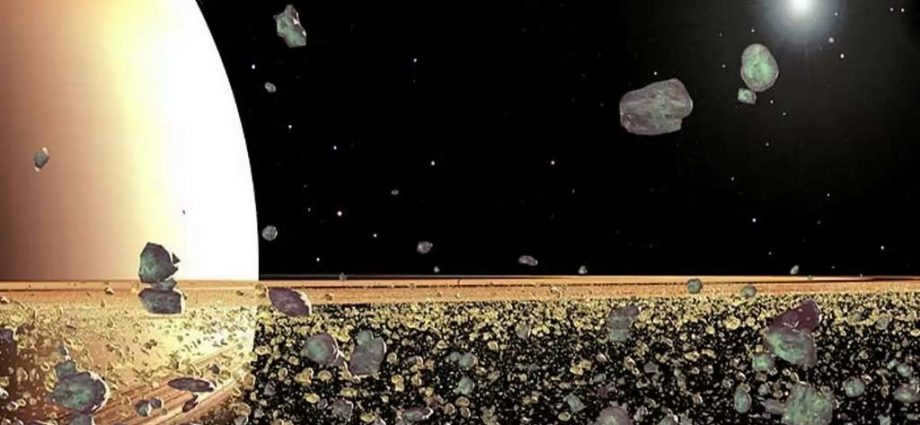
Saturn has a variety of satellites with different orbital periods. While some complete a full orbit around Saturn in just twelve hours, others take almost four Earth years to circle their planet.
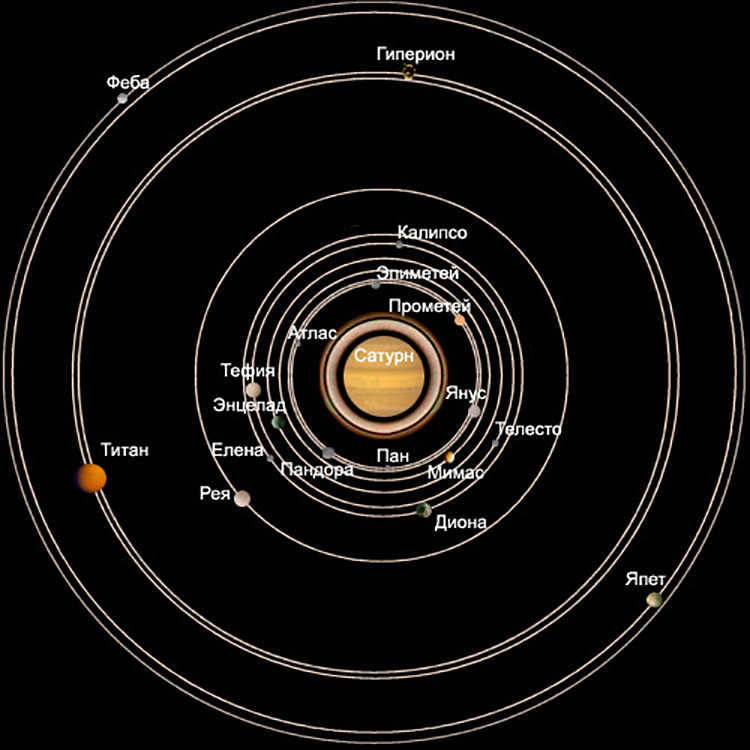
Lastly, thanks to the power of the internet, there is an abundance of knowledge available about the cosmos. However, it is essential to remember the wise words of Stephen Hawking:
When we gaze out into the vast expanse of the universe, we are witnessing events that occurred in the distant past.
Saturn, the gas giant renowned for its stunning ring system, is also home to a vast array of satellites. While the total number of Saturn’s satellites is estimated to be close to 150, our knowledge of their orbital paths is limited to 62, with only 53 having been officially named.
Many of these satellites are small, icy objects, with 34 having diameters less than 10 kilometers and 14 falling within the 10 to 50 kilometer range. However, there are also some larger inner satellites that stretch between 250 and 5000 kilometers in diameter.

Each one of them varies in terms of environment, color, and characteristics. This system provides an extensive range of opportunities for exploration.
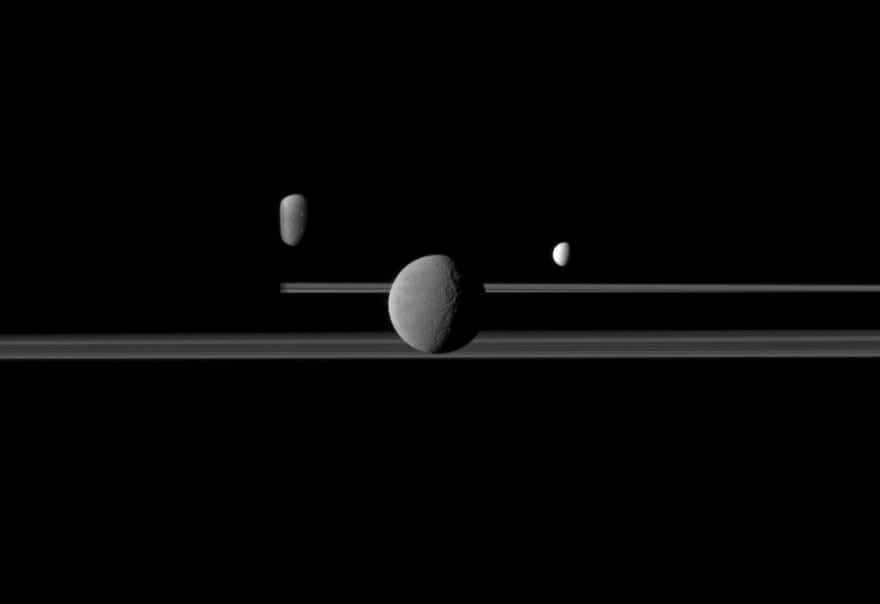

Cassini has observed three of Saturn’s satellites against the dark side of the planet
Discovery and naming
Prior to the era of photography, it was possible to spot 8 satellites through a telescope. In 1655, Christian Huygens discovered Titan, the largest satellite of Saturn. From 1671 to 1684, Giovanni Cassini made the discoveries of Tefia, Dione, Rei, and Japetus.
Enceladus and Mimas were identified by William Herschel in 1789, while Hyperion was recorded by William Lascelles in 1848. The photographic plates of the late 19th century enabled the discovery of Phoebus in 1899. Janus was found by Auduin Dolph in 1966, followed by the appearance of Epimetheus a few years later. You can view photographs of the satellites.
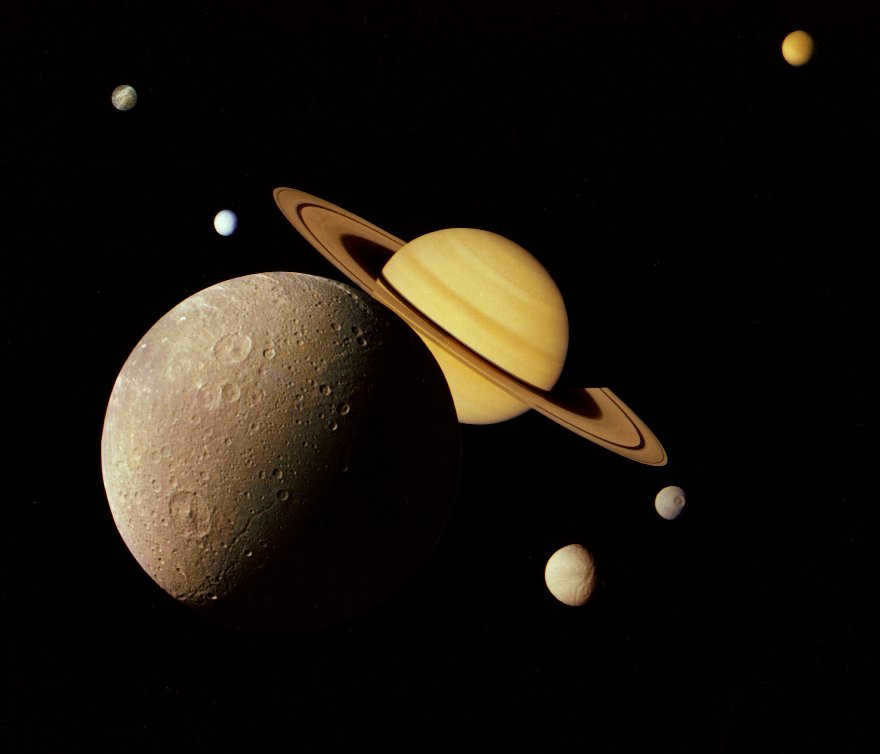
Saturn and its largest moons
In 1980, Voyager confirmed the discovery of three additional moons (Helena, Telesto, and Calypso). Further analysis of the extracted images allowed scientists to uncover the remaining satellites. The arrival of Cassini-Huygens in 2004 provided a comprehensive view, as it identified the three inner moons and located others within the rings. The search technology was improved in 2000, leading to the discovery of 30 more new moons.
A skilled tarot reader can address the following inquiries:
What does the future hold for you? How will your relationships unfold? What is the best course of action?

12 additional satellites were discovered in 2005, followed by 9 more in 2006, and 3 in 2007. The names of these modern satellites were bestowed by John Herschel in 1847, who adhered to the tradition of naming them after mythological heroes.
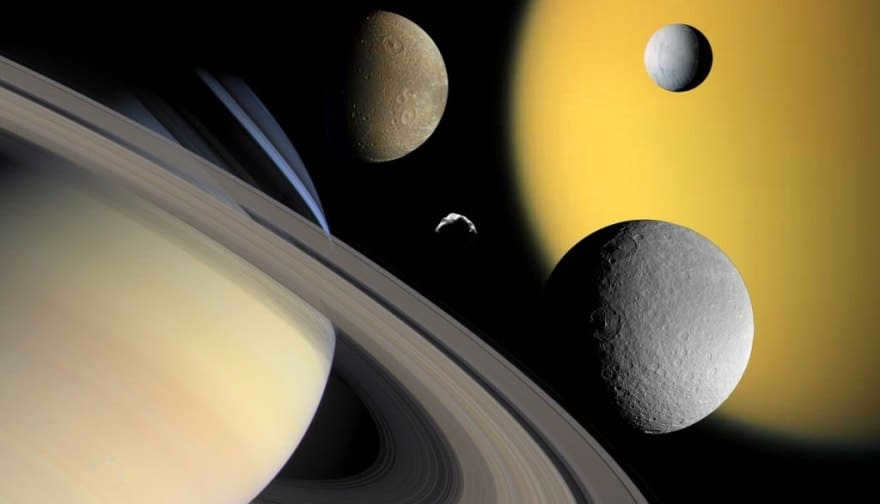
The planet Saturn, located at the bottom left of the image, is surrounded by several of its moons. These moons include Titan, Enceladus, Giona, Rhea, and Helen.
In 1848, a moon of Saturn was discovered and given the name Hyperion. The name was suggested by Lassell, who referenced one of the titans from Greek mythology. As the number of moons discovered increased in the 20th century, the tradition of naming them after titans ran out. Instead, moons began to be named after heroes from Roman and Greek mythology.
Large satellites within the inner region
Every moon is home to families of inhabitants. The inner satellites stand out for their minimal orbital inclination and eccentricity, and their orbits follow a prograde direction. In contrast, the irregular satellites are located further away, with their orbital trajectories spanning multiple years.
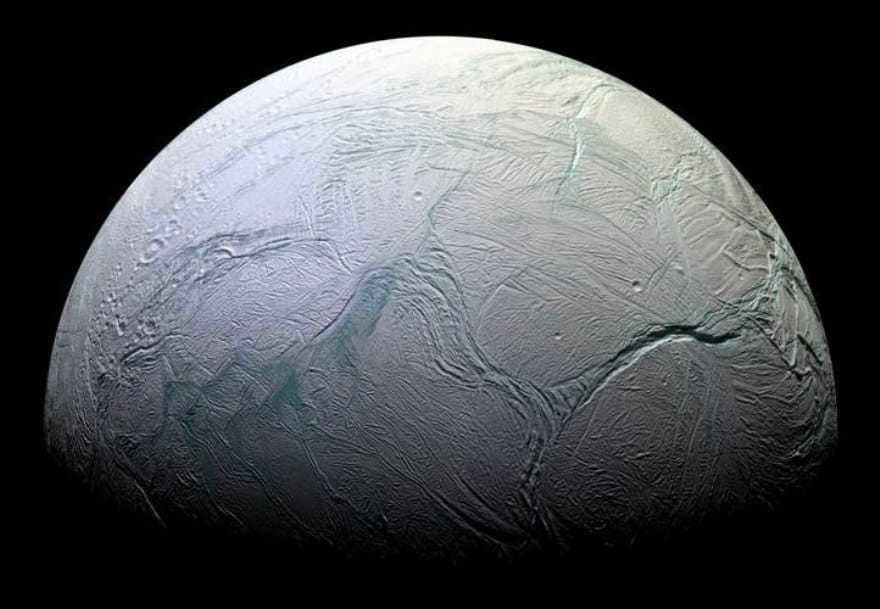

The inner satellites of Saturn, located within the E-ring, consist of Mimas, Enceladus, Tethys, and Dione. These satellites are primarily composed of water ice and may have a rocky core, icy mantle, and crust. The smallest of these satellites is Mimas, which has a diameter of 396 km and a mass of 0.4 x 10^20 kg. Mimas has a unique shape resembling an egg and orbits at a distance of 185,539 km from Saturn, completing one orbit every 0.9 days.
Mimas is often referred to as the “Death Star” due to its crater, which bears a resemblance to an object from the Star Wars franchise. The Herschel crater on Mimas spans 140 kilometers and covers three-quarters of the satellite’s diameter. It is believed that this crater may have caused fractures on the opposite side of Mimas.
In the southern polar region, there have been observations of significant geysers. These powerful jets play a crucial role in replenishing the E ring and hold immense importance as they potentially reveal the existence of life on Enceladus. This is due to the fact that the water originates from a subterranean ocean.
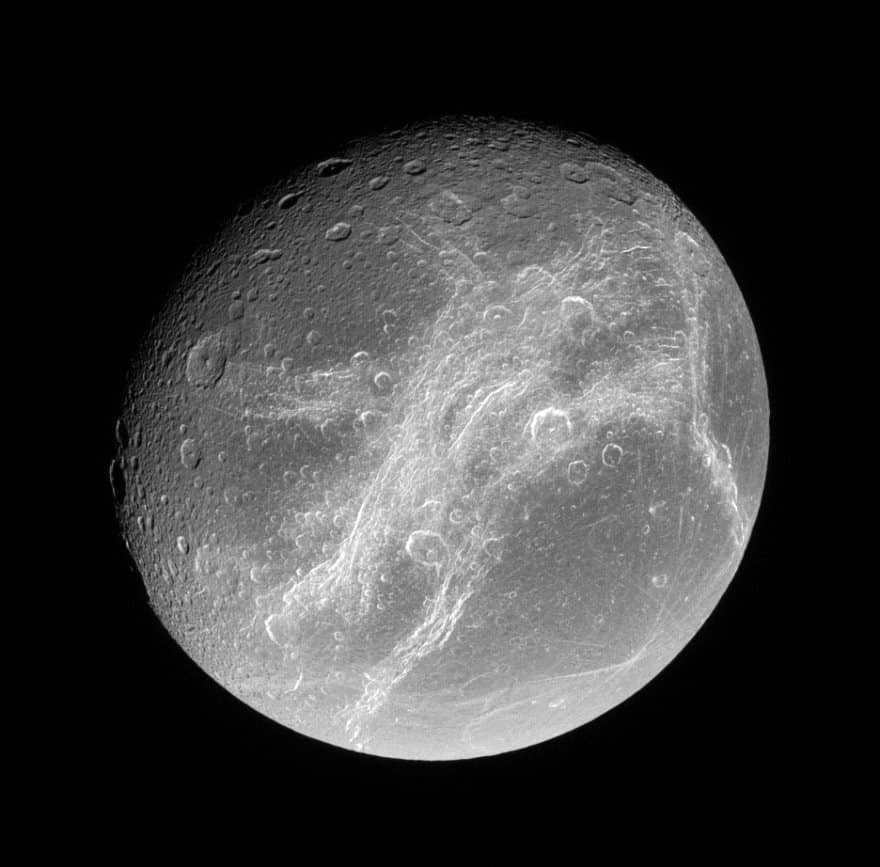
Displaying the whisper spots, the hemisphere of Dione is showcased.
With less than 100 million years of geologic activity, the satellite exhibits five different types of terrain. With an albedo of 140%, it stands out as one of the brightest objects within the system.
Seek guidance from a skilled tarot reader to gain answers to the following inquiries:
What does the future hold for you? How will your relationships unfold? What choices should you make?

Tefia, with a size of 1066 kilometers, is Saturn’s second largest moon. The majority of its surface is covered in craters and hills, with a few plains scattered throughout. One notable feature is the Odyssey crater, which spans 400 km. Additionally, there is a system of canyons that extends 2000 km, with depths reaching 3-5 km and a width of 100 km.
Dione, the largest inner moon, measures 1112 km in diameter and has a mass of 1.1 x 10 20 kg. Its surface not only bears the marks of ancient impacts, but also shows signs of past geological activity. Some craters on Dione can reach a diameter of 250 km.
Main outer moons
The main outer moons are situated beyond the E-ring and consist of a combination of water ice and rock. One of these moons is Rhea, which has a diameter of 1527 km and a mass of 2.3 x 10 20 kg. It orbits at a distance of 527,108 km from Saturn and completes one orbit every 4.5 days.
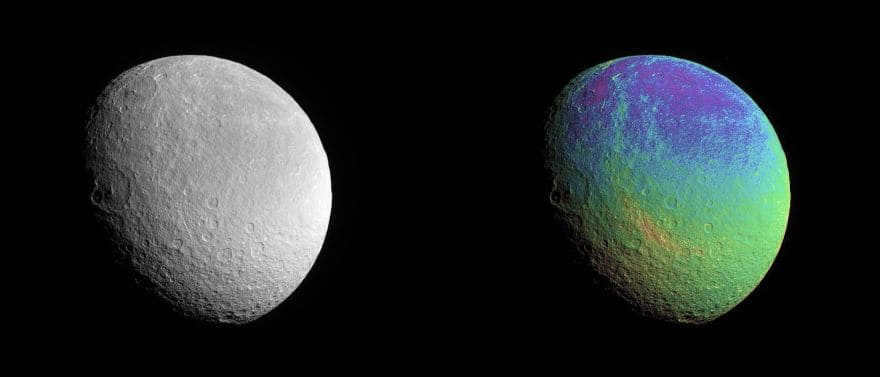

In addition to craters, the surface of Saturn’s satellite Rhea is also marked by numerous large faults on its posterior hemisphere. The satellite boasts two expansive impact basins, measuring 400-500 km in diameter. There are also two distinct types of craters: small ones and those with diameters exceeding 40 km.
Titan, the largest satellite of Saturn, has a diameter of 5,150 km and a mass of 1.35 x 10^20 kg (accounting for 96% of the total orbital mass). It stands out as the only major moon to possess its own atmospheric layer, which is characterized by its low temperature and high density, containing significant amounts of nitrogen and methane. Additionally, there are traces of hydrocarbons and methane ice crystals present.
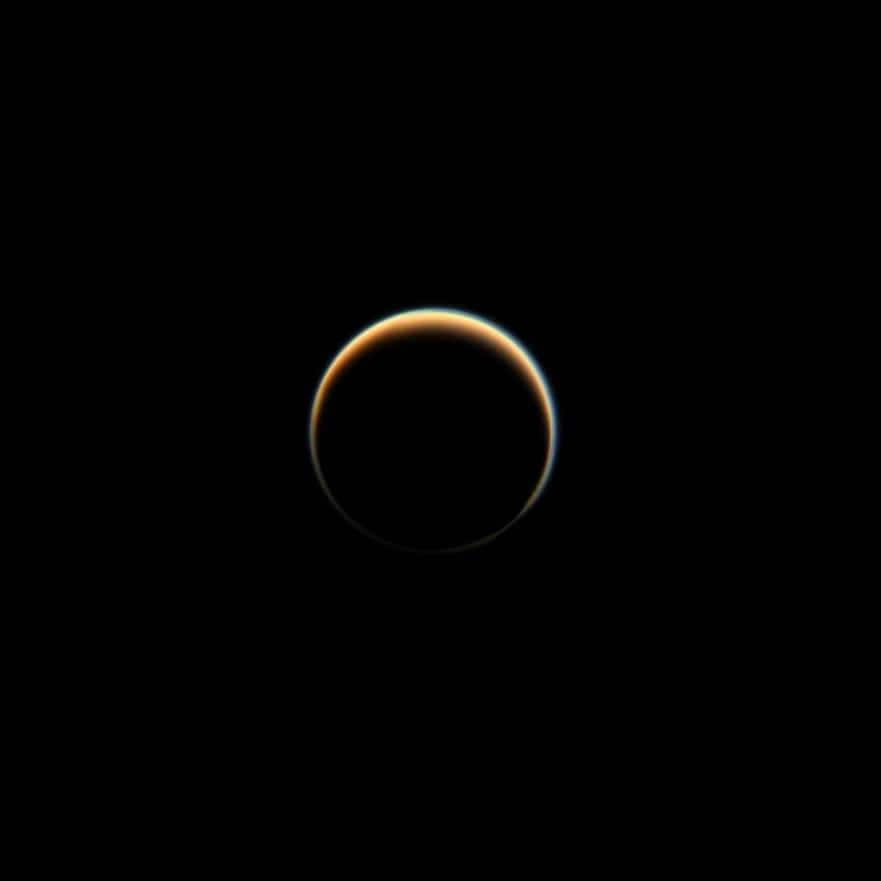
Titan was photographed by the Cassini spacecraft.
Huygens, sent from the Cassini spacecraft, landed on Titan, which is also its largest satellite. Methane rains are among the weather patterns observed on Titan.
Located near Titan is Hyperion, the second largest moon in terms of size and mass after Mimas. With a diameter of 270 kilometers, Hyperion has an egg-shaped brown appearance, resembling a sponge due to its crater-like surface (2-10 km in diameter). It does not have a predictable rotation.
Japet has a length of 1470 km and a mass of 1.8 x 10^20 kg. It is the most distant moon, located at a distance of 3,560,820 km, which causes it to have an orbital period of 79 days. It has an interesting composition, with one side being darker and the other side being lighter. This difference in appearance gives it the nickname “yin and yang.”
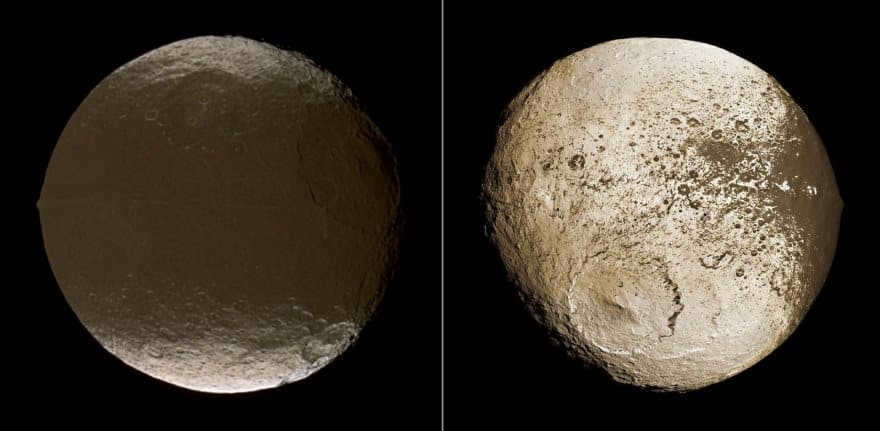
Irregular moons
Following are the irregular moons of Saturn. They are small and have retrograde orbits. They can be categorized into three groups: Inuit, Gallic, and Norse.
The Inuit group consists of 5 moons named after Inuit mythology: Ijirak, Kiviok, Paliak, Siarnak, and Tarkek. They orbit in a prograde direction at distances ranging from 11.1 to 17.9 million km. Their diameters range from 7 to 40 km. Their orbital inclinations are between 45 and 50 degrees.
The Gallic family comprises the outer moons: Albiorix, Befin, Erripo, and Tarvos. They orbit at distances of 16 to 19 million km, with an inclination ranging from 35 degrees to -40 degrees. Their diameters range from 6 to 32 km, and they have an eccentricity of 0.53.
An experienced tarot reader will provide answers to your questions:
What does the future hold for you? How will your relationships pan out? Which choice is the correct one?

A group of 29 retrograde moons exists in Scandinavia. They have diameters ranging from 6-18 km and are located at distances of 12-24 million km from their reference point. Their inclinations range from 136-175 degrees, and their eccentricities vary from 0.13-0.77. These moons are sometimes known as the Thebes family, named after the largest satellite in the group, which has a diameter of 240 km. The next moon in the group is Imir, which has a diameter of 18 km.
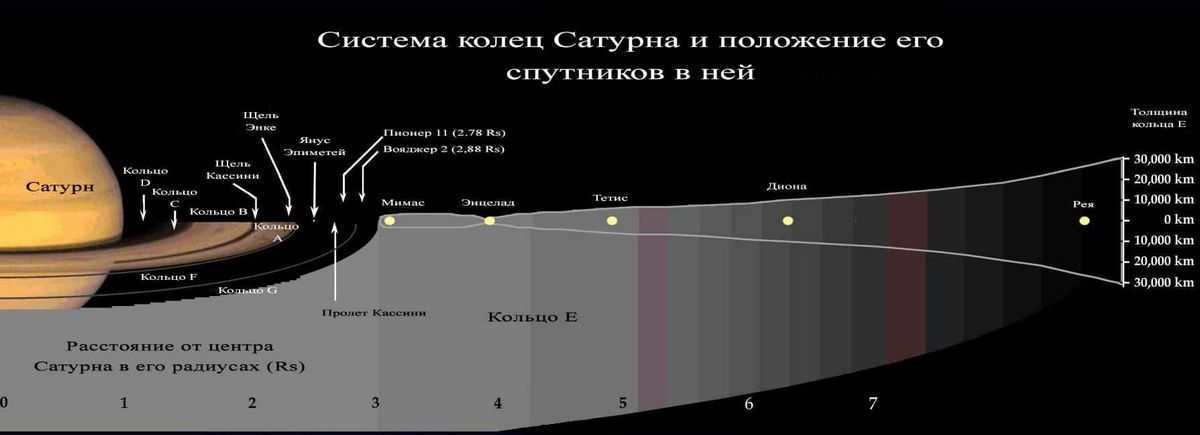

The rings and satellites of Saturn
Within the region between the inner and outer moons, there is a collection of celestial bodies known as Alcoinids, which include Mephon, Anfa, and Pallene. These particular satellites are the smallest ones orbiting Saturn. Additionally, some of the larger moons have their own smaller satellites. For example, Tephias has Telesto and Calypso, and Dione has Helena and Polydevcus.
Origin
The formation of Saturn’s moons is believed to have occurred through two main processes. Firstly, the regular moons are thought to have originated from the near-planetary disk. However, the irregular moons have a different origin story. They are believed to have been influenced by Saturn’s gravitational pull and ended up in distant orbits. There is also an alternative theory that suggests the irregular moons were formed as a result of a collision between two large satellites, which ultimately led to the creation of Titan. This collision caused numerous icy fragments to scatter in space, some of which became moons. Nonetheless, the exact scenario of moon formation on Saturn remains unknown.
Saturn’s lunar system is incredibly vast, and there is a significant amount of debris in orbit that has the potential to become new satellites. It is important to note that our website provides a comprehensive list of Saturn’s satellites, including detailed descriptions, characteristics, and photos. By exploring this resource, you can gain a deeper understanding of the various satellites orbiting Saturn. Now you have a better idea of just how many satellites Saturn possesses.
Saturn’s Position and Movement
+7 (495) 221-76-90
Planetarium JSC © 2017. Moscow, Sadovaya-Kudrinskaya str. 5, p. 1
Saturn opposing the Sun
On August 2, 2021 at 09:06 Moscow time, Saturn will be in opposition with the Sun. The planet will have a stellar magnitude of zero and an apparent diameter of nearly 18.5 arc seconds! This presents a unique opportunity to observe the planet in great detail! Saturn is best viewed through binoculars or a telescope.
August 2021 is the perfect time to observe Saturn! It is currently situated to the right (south) of the bright Jupiter above the southern horizon. Both planets are easily visible throughout the night under clear skies.
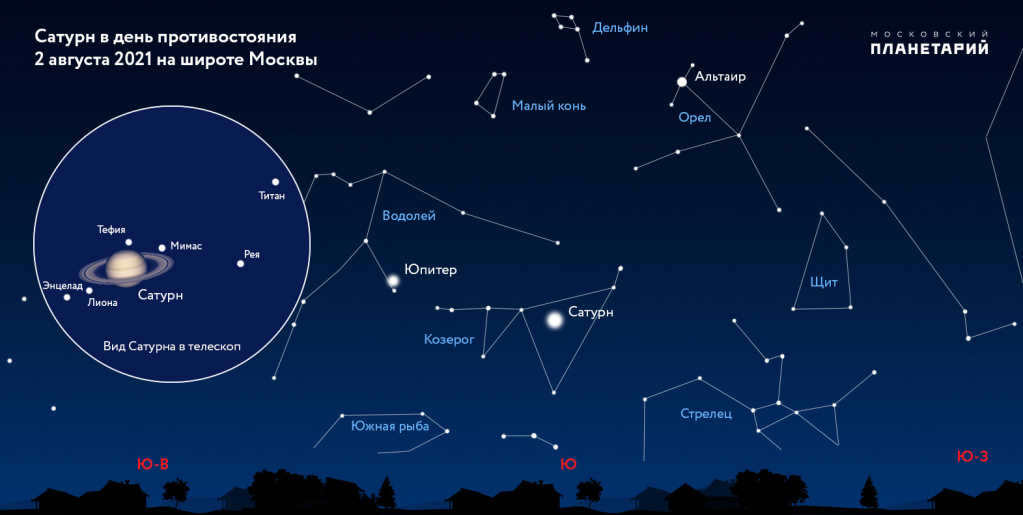
The term “opposition of planets” refers to the alignment of celestial bodies in which their centers are precisely on the same straight line, with the Earth positioned between the Sun and the planet in question.
Opposition moments are ideal for observing outer planets (from Mars to Neptune) and asteroids, as the planet is at its closest distance to Earth during this time and its disk is fully illuminated by the Sun.
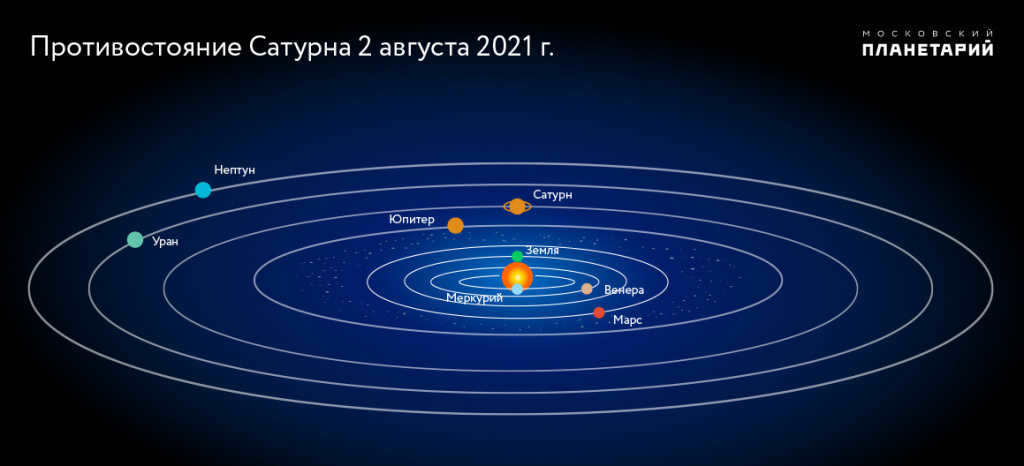
During opposition, Saturn is at its closest point to Earth and appears the brightest. It reaches its highest point in the sky at midnight and stays visible for the longest duration during the night. Additionally, Saturn’s angular size in the sky is the largest it will be for the entire year.
Observing Saturn:
Therefore, August and September offer ideal circumstances for the observation of the immense planets, Jupiter and Saturn, which will be in opposition to Saturn on August 2 and Jupiter on August 20.. The planets are in close proximity and during August, they can be easily seen from late afternoon until the early hours of the morning, reaching their highest point above the southern horizon shortly after midnight.
Saturn is currently positioned in the constellation Capricorn and can be seen in the evening and at night, appearing low above the southern horizon. It is situated to the right (south) of the bright planet Jupiter. During the month of August, Saturn becomes visible after 9:00 PM and reaches its highest point in the sky after midnight. In regions with moderate latitudes, Saturn’s maximum elevation above the horizon is limited to 16 degrees at midnight. On August 2nd, the planet will be in opposition to the Sun. With a sidereal magnitude ranging from +0.2 to +0.3, Saturn shines brightly in the sky. It has an apparent diameter of 18.6 to 18.3 arc seconds, and its rings span approximately 43 arc seconds in width.
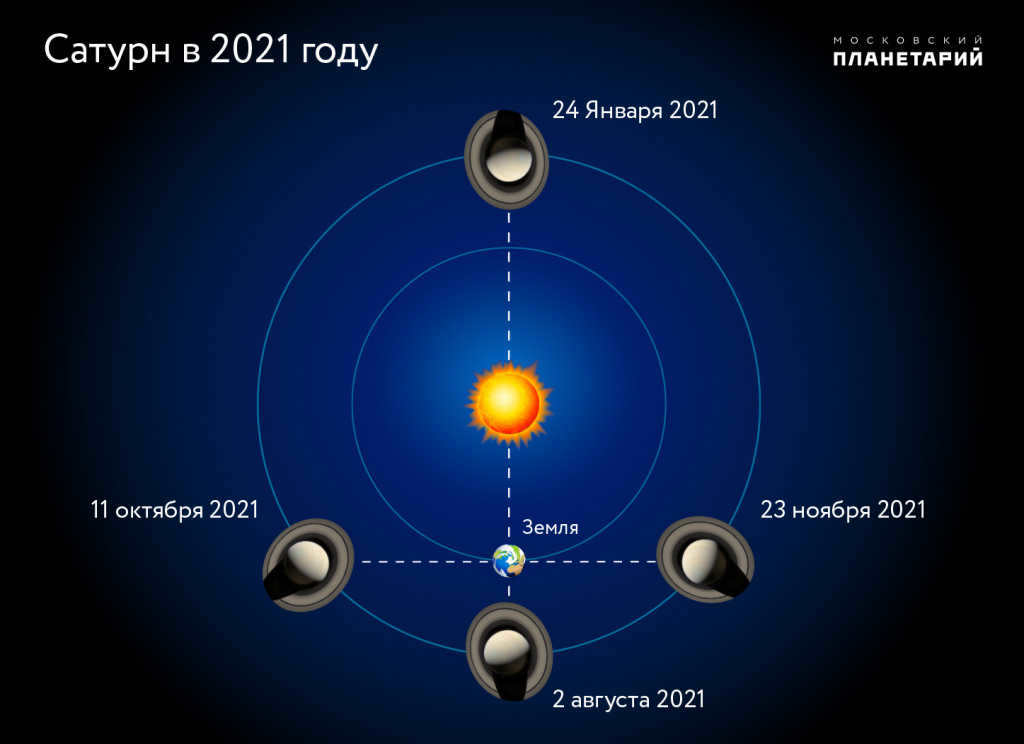
Saturn’s positions in 2021:
On January 24, 2021, Saturn will be in conjunction with the Sun.
On May 25, 2021, it will start moving sideways across the sky.
On August 2, 2021, it will be in opposition to the Sun.
On October 11, 2021, it will transition to direct motion.
Saturn’s oppositions occur every year and repeat every 378 days. On August 2, 2021, Saturn will be 8.94 astronomical units away from Earth (1337404964 km).
After the October 11, 2021, transition, Saturn will gradually approach the Sun in the sky, resulting in shorter observing hours. By late fall, Saturn will appear in the evening sky and will no longer be visible to the naked eye by mid-January 2022.
Observing Saturn through a telescope:
When using a telescope, one is able to witness the magnificent rings of this giant planet, and out of its impressive collection of 82 satellites, only the largest one, Titan, can be easily spotted with amateur equipment. Titan. The rings of Saturn are currently in a position where they are almost fully open when viewed from Earth, but over time, their visibility will gradually decrease. In the year 2021, it will be possible to obtain a clear view of Saturn’s northern pole through a telescope.
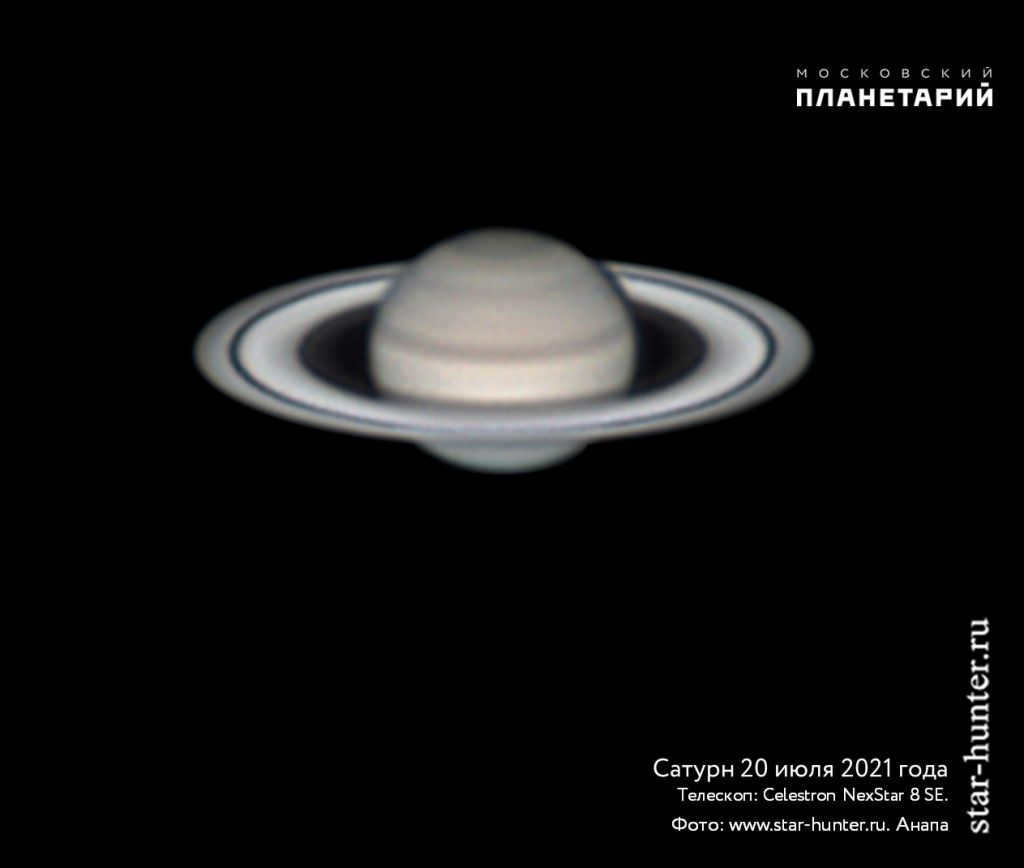
The Phenomenon of Saturn’s Rings
The rings of Saturn are currently in a state of maximum opening, making them visible in almost any amateur telescope when observed from Earth. In 2016, the rings reached their maximum angle of opening, coinciding with the best visibility of Saturn’s north pole. However, the rings are now beginning the reverse process, gradually decreasing their angle of opening until 2024. The appearance of the rings undergoes changes from year to year due to their tilt of 26 degrees relative to the ecliptic plane.
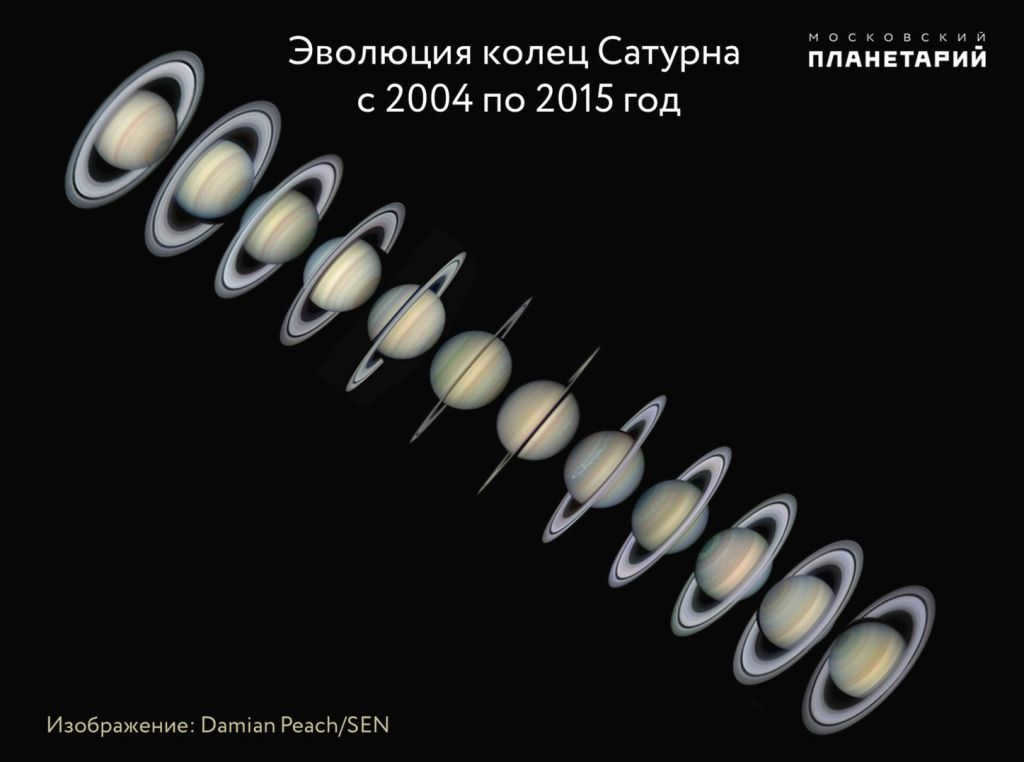
When the observer is positioned exactly in the plane of the rings, the rings become invisible. This occurrence takes place twice during Saturn’s complete orbit around the Sun, which happens every 13.75 and 15.75 years. The latter occurrence of the rings disappearing was recorded in 2009, and the next one will be in 2024. From 1995 to 2008, we had the opportunity to observe the south pole of the planet, and now, until 2023, we will have a clear view of Saturn’s north pole and the side of its rings that is facing us.
Therefore, during the opposition and throughout the summer and autumn of 2021, there is a great opportunity to observe Saturn’s north pole.
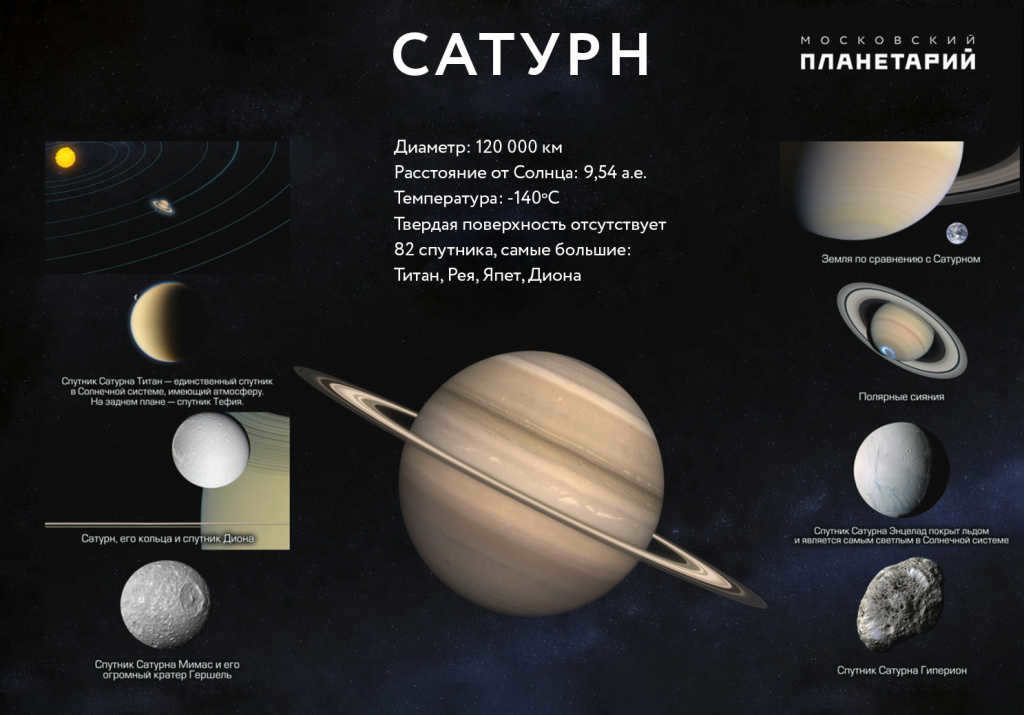
Saturn is a celestial body consisting mainly of hydrogen, along with helium and small amounts of water, methane, ammonia, and other heavy elements. Unlike Earth, Saturn does not have a solid surface and is considered a gas giant. It is located at a significant distance from Earth and can be observed without the need for a telescope. In terms of size, Saturn is much larger than our planet, with a mass equivalent to 95 Earths.
When observing Saturn through a telescope, one can observe the presence of yellow and gold streaks in its atmosphere. These streaks are caused by extremely fast winds in the upper atmosphere, reaching speeds of up to 2,000 kilometers per hour.
In its journey around the Sun, Saturn takes approximately 29.5 Earth years to complete one orbit. On Saturn, a day lasts about 10 hours and 34 minutes, which is the time it takes for the planet to make a full rotation on its axis relative to the stars.
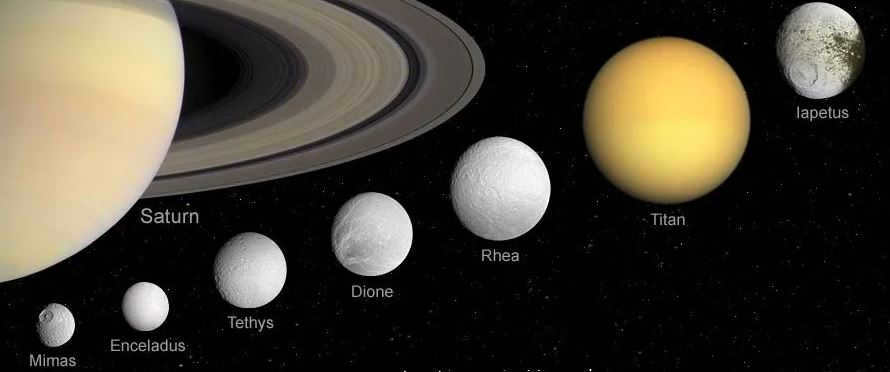
Saturn has built an expansive network of satellites around itself, unveiling its numerous enigmas and continuously astonishing researchers with novel discoveries. In 2017, a mere 30 moons were identified; however, by 2022, the count has escalated to 83. This remarkable figure sets a record for the highest number of satellites in the entire solar system, and there is potential for it to surpass itself in the future.
Types of Species
Saturn, like other giant planets, has two main categories of species: regular and irregular. In 2006, a new kind of species called miniluns was discovered.
Regular Species
These celestial bodies were formed from the native matter of Saturn, which consisted of materials from the gas-dust disk during its expansion. The material that escaped gravity eventually became a regular species.
Regular species are located relatively close to Saturn, orbit in the same direction as the planet, and have a slightly elongated and circular orbit.
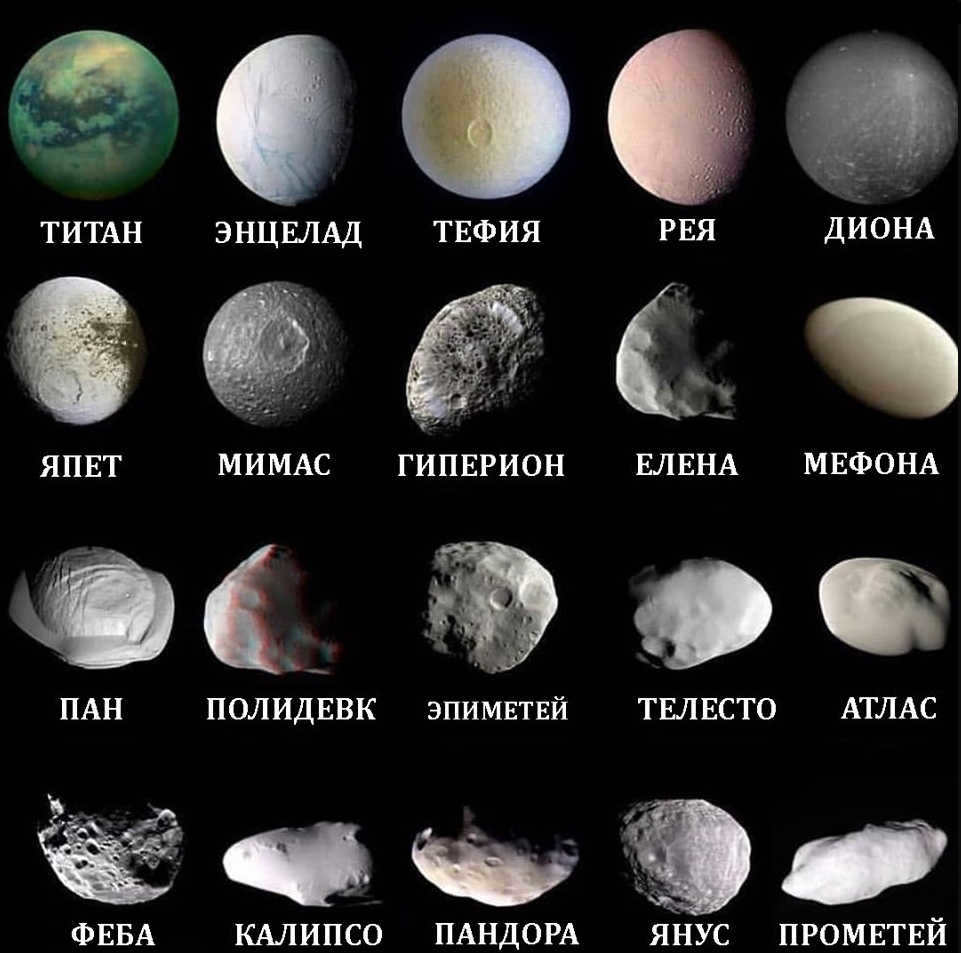
Saturn has a total of 24 regular satellites. These satellites can be categorized into different groups:
- There are four small satellites known as the “Trojan planets”.
- There are two satellites that form a “coorbital system” with double satellites.
- There are two “shepherds”, Pandora and Prometheus, which orbit near the rings and prevent particles from escaping.
- There are two satellites, Pan and Daphne, located inside the rings, which create gaps and waves at the edge.
All of these regular satellites are named after characters from Roman and Greek mythology, including Rhea, Hyperion, Diana, Calypso, and others.
Irregular Satellites of Saturn
The irregular satellites of Saturn are a unique group of moons that have a fascinating history. Unlike the regular moons of Saturn, which follow a more predictable and circular orbit, these irregular satellites have a larger and highly elongated orbit. This means that their path around Saturn is not symmetrical and can take them far away from the planet.
These irregular satellites can also rotate in different directions. Some of them move in the same direction as Saturn’s rotation (prograde), while others move in the opposite direction (retrograde). This makes them distinct from the regular moons, which all orbit in the same direction.
In total, there are 59 known irregular satellites orbiting Saturn. This diverse group includes both dwarf planets, which can be up to 200 km in diameter, and tiny satellites that measure just 4 km across. Their different sizes and compositions make them an interesting subject of study for scientists.

There are three distinct categories of irregular satellites orbiting Saturn: Inuit, Nordic, and Gallic:
- The Inuit group consists of satellites with rounded orbits that have an inclination angle of approximately 46 degrees. These satellites complete one full orbit around Saturn in a period of 2 years;
- The Gallic group includes satellites with similar elliptical orbits that have an angle ranging from 45 to 40 degrees;
- The Nordic group encompasses retrograde satellites. The celestial bodies in this group exhibit variations among themselves, and it is possible to distinguish several subgroups, such as Skadi and Narvi, within this category.
The moons within these groups must be named after gods or other characters from the respective religions. The only exceptions are the companion of Phebus (from Greek mythology), which was the first to be discovered within the entire Nordic group, and Befind (from the Gallic group, named after a goddess from Irish mythology).
In 2019, the team led by scientist Scott Sheppard launched a competition to name 30 unnamed satellites. Participants were required to suggest a suitable name and provide a justification for why it was appropriate for a specific satellite. Although the competition concluded later that year, most of the satellites remain without an official name.
Miniluns
can be paraphrased as “Small Moons”.
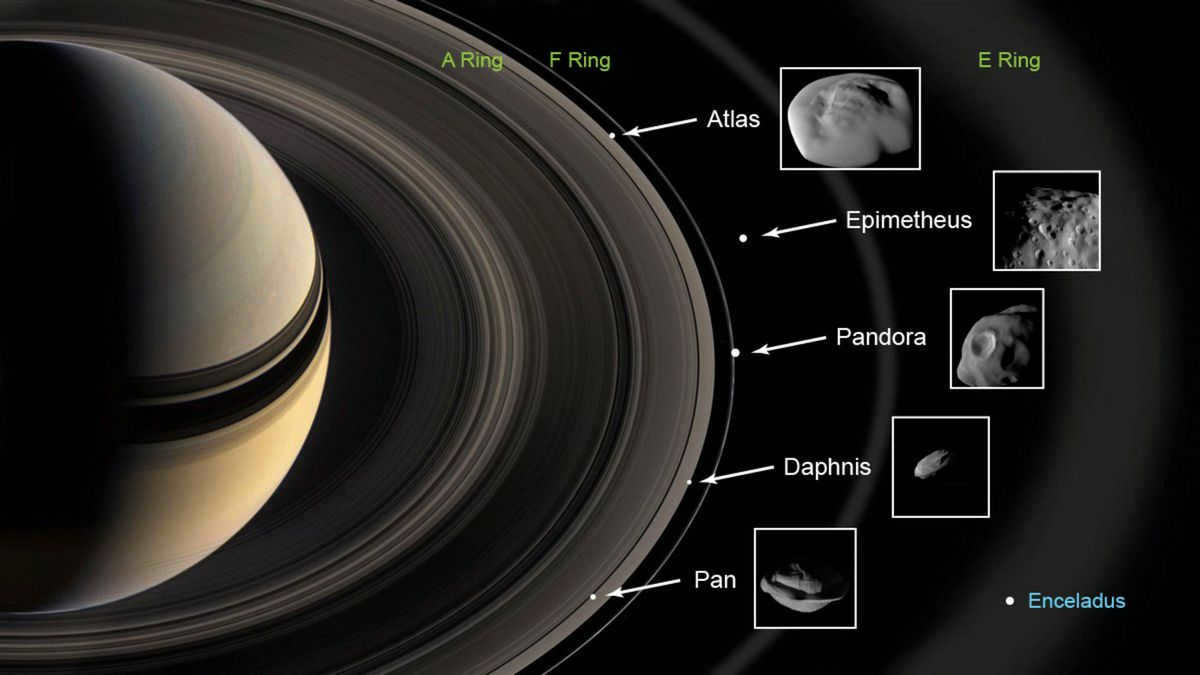
Within the rings of Saturn, there exist objects of sufficient size to establish their own orbit, yet too small to form “gaps”. These objects are referred to as “minilunes”. They possess a diameter of approximately 100 meters.
When viewed from the side, minilunes bear a resemblance to a propeller due to the rapid rotation of space debris within the orbit, in contrast to the slower rotation of the minilune itself and the material outside its orbit. In photographs, the minilunes themselves are often imperceptible, with only their “propeller” visible.
Currently, 12 minilunes have been discovered, but researchers estimate that there may be approximately 10 million of these objects within the depths of the rings.
The discovery of minilunes holds immense significance as it has the potential to unravel the enigma surrounding the formation of the rings: whether they originated alongside the planet or emerged from the remnants of another disintegrated celestial body.
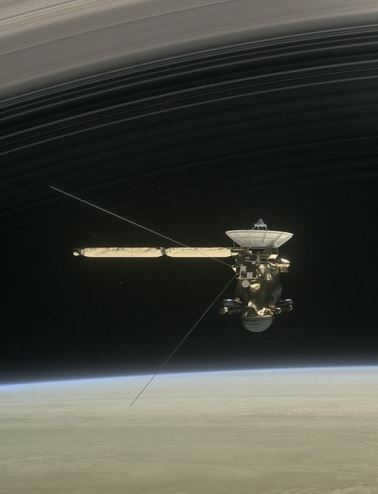
Space exploration missions are carried out using automated interplanetary stations to investigate the planet Saturn, its rings, and moons. The initial AMS mission captured images of Saturn in 1979. Subsequently, a number of additional stations and probes have been launched into space.
The launch of the Cassini station in 1994 proved to be a pivotal moment in the study of Saturn’s moons. Utilizing its advanced imaging capabilities, Cassini captured numerous photographs of the planet’s majestic rings. Furthermore, while in orbit around Saturn, the station conducted research on the atmospheres and geological features of its moons.
The Huygens probe, deployed from the Cassini station, successfully collected samples from the surface of Titan. This groundbreaking mission enabled the creation of detailed maps of Titan, as well as the analysis of its atmospheric composition. Additionally, the probe transmitted an awe-inspiring photograph of the distant landscape back to Earth, marking a significant achievement in interplanetary exploration.
The variety of satellites
Saturn is surrounded by an array of remarkably diverse satellites. These satellites vary from one another in terms of their composition, size, shape, surface features, and even the presence of an atmosphere. Each individual satellite holds great significance for scientists due to its unique characteristics.
The biggest and the tiniest


Titan, the first moon of Saturn to be discovered, is the second largest satellite in the entire solar system. The only moon larger than Titan is Ganymede, which is a moon of Jupiter. Titan’s mass is equivalent to 95% of the combined weight of Saturn’s other 82 satellites!
The smallest satellites of Saturn, excluding the mini moons, have a diameter of approximately 4 kilometers.
Extraordinary forms
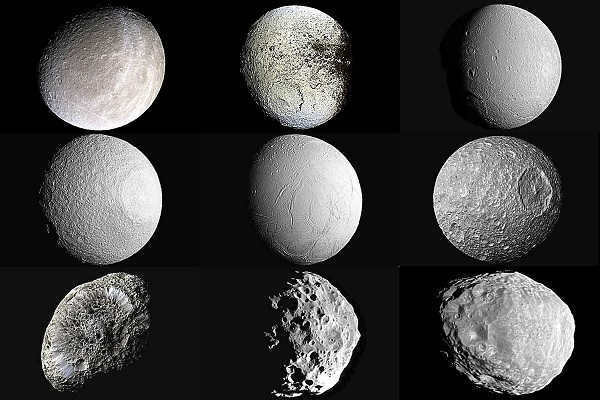
Mimas, a regular satellite, takes pride in its perfectly spherical shape. What’s even more impressive is that it holds the title for being the smallest spherical celestial body in the entire Solar System!
In contrast, Pan can hardly be described as perfect: this small satellite’s shape resembles that of a dumpling. And the round Tefia has gathered a pair of Trojan moons, Calypso and Telesto, which bear a striking resemblance to elongated river stones.
Engrossing for the scientific community
Titan
Practically everyone has been introduced to the concept of an extraordinary moon resembling our beloved planet Earth. Titan possesses sufficient gravitational force to maintain a thick atmosphere composed of methane and nitrogen. Experts argue that it bears a striking resemblance to Earth during its nascent stages of development.
The advancement of investigations has enabled researchers to propose the possibility of life originating within the depths of this celestial object; nevertheless, this theory has yet to be substantiated.
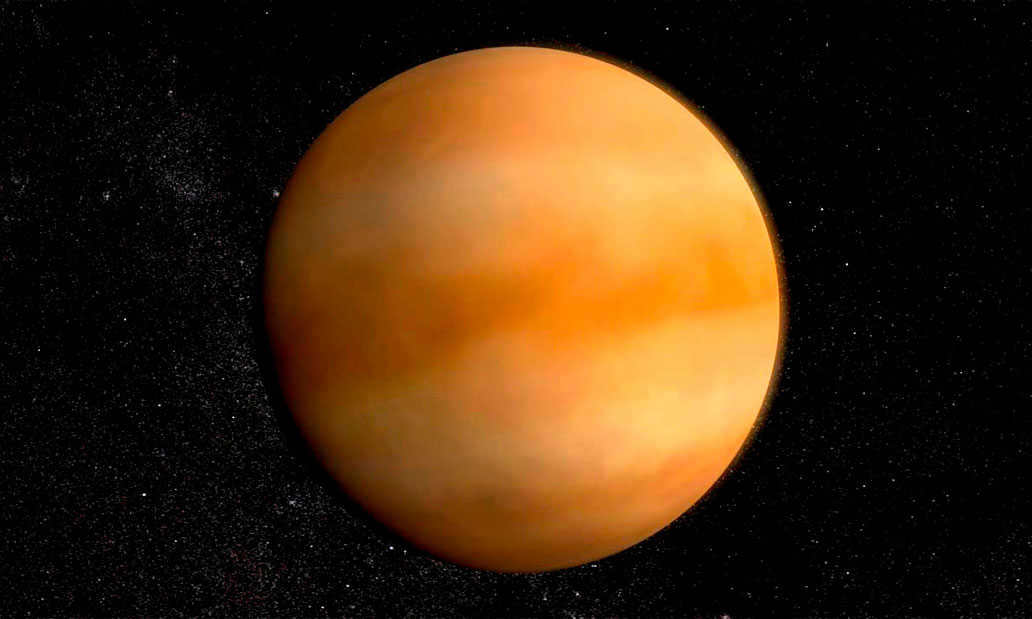
Titan is covered in mountain chains, seas, and oceans. The majority of water bodies can be found at the poles, while the equatorial region resembles a barren desert. Instead of water, the seas and oceans are filled with a liquid composed of methane. This liquid undergoes a continuous cycle of circulation in the atmosphere, precipitation, evaporation from the surface, and accumulation as clouds.
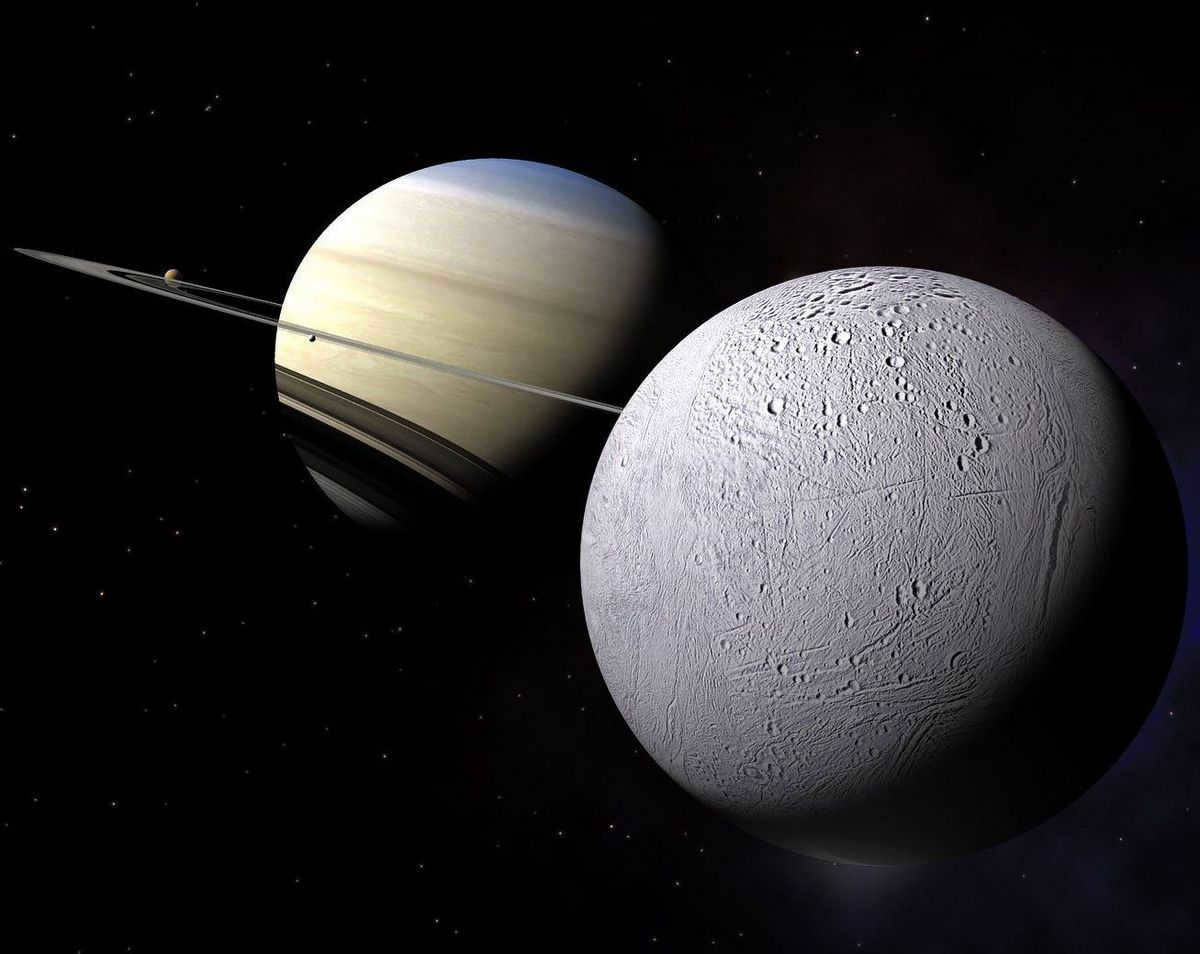
Enceladus is the true contender when it comes to the emergence of organic life. The young satellite is surrounded by water molecules, and it has been confirmed that Enceladus is the source of this water.
When scientists approached Enceladus to study its atmosphere, they made an interesting discovery. They found that the atmosphere was composed of water in various states mixed with organic material. This material was scattered around the satellite and was even coming out of cracks at the south pole.
This groundbreaking discovery has shown the scientific community that life can originate not only on the surface of a celestial body, like Earth, but also within it.
Japet
Renowned for its perpetual one-sided orientation towards Saturn, akin to the Moon’s eternal gaze upon Earth. One hemisphere remains shrouded in darkness, reflecting a mere 3% of incident light, while its illuminated counterpart mirrors an astounding 60% and stands as one of the most luminous terrains within the entire solar system.
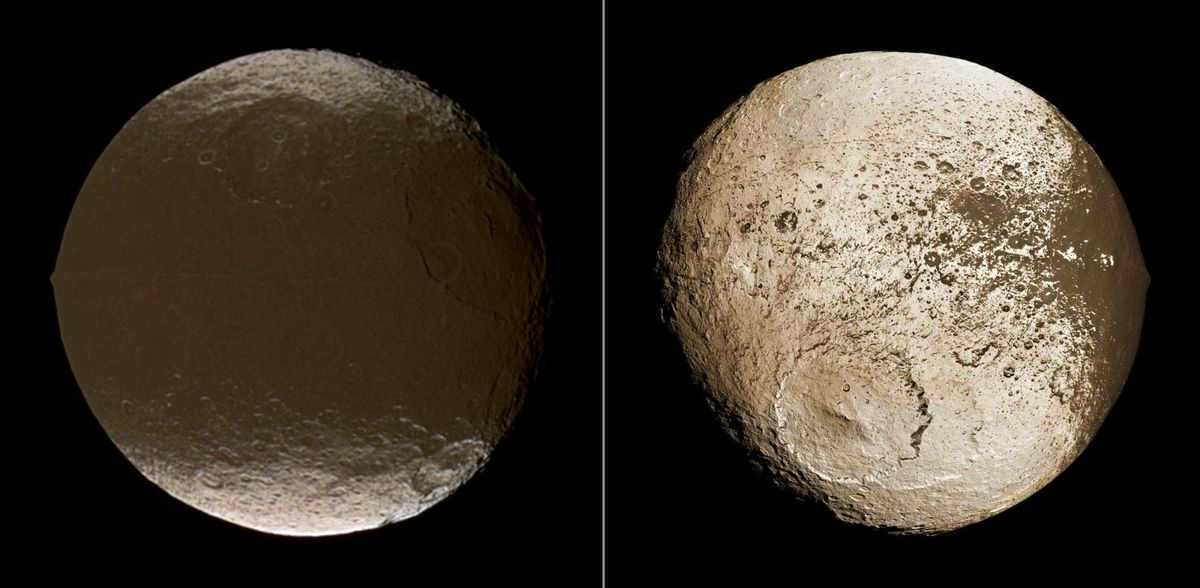
The surface of Japet exhibits a diverse composition, displaying dark and light patches on its distinct hemispheres, implying that it is predominantly comprised of water ice with a minor presence of soil.
Japet stands as the sole sizable satellite that offers a glimpse of Saturn’s rings. This extraordinary spectacle is made possible due to its elongated orbit, which is twice the length of any other regular satellite, and its inclination angle of 46 degrees.
Mimas
is a moon of Saturn. It was discovered in 1789 by the astronomer William Herschel. Mimas is the smallest and innermost of Saturn’s major moons, and it is named after a Titan from Greek mythology. Mimas is known for its resemblance to the Death Star from the Star Wars movies, due to a large impact crater called Herschel that gives it a distinct appearance. The crater is about 130 kilometers wide, which is approximately one-third the diameter of the moon itself. Mimas has a relatively low density, suggesting that it is mostly composed of water ice with a small rocky core. Its surface is covered in craters of various sizes, indicating a long history of impacts. Mimas is also notable for its orbital resonance with another moon of Saturn, Tethys, which causes a gravitational tug that creates a wavy pattern on its surface. Despite its small size, Mimas has a significant effect on the structure and dynamics of Saturn’s rings. Overall, Mimas is a fascinating moon that continues to captivate scientists and space enthusiasts alike.
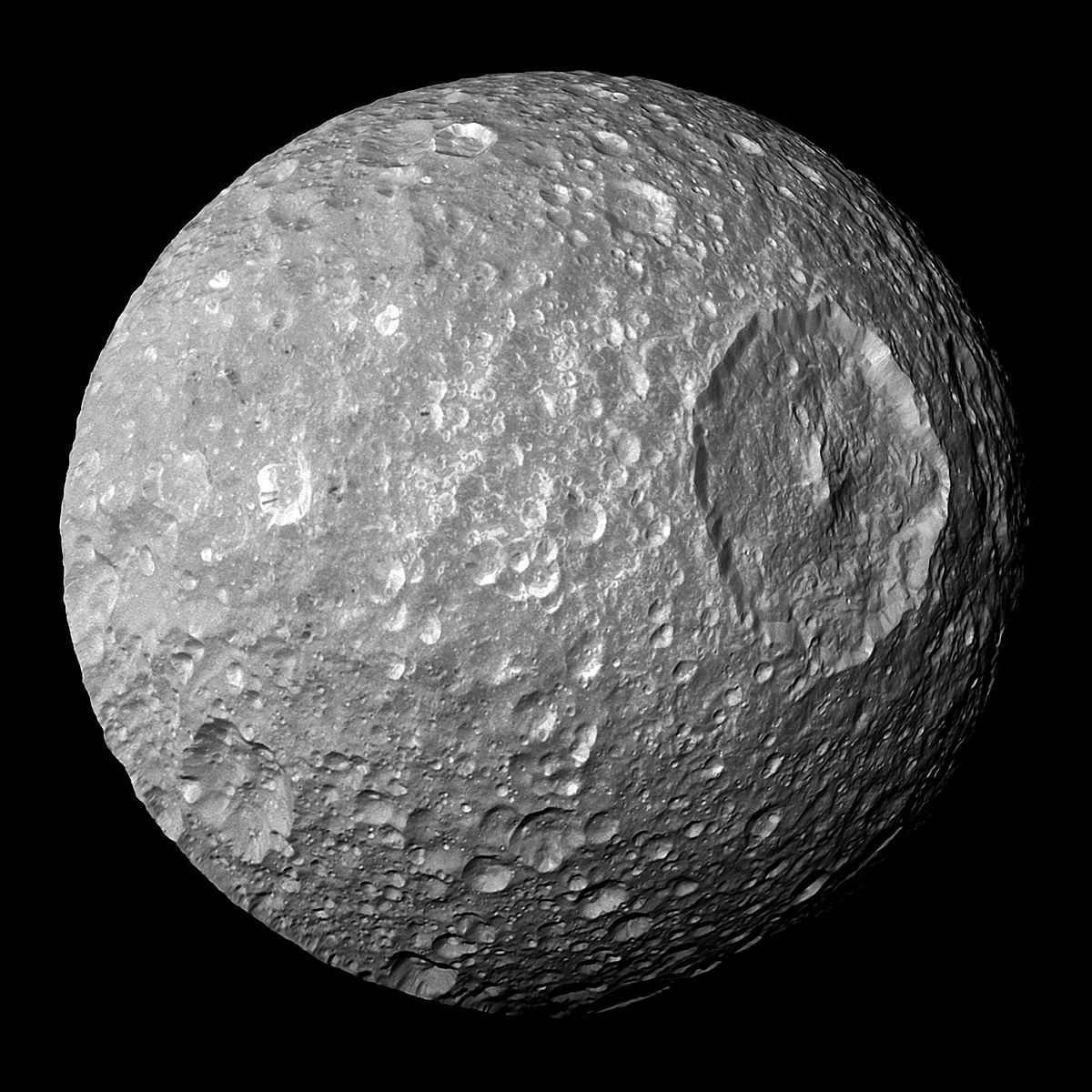
The small satellite, measuring 400 km in diameter, possesses a mysterious quality. It bears a breach in its surface, spanning an impressive 130 km.
The impact of the asteroid that transported Mimas was so powerful that it caused cracks on the opposite side of the crater. The rim of this crater surpasses the height of Earth’s Mount Everest, while the central mountain within it is even taller than Mount Kilimanjaro. A comparable crater on Earth could engulf the entire expanse of Russia.
This incredibly resilient companion has left an opening in Saturn’s ring as it ventured deep into its core. Currently, it continues its journey, ascending from within the ring to the outer realms.
Frequently Asked Questions
Aside from the current projects, there are numerous upcoming missions in the pipeline. There is also a demand for researchers to analyze the collected data. The field of space exploration is always open to young and talented scientists.
Investigating distant moons is crucial in order to gain a better understanding of the arrangement of celestial bodies, including our own planet. Saturn’s moons possess a unique potential for unveiling new forms of extraterrestrial life.
New satellites are being identified almost on an annual basis, and it is highly probable that more will be discovered in the future.
The study of Saturn’s moons is an ongoing process, with new discoveries being made every year. These findings often significantly expand our previous understanding of the world.
When scientists discuss “life,” they are referring to intricate organic compounds. The idea of uncovering bacteria is quite audacious.
Exploring Saturn’s moons is a promising area of study that opens up vast possibilities for new findings. The research findings have already deepened our understanding of the laws and evolution of the universe. Perhaps one day these moons will provide humanity with the answer to the enigma of life’s origin.
Even those not involved in the field of science can access the study of Saturn’s moons through the multitude of images and reports available. Scientists can uncover astonishing space landscapes and atmospheres, experiencing them from an immense, uncontrollable distance.
Overview of Science Facts Video
Saturn, the sixth planet in our solar system, is a massive gas giant known for its iconic rings. Although the largest satellites of Saturn were first observed in the 17th century, advancements in scientific research have led to the discovery of numerous other celestial bodies orbiting this fascinating planet.
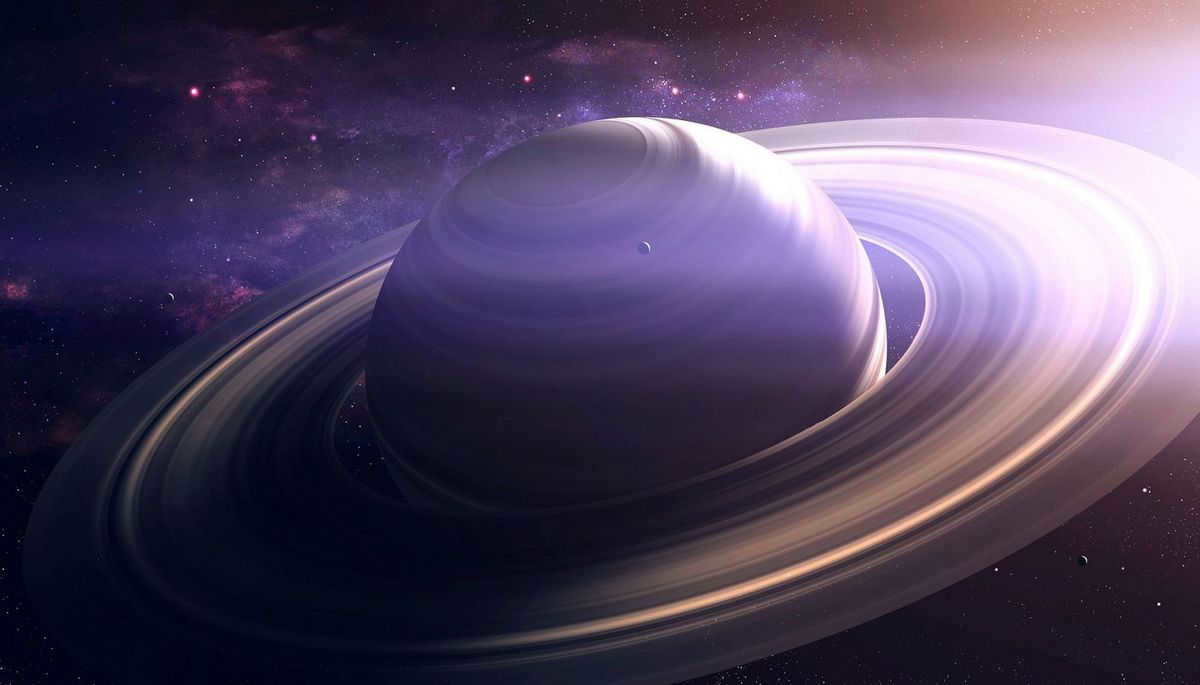
List of satellites and their characteristics
Currently, there are only 53 identified objects that have been officially named. This table provides information on the most extensively researched moons of this planet, including their astronomical designations, mass, diameter, and more.
| № | Name | Mass (kg) | Diameter (km) | Major semi-axis (km) |
| 1 | Mimas | 3.7e19 | 397 | 185600 |
| 2 | Enceladus | 1.1e20 | 499 | 238100 |
| 3 | Tefia | 6.2e20 | 1060 | 294700 |
| 4 | Dione | 1.1e21 | 1118 | 377400 |
| 5 | Rhea | 2.3e21 | 1528 | 527100 |
| 6 | Titan | 1.3e23 | 5150 | 1221900 |
| 7 | Hyperion | 5.7e18 | 266 | 1464100 |
| 8 | Iapetus | 2.0e21 | 1436 | 3560800 |
| 9 | Theba | 8.3e18 | 240 | 12944000 |
| 10 | Janus | 1.9e18 | 178 | 151500 |
| 11 | Epimetheus | 5.3e17 | 119 | 151400 |
| 12 | Helen | 2.5e15 | 32 | 377400 |
| 13 | Telesto | 7.2e15 | 24 | 294700 |
| 14 | Calypso | 3.6e15 | 19 | 294700 |
| 15 | Atlas | 6.6e15 | 32 | 137700 |
| 16 | Prometheus | 1.6e17 | 100 | 139400 |
| 17 | Pandora | 1.4e17 | 84 | 141700 |
| 18 | Pan | 4.9e15 | 20 | 133600 |
| 19 | Ymir | 4.9e15 | 18 | 234000 |
| 20 | Paliak | 8.2e15 | 22 | 15200 |
| 21 | Tarvos | 2.7e15 | 15 | 17983 |
| 22 | Ijirak | 1.2e15 | 12 | 11124 |
| 23 | Suttung | 2.1e14 | 7 | 19459 |
| 24 | Kiwiok | 3.3e16 | 16 | 11111 |
| 25 | Mundilfari | 2.1e14 | 7 | 18685 |
| 26 | Albiorix | 2.1e16 | 32 | 16182 |
| 27 | Skadi | 3.1e14 | 8 | 15541 |
| 28 | Errpo | 7.6e14 | 10 | 17343 |
| 29 | Siarnak | 3.9e16 | 40 | 17531 |
| 30 | Bilge | 2.1e14 | 7 | 20474 |
| 31 | Narvi | 3.4e14 | 7 | 190070 |
| 32 | Mefona | 1.5e13 | 3 | 194000 |
| 33 | Pallena | 3.5e13 | 4 | 211000 |
| 34 | Polydevk | 3.0e13 | 4 | 377400 |
| 35 | Daphnis | 1.5e14 | 7 | 136500 |
| 36 | Aegir | n/a | 6 | 20735000 |
| 37 | Bephindus | n/a | 6 | 17119000 |
| 38 | Bergelmir | n/a | 6 | 19338000 |
| 39 | Belsta | n/a | 7 | 20129000 |
| 40 | Farbauti | n/a | 5 | 20390000 |
| 41 | Fenrir | n/a | 4 | 22453000 |
| 42 | Forniot | n/a | 6 | 25108000 |
| 43 | Hati | n/a | 6 | 19856000 |
| 44 | Girrockin | n/a | 6 | 18437000 |
| 45 | Kari | n/a | 7 | 18437000 |
| 46 | Logie | n/a | 6 | 23065000 |
| 47 | Skoll | n/a | 6 | 17665000 |
| 48 | Surt | n/a | 6 | 22707000 |
| 49 | Anfa | n/a | 2 | 197700 |
| 50 | Jarnsaka | n/a | 6 | 18600000 |
| 51 | Grape | n/a | 6 | 18105000 |
| 52 | Tarkek | n/a | 7 | 17920000 |
| 53 | Egeon | n/a | 0.5 | 167500 |
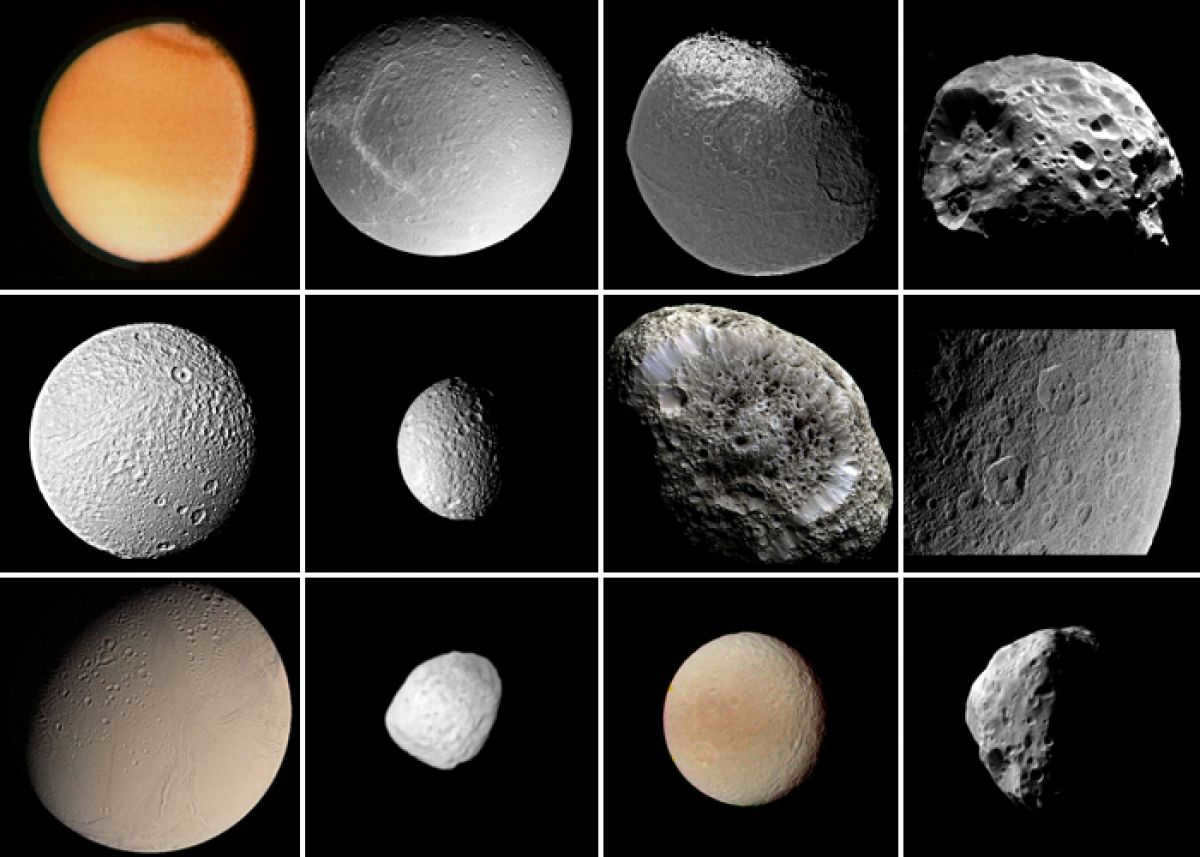

The reason why Saturn has a significant number of satellites is because of the unique formation process of this planet. These satellites can be divided into two categories: internal and external. All of them were created during the formation of Saturn and the solar system. Some of the notable external satellites include:
Titan – the largest satellite that orbits around Saturn. It has a diameter of 5,150 kilometers, making it much bigger than the Moon. It is also a high-density object. When scientists studied Titan, they discovered signs of water on its surface.
This satellite is surrounded by a dense atmosphere composed of nitrogen and other gases. The temperature in the atmosphere ranges from -170 to -180 degrees Celsius. It takes Titan approximately 16 days to complete one orbit around Saturn.
Rhea is a colossal entity that ranks among the most immense celestial bodies encircling Saturn. With a diameter measuring a staggering 1,528 kilometers, this immense giant boasts a surface adorned with a thick layer of ice. Remarkably, it is estimated that frozen water comprises a substantial one-third of Rhea’s total volume, with the remaining volume being composed of rocky material.
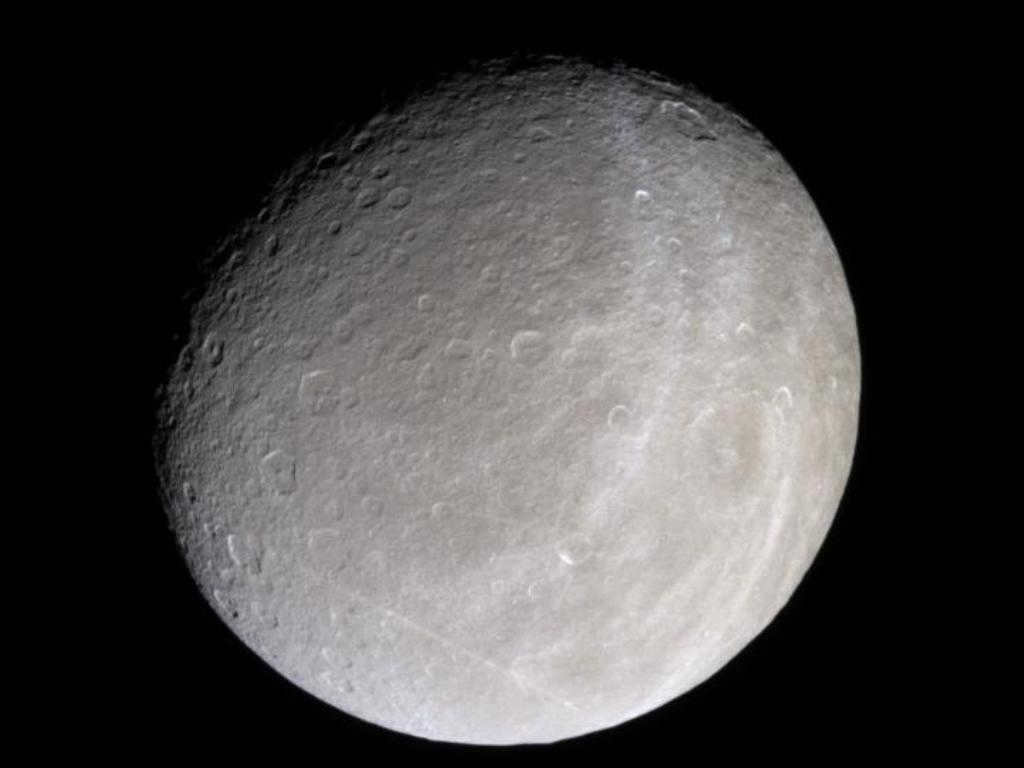

Rhea is the second largest moon of Saturn and is ranked ninth among the largest moons in the entire solar system. Credit: 1zoom.ru
The moon has an atmosphere composed of carbon dioxide and oxygen with two atoms.
Japet is the third largest moon with a diameter of 1,468 kilometers. It was previously known as Saturn VIII before being officially named. This celestial body has a low density and is primarily made up of ice. It features a mountain range along its surface, with the front side being black and the back side being white.
< p >Hyperion has smaller dimensions compared to the aforementioned bodies. It has a diameter of 360 kilometers and its rotation is characterized by chaos. Hyperion follows an elliptical orbit around Saturn. The entire surface of Hyperion is filled with meteor craters, and it is covered in a layer of ice, giving it a white appearance. The bottom of the craters contains dark-colored rock or material. It is estimated that 50% of Hyperion is composed of ice, while the other 50% consists of rocks and metal impurities.< /p >
< p >Additionally, Saturn’s satellites can be categorized as regular or irregular. Regular satellites include both internal and external objects, while irregular satellites have orbits that are not uniform. Thebes falls into the latter category and its rotation is in the opposite direction of the planetary motion.< /p >
Inner satellites
The inner satellites of Saturn consist of a variety of celestial bodies that orbit closely to the planet and maintain a stable trajectory. These include:
- Tefia;
- Dione;
- Telesto;
- Helen;
- Mimas;
- Janus;
- Calypso;
- Polydevec;
- Enceladus.
Saturn’s inner satellites, such as Tefia, Dione, Mimas, and Enceladus, always exhibit the same face towards the planet. Each of these inner satellites possesses its own unique characteristics.
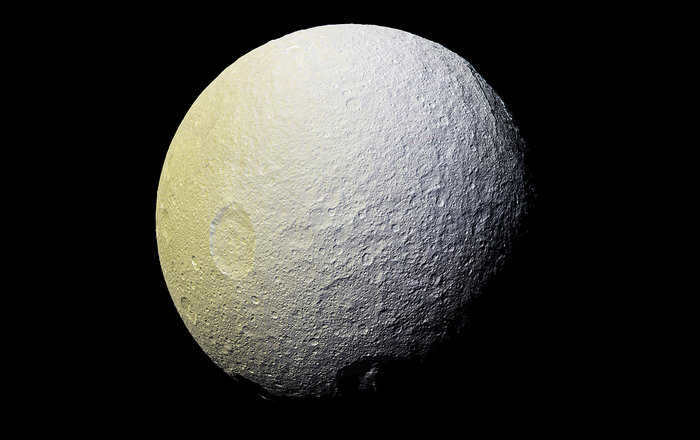
Mimas got its name from one of the titans from Greek mythology. It is a large celestial body with a diameter of 400 kilometers. Its shape is rounded, and it possesses a strong gravitational field. This characteristic of Mimas has an impact on the rings of the planet.
Enceladus is known for its small size, with a diameter of 50 kilometers. Its surface is covered in ice. Recent research has revealed the existence of a water fountain at the South Pole region.
Janus has a diameter of 195 kilometers and has an elongated shape. This celestial object completes a full orbit around Saturn in 17 days.
Tefia, composed of 90% ice, has a low density. It measures 1,060 kilometers in diameter and experiences temperatures as low as -187°C. Notably, the surface of Tefia is adorned with numerous craters and canyons.
Polydevk, a celestial object measuring 1.3 kilometers in diameter, orbits around Diona. Interestingly, Polydevk has the ability to approach the larger satellite at an angle of 39° and then veer away at an angle of up to 92°.
Telesto, an elongated satellite with a diameter of 24 kilometers, is characterized by a thin layer of ice and low gravity.
Calypso follows in the footsteps of Tefia and spans a diameter of 22 kilometers. Its shape is irregular and elongated, while its surface is marked by craters resulting from meteorite collisions.
Elena is situated within the gravitational field of Dione, causing her to track the trajectory of a larger celestial body. Dione possesses an asymmetrical shape and its surface is enveloped in a layer of ice. The core of this celestial body consists of solid rock.
The Influence of Satellites on the Configuration of Planetary Rings
Gravity is prevalent among the majority of Saturn’s satellites. Their movement within designated orbits has resulted in the creation of gaps within the planetary rings. Furthermore, the gravitational pull exerted by these objects influences the velocity at which the constituent elements of the rings travel. The motion of the satellites contributes to the generation of distinct waves in the regions between the gaps within the rings.





